Meeting of the Hawke's Bay Regional Council
LTP Submissions
Hearings
Date: Tuesday 22 May, Wednesday 23 May & Thursday 24 May 2018
Time: start time each day 9.00am
|
Venue:
|
Council Chamber
Hawke's Bay Regional Council
159 Dalton Street
NAPIER
|
Agenda
Item Subject Page
Decision Items
5. 2018-28
Long Term Plan Submissions Hearing Process 3
6. Financial
Overview 5
7. Regulation
Group of Activities 11
8. Land
Water and Biodiversity - Incentives to Change 23
9. Land
Water and Biodiversity - Partnerships for Change 95
10. Civil
Defence 157
11. Working
with Tāngata Whenua 213
12. Hawke's
Bay Tourism 277
13. Sustainable
Homes 417
14. Local
Government Funding Agency - LGFA 479
15. Regional
Assets Group of Activities 531
16. Integrated
Catchment Management Group of Activities 541
17. Strategic
Planning Group of Activities 559
18. Corporate
Services Group of Activities - including Rates Affordability 581
19. Submissions
Requesting Financial Assistance / Grants 625
20. Staff
Internal Submission to the 2018-28 Long Term Plan 629
HAWKE’S BAY REGIONAL COUNCIL
Tuesday 22 May 2018
SUBJECT 2018-28 Long Term Plan Submissions
Hearing Process
Reason for Report
1. To outline the process to be undertaken to hear and consider
submissions received on the 2018-28 Long Term Plan.
Background
2. Consultation on HBRC’s 2018-2028 Long Term Plan closed at
4.00pm on Monday 23 April 2018. A total of 569 submissions were received,
of which 91 submitters indicated they wish to present their submission in
person.
Verbal submissions
3. Submissions Hearings are scheduled to run from 9am Tuesday, 22 May
to 4pm Wednesday, 23 May 2018, with Council deliberations and decision-making
on Thursday 24 May. The Principal Governance Advisor is in the process of
contacting these submitters to arrange a suitable date/time. Submitters will
typically be given five to ten minutes to present, including questions and
answers, for individuals and groups respectively.
4. The timetable will be circulated separately once all submitters have
been confirmed.
5. A block of time will be set aside to hear submissions on the
Hawke’s Bay Tourism funding proposal. This part of the Hearing will be a
more informal forum. Submitters will be invited to attend and participate in
the forum without a fixed time allocated. HB Tourism will be
invited to lead the discussion followed by contributions from the sector. This
will ideally avoid repetition and allow more time for questions to enable ideas
to teased out with interested parties.
Deliberation Report
6. After all
verbal submissions have been heard, staff will consider the Deliberation
Reports and the Council staff internal submission. This is scheduled for
Thursday, 24 May.
7. The
Deliberation Reports are by topic. There is a Deliberation Report for each of
the seven key consultation topics, plus catch-all reports by Group (e.g.
Regulation, Strategic Planning, Regional Assets) and a report for all
miscellaneous requests for funding. In this way all submissions are covered.
8. Each
Deliberation Report has the relevant submissions and staff responses attached.
9. Council will be
asked to consider the submission points relating to the topic and any comments
made by Council officers; and to agree or not agree to the proposal as
consulted on through Facing Our Future 2018-28.
10. Staff will keep a running
action list during the 3 days to log any questions as they arise and will
endeavour to provide answers prior to decision-making. Staff will also
track the financial implications as decisions are made. These will be
preliminary until the financial model is finalised.
Adoption
11. Subsequent
to Council’s decisions on the submissions, the 2018-28 Long Term Plan
will be collated, incorporating incorporate any amendments necessitated by the
decisions made. Council will then adopt the final documents on 27 June 2018.
Post-adoption
12. Following
the adoption on 27 June, each submitter will receive a letter from Council
setting out Council's resolution(s) pertinent to their specific submission(s),
and the reasons for those resolution(s).
13. The Long
Term Plan documents will then be distributed within one month of the date of
adoption as required under Section 93 (10) of the Local Government Act 2002.
Decision Making
Process
14. Council
is required to make every decision in accordance with Part 6 Sub-Part 1, of the
Local Government Act 2002 (the Act). Staff have assessed the requirements
contained within this section of the Act in relation to this item and have
concluded:
14.1. Section 93(A) of the Act provides for the use of a special
consultative procedure in relation to the adoption of a Long Term Plan as
prepared under section 93 of the Act.
14.2. The issues to be considered in this paper are those issues raised by
members of the community that have submitted to the Council on the Consultation
Document “Facing Our Future 2018-28”. All submissions are an
integral part of the special consultative processes set out in Section 83 and 85
of the Local Government Act 2002.
|
Recommendations
That Council:
1. Agrees that the decisions to be made on issues submitted on
“Facing Our Future 2018-28” are made after the provisions
included in sections 83 and 85 of the Local Government Act 2002 have been
followed.
2. Receives and considers the verbal and written submissions.
|
Authored by:
|
Leeanne
Hooper
PRINCIPAL Governance ADVISOr
|
Drew Broadley
Communications Manager
|
|
Desiree Cull
Programme Leader
|
|
Approved by:
|
James Palmer
Chief Executive
|
|
Attachment/s
There are no
attachments for this report.
HAWKE’S BAY REGIONAL
COUNCIL
Tuesday 22 May 2018
Subject: Financial Overview
Reason
for Report
1. To provide the
Council with an overview of the 2018-2028 Long Term Plan (LTP) operational
financials, specifically those expenses which are included as ‘base level
services’ to implement Council’s step change proposals.
Background
2. Councillors
requested staff develop an ambitious 2018-2028 Long Term Plan, which would
deliver demonstrable and accelerated positive change in the Hawke’s Bay
environment within the next 10 years.
3. The first stage
of the LTP financial analysis was to address an existing 2015-2025 LTP budget
shortfall for the coming 2018/19 year of $2.3 million, which had occurred as
result of forecast investment returns on the failed Ruataniwha Water Storage
Scheme not being realised.
4. This review
explored and challenged the basis for current rating policies, existing user
charges and fees, investment returns from HBRC’s balance sheet assets
(via the Capital Structure Review), Port of Napier Ltd dividend negotiations,
funding the ‘gap’ with short term borrowing, and alternatives to
commercial bank lending such as the Local Government Funding Agency to provide
access to lower interest rates.
5. An analysis of
all existing project expenditure was also undertaken to review
the relevance of existing projects and identify changes necessary to the scope
of activities, timing, resources and funding required over the LTP to achieve
the desired outcomes. This pinpointed opportunities for staff and
Council to prioritise existing spend on merit, alignment to strategic
priorities and against other business needs.
6. The review also
focused on Council’s internal efficiencies, and ensuring cost savings
were made where possible and that operations are delivered in the most
cost-effective manner, resulting in $500k of cost savings.
7. Business cases
were then developed for new activity, with a focus on land and water management
and biodiversity, with material benefits for terrestrial, freshwater and marine
environments. Business cases were also developed to do more in the areas of
Sustainable Homes, Civil Defence and to build on community partnerships
including with Tangata Whenua.
8. A decision to
refocus on Council’s core activities resulted in the proposal to reduce
the funding for Hawkes Bay Tourism by $300k per annum over 3 years, which
returns the funding to its original value of $920k per annum in year 4.
9. Given the scale
of investment required to achieve a step change in the impact of Council
operations, the challenge for Council is to fund its new strategic agenda
whilst maintaining a balanced operating budget and also giving consideration to
the affordability of its plans for ratepayers.
10. Fundamentals of the new
financial strategy include an increasing emphasis on user pays, a more
aggressive investment strategy, and borrowing to front load funding of
initiatives which future generations will benefit from.
Financial and Resource
Implications
|
|
|
Additional
spend
|
|
|
Yr1 %
2018-19
|
Yr1 $’000
2018-19
|
Yr2 $’000
2019-20
|
Yr3 $’000
2020-21
|
Cumulative over 3 years
|
|
Incentives to Change
|
1.9%
|
$366
|
$578
|
$1,115
|
$2,059
|
|
Partnerships for Change
|
4.7%
|
$894
|
$994
|
$994
|
$2,882
|
|
Regulation
|
2.9%
|
$564
|
$1,325
|
$1,596
|
$3,485
|
|
Civil Defence
|
5.2%
|
$990
|
$990
|
$990
|
$2,970
|
|
Tangata Whenua
Engagement
|
2.0%
|
$384
|
$384
|
$384
|
$1,152
|
|
Base level services
|
2.3%
|
$441
|
$816
|
$1,473
|
$2,730
|
|
Total rates increase
|
|
$3,639
|
$5,087
|
$6,552
|
$15,278
|
|
Movement from
previous year
|
|
$3,639
|
$1,448
|
$1,465
|
|
|
Total rating impact
from previous year
|
19.0%
|
19.0%
|
6.4%
|
6.1%
|
|
11. The financial impact of
the total package of initiatives proposed in the consultation document, results
in a 19% increase in total rating in Year 1, with increases of 6.4% and 6.1% in
years 2 and 3. Total new revenue collected through rates, which has the
most significant impact on ratepayers, exceeds $15m over the first 3 years.


12. Significant investment
will also be funded from borrowing. This LTP includes a forecast of $71m in
borrowing over the ten years. This aligns with Councils financial
strategy to leverage the balance sheet which currently has very low debt
($23m), to front load and fund initiatives which future generations will
benefit from. Council has consulted on joining the Local Government
Funding Agency which would provide access to lower interest rates, and in turn
provide savings on interest payments on the forecast borrowing to ratepayers.


13. Whist borrowing is
significant, forecast debt levels remain moderate. After repayments debt
will increase to $38m by year ten of the plan. This equates to 6.8% of
equity which is still relatively conservative and well below our debt limit of
28%.
Base-line /Support Staff
14. This LTP, which signals a
step change in direction and activity for the HBRC, will require more
operational staff, the tools they need to do their job and administrative
support to enable delivery.
15. In this plan, we forecast
up to a 15% increase in staff in year 1 to deliver on the activities consulted
on. The majority of these staff are operational, on the ground and out in
the field, however this plan does also include a scaling up of support staff to
enable the increase in activity.
16. The base-line increase of
2.3% covers new corporate services and support staff, salary inflation and
performance increases, recruitment costs, new vehicles for additional field
staff and costs related to providing office space to house the larger
workforce. This additional expense is partially offset by the proposed
reduction in HBT. It also includes a coastal hazard rate for
Napier/Hastings to align the cost of this activity to those who benefit
most. This is a new rate to fund Council’s ongoing involvement in
the Coast Hazards Joint Committee, which was previously funded out of the
general rate.
17. A number of key new
positions have been included in corporate services, including a senior finance
position, which will increase the capability of the finance team and allow for
a greater focus on financial reporting and analysis, internal treasury
management, and to support the organisation as it grows in size and
complexity. Other planned new hires include a significant but necessary
investment in the human resources function (1.5), ICT (2), communications (.7)
and corporate support (.5).
18. In addition to planning
for these new positions, an organisational wide restructure has taken place,
which has better aligned teams to work more collaboratively and with shared
common capability, and provided an appropriate structure that supports stronger
project management and the move to an integrated catchment approach.
19. As a result of the
restructure a new cost centre called the Office of the CE and Chair
‘OCEC’ has been created to specifically support the Chief
Executive, Chair and governors and acknowledges the scale of growth and reach
required by the CE. This will also enable a focus on more rigorous
performance monitoring and reporting of outputs and outcomes from across the
organisation to councillors and the public with the proposed appointment of a
Principal Advisor Performance and a manager of the OCEC. Tighter and more
proactive management of information and advice to councillors, as well as media
and internal communications, are also proposed for the OCEC.
20. Currently the Dalton
Street office is at capacity within the existing layout. Given the
proposed growth in staff we have included both a short and longer term solution
to accommodation requirements in the LTP. A short term lease of 2+1 years
on office space in Station Street which will accommodate up to 25 staff and
allow for some reconfiguring of the Dalton street office to a more open plan
design. A placeholder of $3m has been included in Year 3 of this LTP for
a more permanent solution and a project to review a number of options,
including the possibility of expanding the depot at Guppy Road, will be
developed and presented to Council for consideration in due course.
Provisions have been made for minor refurbishments to provide suitable
accommodation for the expected growth in Waipawa and Wairoa.
Officers’
Analysis
21. This LTP is premised on
significant additional public investment and in turn placing a financial demand
on the community. In response, Council is accountable for delivering on its
promises. Good public accountability requires Council’s vision and
community expectations to be clearly and directly linked to a well-balanced
performance framework. The community need to be better able to assess the
progress being made towards those goals, and the value for money they receive
from rates and other charges they pay. The Executive Leadership Team have
arranged the operating model of the organisation to meet this challenge and
placed additional emphasis on performance and accountability, which are key organisational
values adopted in the 2017-2021 Strategic Plan.
22. Whilst a significant
number of new staff have been budgeted for to ensure the organisation is
appropriately resourced to execute the LTP, financial pressures from external
factors, most noticeably salary inflation, will need to be monitored closely to
ensure expenditure remains within budget. Salary inflation has been
budgeted at 2%, which was in-line with early expectations, however the most
recent Strategic Pay survey information indicates salary inflation is
approximately 2.5% on average across the local government sector. In
light of the proposed increase in rates the Executive Leadership Team have
agreed to maintain the 2% budgeted allocation and to apply a disciplined
approach to managing the overall payroll expense.
23. A shift towards greater
de-centralising of staff and an expanded presence across the region with more
staff based in Waipawa and Wairoa puts a greater demand on centrally located
support staff. These staff provide services such as fleet and facilities
management, HR and IT support. This LTP sees the HBRC located across 6
facilities with an increased number of field staff.
24. Staff believe they have
developed a plan that can deliver on the Council’s strategic objectives,
but this will require an ongoing focus on delivery and better management of
staff and resources. As a percentage of total Council spend, internal
support staff including the Executive Leadership Team, HR, ICT, finance and
external relations represents 9.4% of total expenditure in Year 1 of the LTP,
but reduces to 9% in year 3 against planned growth in the organisation.
Currently these costs are 8.6% of total spend. Staff believe this additional
investment is needed to provide the support mechanisms for the stronger
organisational performance, maturity and accountability required for Council to
successfully respond to the challenges it faces. Growing the
organisation’s frontline capability without additional investment in
internal support would create unacceptable risks in areas such as financial
management and reporting, staff support, health and safety, information
technology and security, and quality of service delivery.
Additional Funding Requests
25. The following tables are
additional funding requests which have not been taken into account in the
analysis and commentary of this paper. These further requests for funding will
be in addition to those initiatives consulted on in the consultation
document. The impact to ratepayers of this funding is included in the
tables below.
26. Staff proposals as a
result of submissions are:
|
|
Additional
spend
|
|
|
Yr1
2018-19
|
Yr2
2019-20
|
Yr3
2020-21
|
Cumulative over 3 years
|
|
Coastal permit for
re-nourishment of Westshore Beach - Project 322 (General Fund)
|
$25,000
|
$25,000
|
-
|
$50,000
|
|
Waikato Regional
Council’s joint fish passage initiate - Project 288
(Targeted rate – HP Scheme)
|
$30,000
|
$30,000
|
$30,000
|
$90,000
|
|
Total rating impact
$
|
$55,000
|
$55,000
|
$30,000
|
$140,000
|
|
Total rating impact
%
|
0.29%
|
0.23%
|
0.10%
|
|
27. Funding requests received
through the consultation process that Councillors will consider are:
|
28.
|
Additional
spend
|
|
|
Yr1
2018-19
|
Yr2
2019-20
|
Yr3
2020-21
|
Cumulative over 3 years
|
|
Coastguard Eastern
Region
|
$10,000
|
$10,000
|
$10,000
|
$30,000
|
|
Waiohiki Marae Board of
Trustees
|
$12,984
|
$21,844
|
$21,094
|
$55,922
|
|
Cranford Hospice
|
$173,125
|
$291,250
|
$281,250
|
$745,625
|
|
Total rating impact
($)
|
$196,109
|
$323,094
|
$312,344
|
$831,547
|
|
Total rating impact
(%)
|
1.03%
|
1.35%
|
1.14%
|
|
Decision
Making Process
29. Staff have assessed the
requirements of the Local Government Act 2002 in relation to this item and have
concluded that, as this report is for information only, the decision making
provisions do not apply.
|
Recommendations
That the
Hawke’s Bay Regional Council receives and notes the “Financial
Overview” staff report.
|
Authored by:
|
Jessica
Ellerm
Group Manager
Corporate Services
|
|
Approved by:
|
James Palmer
Chief Executive
|
|
Attachment/s
There are no
attachments for this report.
HAWKE’S BAY REGIONAL
COUNCIL
Tuesday 22 May 2018
Subject: Regulation Group of
Activities
Reason for Report
1. To provide the
Council with an analysis of submissions received in relation to the
“Regulation” group of activities through the Facing our Future
2018-28 Long Term Plan consultation period.
Background
2. In order to
achieve desired environmental improvements and encourage significant changes in
environmental behaviour HBRC recognises that it needs to provide not only
incentives for good actions but also continue to provide deterrents for
negative actions or non-actions.
3. The regulatory
arm of HBRC encompasses both the issuing of consents, and the monitoring of
those consents and enforcement of compliance with conditions. HBRC
currently has over 4000 resource consents on its books.
4. Increased regulation
through amendments to the Regional Resource Management Plan (RRMP) and as a
result of central government requirements means that more people are required
in the Consents Team to ensure that statutory timeframes for decisions on
consents are met.
5. Increased
community expectations around dealing with unauthorised environmental
activities (including pollution) also necessitates further investment in staff
to ensure that complaints can be followed up promptly, that priority is given
to the monitoring of high impact potential non-compliance, and that appropriate
mediation or enforcement measures can be followed up.
6. The regulation
arm of Council is supported by both planning and science. Collectively it is
proposed that these three parts of Council be provided with greater capacity to
speed up the changes sought to the environment.
7. No specific
option was consulted upon in the Long Tem Plan as the status quo is not an
option.
Submissions Received
8. 25 submissions
were received on this topic (see attached).
9. Key themes
expressed by submitters included:
9.1. Support for
greater attention to key role of protecting and enhancing the region, and
increased regulatory support
9.2. Require the
polluter to pay not the ratepayer
9.3. Concern that
too strong a “stick” may have unintended consequences
9.4. Several
submissions specifically opposed water bottling
9.5. Opposition to
increase in costs to cover increased regulation
9.6. A reminder of
HBRC’s obligations under the Hazardous Substances and New Organisms Act
1996
9.7. Several
submissions detailed activities for further focus:
9.7.1. Forestry
slash
9.7.2. Irrigation
from groundwater
9.7.3. Dumping of
material in riverbeds
9.7.4. Ahuriri
Estuary/Pandora Pond
9.8. Submissions
on consent processes including:
9.8.1. That all
resource consents be publically notified
9.8.2. That all
objections to resource consents must be received within specified time limits
and limited to those directly affected.
Officers’ Analysis of Submissions
10. Regulatory activities align
with HBRC’s priority areas of water quality, safety and certainty, and
smart, sustainable land use. This underpins HBRC’s desire for all of its
water users to have knowledge on what water is available to meet their needs
and ensuring our aquatic ecosystems are monitored and reported on for the
benefit of the community.
11. Regulation is a statutory
activity under the Resource Management Act. In the case of resource consents
applicants have responsibilities but also have legal rights under the process.
There are a range of provisions within the Act that limit the ability of HBRC
to require full public notification of activities or to modify time limits.
12. Consents and compliance
activities have significant roles to play in the management of some of HBRC’s
key risks – for example, human health impacts from the contamination of
drinking water and the risk of a contaminated site affecting an aquifer.
13. These activities have a
continually growing workload and the purpose of the Long Term Plan is to ensure
that they are adequately resourced to respond to this workload:
13.1. The Consents Team
requires additional personnel to process the increased number of resource
consents that are arising from the expiry of existing consents including in the
TANK catchments, new consents as a result of Plan Change 6 (the Tukituki
catchment) and new consents required because of the new National Environment
Standards for Plantation Forestry (NES-PF).
13.2. The Compliance Team
requires additional personnel to adequately monitor its current and anticipated
workload. An increase in reported pollution incidents of 95% over the past five
years has necessitated a new fulltime staff member to assist in responding to
these. In addition to an increasing number of consents to be monitored for
compliance the contamination of the Havelock North public drinking water
network highlighted the need for HBRC to carry out additional inspections of
bores, as well as compliance with the NES-PF.
14. Applicants for resource
consents are required to pay the full (100%) costs incurred in obtaining their
consents from HBRC. Similarly the costs of consent monitoring are recoverable
from the consent holder. Costs incurred beyond that, e.g. in the Environment
Court, may not be fully recovered.
15. Overall the Regulation
team is charged by Council with recovering 80% of its project costs in the new
Long-Term Plan.
16. In its assessment of risks
to the organisation HBRC has identified the risk of contamination of freshwater
from hazardous substances sorted on contaminated sites as an area that
continues to require strong oversight by the Council. In addition to
maintaining a register of contaminated sites (the HAIL database) HBRC will look
to use part of the additional resources sought for compliance work to further
advance the ongoing management of at-risk sites.
17. Several specific matters
raised in submissions are covered as follows:
17.1. Water bottling –
the prohibition of this would necessitate a change to the HBRC Resource
Management Plan and would go through a plan change process before having
effect. Similarly charging for the water taken for water bottling requires a
law change.
17.2. Activities for further
focus – where activities such as those referred to in various submissions
and listed in para 9.6 occur the degree of response from HBRC will depend in
some part on the nature of the offence, the level of evidence to support proof
of an offence, and the degree to which the activity is a breach of a rule,
resource consent condition or national environment standard.
Financial and Resource Implications
18. The financial impacts of
the preferred option are:
|
|
Additional
spend
|
|
|
Yr1
2018-19
|
Yr2
2019-20
|
Yr3
2020-21
|
Cumulative over 3 years
|
|
Additional staff
|
$320,000 4FTE
2 compliance
2 consent
Staff
|
$240,000 3FTE
2 compliance
staff
|
-
|
$1,440,000
|
|
Additional fees and
charges (income)
|
($256,000)
|
($192,000)
|
-
|
($1,152,000)
|
|
Net cost
|
$64,000
|
$48,000
|
|
$288,000
|
|
Total rating impact
|
0.3%
|
0.2%
|
|
|
Decision Making
Process
19. Council
is required to make every decision in accordance with Part 6 Sub-Part 1, of the
Local Government Act 2002 (the Act). Staff have assessed the requirements
contained within this section of the Act in relation to this item and have
concluded:
19.1. Section
93(A) of the Act provides for the use of a special consultative procedure in
relation to the adoption of a Long Term Plan as prepared under section 93 of
the Act.
19.2. The issues to be
considered in this paper are those issues raised by members of the community
that have submitted to the Council on the Consultation Document “Facing
Our Future 2018-28”. All submissions are an integral part of the special
consultative processes set out in Section 83 and 85 of the Local Government Act
2002.
|
Recommendations
That the
Hawke’s Bay Regional Council:
1. Receives and notes the “Regulation
Group of Activities” staff report.
2. Considers the submission points made relating to “Regulation” and any comments made by
Council officers.
3. Agrees to a 2.9% increase in rates for 2018-19 to cover increased
costs in Regulation (planning, consents, compliance and science) as consulted
on through Facing Our Future 2018-28
Or
4. Does not agree to a 2.9% increase in rates for 2018-19 to cover
increased costs in Regulation (planning, consents, compliance and science) as
consulted on through Facing Our Future 2018-28
|
Authored by: Approved
by:
|
Liz Lambert
Group Manager
External Relations
|
James Palmer
Chief
Executive
|
Attachment/s
|
⇩1
|
Submitter
Comments made relating to Regulation Group of Activities
|
|
|
|
Submitter
Comments made relating to Regulation Group of Activities
|
Attachment 1
|







HAWKE’S BAY REGIONAL COUNCIL
Tuesday 22 May 2018
Subject: Land Water and
Biodiversity - Incentives to Change
Reason for Report
1. To provide the
Council with an analysis of submissions on the “Incentives to
Change” proposal to fund farm plans, riparian and reforestation
initiatives through borrowing as consulted on in the Facing our Future
2018-28 Long Term Plan consultation document.
Background
2. Incentives to
Change was one of the seven key consultation topics Council sought public
submissions on through the Facing our Future 2018-28 consultation document. As
shown in the following extract from the consultation document, Council’s
preferred option was to borrow $35M over 10 years to:
2.1. Speed up Farm
Plan completion by removing the up-front costs to landowners in the form of an
interest free loan, and
2.2. Fund riparian
fencing, planting and maintenance of planted areas and plant trees
(reforestation) on highly erodible land unsuitable for commercial forestry.

Financial and Resource Implications
3. The financial
impacts of these initiatives are:
|
|
Additional
spend
|
|
|
Yr1
2018-19
|
Yr2
2019-20
|
Yr3
2020-21
|
Cumulative over 3 years
|
|
Farm plans
|
$102,000
|
$116,000
|
$139,000
|
$357,000
|
|
Riparian and
reforestation
|
$264,000
|
$462,000
|
$976,000
|
$1,702,000
|
|
Total for Incentives
to Change
|
$366,000
|
$578,000
|
$1,115,000
|
2,059,000
|
|
Total rating impact
|
1.9%
|
0.9%
|
2.2%
|
5%
|
4. The other
option provided in the consultation document was the status quo, which had no
additional spend or impact on rates or debt. Under the status quo, farm plans
and riparian/reforestation initiatives will occur but at a much slower rate,
relying on landowners and backed by regulation.
Submissions Received
5. A total of 373
submissions (attached) were received on this consultation topic. Of those submitters who clearly specified an option,
233 of the submitters supported Option 2 (Council’s preferred
option – to fully fund); and 128 preferred Option 1 (the status quo). This
equates to 64.5% for the proposal and 35.5% for the status quo (no additional
spend).
6. Key themes or
unique points expressed by submitters included:
6.1. The majority
of those in support of the proposal noted that the scale and pace proposed was
required to deal with the challenges.
6.2. A large
portion of those opposed to the proposal were concerned about equity and who
pays for this work. The theme of ‘polluter pays’ was common.
6.3. A smaller
group of those opposed considered the pace of change was unwarranted and that
the current pace was sufficient.
6.4. Some of those
opposed considered insufficient evidence had been presented to demonstrate a
problem that required the proposed response.
6.5. A mixture of
those in support and opposition considered that additional regulation was
required either in place of the proposal or to support it.
6.6. Some
considered that we should be making great efforts to secure central Government
funding.
6.7. Support for
Council’s proposed science investment.
Officers’
Analysis of Submissions
7. The primary
issue for those opposed to the proposal was the equity of where the costs fell
and a view that those creating the problem (landowners) should carry the full
cost of remediation. This issue is central to the approach proposed by
Council. The proposal seeks to address the effects of activities that
were created many decades ago, often under taxpayer-funded incentives during a
phase of land clearance and development. The benefit of hindsight now
tells us that many of the choices about which areas of land to clear were
unwise from a sustainable land management perspective, but at the time were
accepted and encouraged by successive governments. Relatively recent
developments in our understanding of the drivers of water quality and impacts
on things like sediment on our freshwater and marine environments has shifted
community expectations about how land should be managed. Given the
historic or legacy nature of these issues it is equally inequitable to expect
the rural community to now solely pay to rectify the issues created
historically. Staff support an approach that has both urban and rural
ratepayers contributing to the cost of the programme.
8. It is clear
that those in support like the scale and pace that is proposed for this
work. There is a recognition that the sheer scale of the challenge
requires a significant shift back to more historical levels of investment that
were enjoyed under the previous Catchment Board regime. There is also an
acknowledgement that the approach proposed to engage directly and work one on
one with landowners is appropriate and likely to be more successful than
regulation alone.
9. There is an
alternate view on the speed of change in that some consider the scale and space
to be unwarranted or unnecessary. They consider that there is progress
occurring and that this is sufficient to match expectations and to halt and
manage water quality declines. Staff do not support this view
10. A few submitters
challenged the evidence base for this proposal indicating that the science was
not ‘done’ or that they could not see a link between the issue and
the proposed approach. Staff consider that no further science investment
is required to understand the nature or scale of the issues. Council has
invested significantly in recent years in land science and ecological programmes
that form the basis for this proposal. The entire region has been
modelled using the Landcare Research SedNet soil erosion model and this has
been instrumental in understanding the current effects of land clearance as
compared to historical scenarios. We have also invested in Zonation
investigations to understand where the high value ecological sites are that
will be targeted for protection or restoration. It is acknowledged that this
programme is not intending to drive catchments back to pre-human levels of soil
loss but to significantly reduce the anthropogenic load that is detrimentally
impacting both our freshwater and marine environments. Ultimately, the
final goals for each catchment will be developed in collaboration with the
catchment communities to reflect the balance required between a working
landscape and an acceptable level of protection of terrestrial, freshwater and
marine values.
11. Some submitters advocate
either new regulation to replace the proposed approach or new regulation in
support of this approach. Regulation through national and regional policy
is continually under development. Council continues to invest
significantly in its policy development programme. Regulation is not
required to support or direct this programme. Council has a sufficiently
deep understanding of the issues and drivers to allow it to begin this
programme and address known issues. Regulation in time will support this.
12. Some submitters advocate
engagement with central government in this programme for financial
assistance. Staff agree this is important and so are already deeply
engaged with various government ministries to leverage support into the
programme. Leverage of available funding is only possible with Council
investment.
13. Staff note several submitters
supported the investment in science and monitoring to support Council’s
integrated package of work.
Decision Making Process
14. Council
is required to make every decision in accordance with Part 6 Sub-Part 1, of the
Local Government Act 2002 (the Act). Staff have assessed the requirements
contained within this section of the Act in relation to this item and have
concluded:
14.1. Section
93(A) of the Act provides for the use of a special consultative procedure in
relation to the adoption of a Long Term Plan as prepared under section 93 of
the Act.
14.2. The issues to be
considered in this paper are those issues raised by members of the community
that have submitted to the Council on the Consultation Document “Facing
Our Future 2018-28”. All submissions are an integral part of the special
consultative processes set out in Section 83 and 85 of the Local Government Act
2002.
|
Recommendations
That the
Hawke’s Bay Regional Council:
1. Receives and notes the “Land Water and Biodiversity -
Incentives to Change” staff report.
2. Considers the submission points made relating to the
“incentives to change’ proposal and any comments made by Council
officers.
3. Agrees to include borrowing of $35M over 10 years in the 2018-28
Long Term Plan, to provide incentives to change in the form of interest free
loads for Farm Plans and subsidies for riparian and reforestation as
consulted on through Facing Our Future 2018-28
Or
4. Does not agree to the inclusion of borrowing for incentives.
|
Authored by: Approved
by:
|
Iain Maxwell
Group Manager
Resource Management
|
James Palmer
Chief
Executive
|
Attachment/s
|
⇩1
|
Incentives to
Change LTP Topic Submissions
|
|
|
|
Incentives
to Change LTP Topic Submissions
|
Attachment 1
|




































































HAWKE’S BAY REGIONAL COUNCIL
Tuesday 22 May 2018
Subject: Land Water and
Biodiversity - Partnerships for Change
Reason for Report
1. To provide the
Council with an analysis of submissions on the “Partnerships for
Change” proposal to support the establishment and operation of an
independent farmer and grower-led initiative to lead on-farm research and
innovation, and to provide additional funding for implementation of the HB Biodiversity
Action Plan and Regional Pest Management Plan as consulted on in the Facing
our Future 2018-28 Long Term Plan consultation document.
Background
2. Partnerships
for Change was one of the seven key consultation topics Council sought public
submissions on through the Facing our Future 2018-28 consultation
document (as shown in the following extract from the consultation
document):

Financial and Resource Implications
3. The financial
impacts of these initiatives are:
|
|
Additional
spend
|
|
|
Yr1
2018-19
|
Yr2
2019-20
|
Yr3
2020-21
|
Cumulative over 3 years
|
|
Future Farming
|
$150,000
|
$250,000
|
$250,000
|
$650,000
|
|
Biodiversity &
Biosecurity
|
$744,000
|
$744,000
|
$744,000
|
$2,232,000
|
|
Total for
Partnerships for Change
|
$894,000
|
$994,000
|
$994,000
|
$2,882,000
|
|
Total rating impact
|
4.7%
|
0.4%
|
0%
|
|
4. The other
option provided in the consultation document was to maintain the status quo.
Submissions Received
5. A total of 371
submissions (attached) were received on this consultation topic.
6. Of those submitters who clearly specified an option,
241 of the submitters supported Option 2 (Council’s preferred
option – to fully fund); and 117 preferred Option 1 (the status quo). This
equates to 67.3% for the proposal and 32.7% for the status quo (no additional
spend).
7. Key themes or
unique points expressed by submitters included:
7.1. The majority
of those in support of the proposal noted that the scale and pace proposed was
required to deal with the challenges.
7.2. A large
portion of those opposed to the proposal were concerned about equity and who
pays for this work. The theme of ‘polluter pays’ was common.
7.3. A smaller
group of those opposed considered the pace of change was unwarranted and that
the current pace was sufficient.
7.4. Some
submitters questioned Council efficiency and were asking if all steps have been
taken to fund the work from existing budgets.
7.5. Concerns were
raised about the ability to manage deer and goats within the newly planted
areas.
7.6. Some
submitters raised concerns with the Future Farming Trust (FFT) and were asking
that the funding be reallocated to support tourism.
Officers’
Analysis of Submissions
8. As with the
Incentives for Change section, the primary issue for those opposed to the
proposal was the equity of where the costs fell and a view that those creating
the problem (landowners) should carry the full cost of remediation. This
has been addressed in the ‘Land Water Biodiversity – Incentives for
change’ paper within this agenda.
9. It is clear
that those in support like the scale and pace that is proposed for this
work. There is a recognition that the sheer scale of the challenge
requires a significant shift back to more historical levels of investment that
were enjoyed under the previous Catchment Board regime. There is also an
acknowledgement that the approach proposed to engage directly and work one on
one with landowners is appropriate and likely to be more successful than
regulation alone.
10. There is an alternate view
on the speed of change in that some consider the scale and space to be
unwarranted or unnecessary. They consider that there is progress
occurring and that this is sufficient to match expectations and to halt and
manage water quality declines. Staff disagree and have the view that the
scale and pace of change has been significantly short of what is required to
make a meaningful impact on water quality and to protect our most vulnerable
soils. Staff consider that Council has a large body of biophysical
science that confirms that.
11. Council will be aware that
there have been a number of recent reviews that have positively contributed to
the efficiency of Council’s operations. Staff do not consider that
there is any further gain to make here that would be sufficient to realise the
required level of funding. If the funding was to be provided within
existing budgets Council would need to undertake a line by line review of
projects and make choices about what work it wished to cease to release the
funding.
12. There have been a number
of submitters concerned about the impact of grazing pest animals on revegetated
areas. This is a valid concern. Staff do not consider that this
prevents the proposal proceeding. Staff are working on a grant policy
design that will look to ensure existing Regional Pest Management Strategy (RPMS)
tools are fully utilized and also to ensure that the landowner obligations are
clear on the control of plant and animal pests. Staff also note that the
current RPMS has enhanced rules specifically for goat control and additional
resource for the implementation of this is included with the proposed LTP.
13. Submitters raise a number
of concerns with the FFT:
13.1. That the FFT was going
to be a body that told them how to farm
13.2. That the FFT would be a
group of people to whom the mainstream farming population would not engage
14. Council is reminded that
the proposal was for an independent farmer and grower led initiative. Staff are
of the view that therefore that the FFT will by necessity require a
self-selection process that ensures the people on the trust are leaders in the
farming community and who will identify with the broad landowner interests
across the region. Staff are also of the view that the FFT should be
given clear deliverables Council wishes to see from its work and a clear understanding
that the funding provided within the proposed LTP is a ‘one off’
and that after the end of the three year LTP cycle the FFT will needed to have
secured sufficient ongoing financial support to maintain its operations without
ongoing Council funding support. Staff would also suggest that the
FFT be asked to present a three year business plan that demonstrates both the
delivery of Council’s deliverables as well as ensuring that the FFT does
not compete with or duplicate existing groups like it.
Decision Making Process
15. Council
is required to make every decision in accordance with Part 6 Sub-Part 1, of the
Local Government Act 2002 (the Act). Staff have assessed the requirements
contained within this section of the Act in relation to this item and have
concluded:
15.1. Section
93(A) of the Act provides for the use of a special consultative procedure in
relation to the adoption of a Long Term Plan as prepared under section 93 of
the Act.
15.2. The issues to be
considered in this paper are those issues raised by members of the community
that have submitted to the Council on the Consultation Document “Facing
Our Future 2018-28”. All submissions are an integral part of the special
consultative processes set out in Section 83 and 85 of the Local Government Act
2002.
|
Recommendations
That the
Hawke’s Bay Regional Council:
1. Receives and notes the “Land Water and Biodiversity -
Partnerships for Change” staff report.
2. Considers the submission points made relating to the
“Partnerships for Change’ proposal and any comments made by
Council officers.
3. Agrees to fund the ‘Future Farming’, biodiversity and
biosecurity initiatives as consulted on through Facing Our Future 2018-28.
Or
4. Does not agree to fund the ‘Future Farming’,
biodiversity and biosecurity initiatives as consulted on through Facing Our
Future 2018-28.
|
Authored by:
|
Iain Maxwell
Group Manager
Resource Management
|
|
Approved by:
|
James Palmer
Chief Executive
|
|
Attachment/s
|
⇩1
|
Partnership
to Change LTP Topic Submissions
|
|
|
|
Partnership
to Change LTP Topic Submissions
|
Attachment 1
|


























































HAWKE’S BAY REGIONAL COUNCIL
Tuesday 22 May 2018
Subject: Civil Defence
Reason for Report
1. To provide the
Council with an analysis of submissions on the “Civil Defence”
proposal take responsibility for collecting a Regional Rate for Civil Defence
as consulted on in the Facing our Future 2018-28 Long Term Plan
consultation document.
Background
2. Civil Defence
was one of the seven key consultation topics Council sought public submissions
on through the Facing our Future 2018-28 consultation document. As shown
in the following extract from the consultation document, Council’s
preferred option was to:
2.1. Take
responsibility for collecting a single regional rate for Civil Defence.

Financial and Resource Implications
3. The financial
impacts of this initiative are:
|
|
Additional
spend
|
|
|
Yr1
2018-19
|
Yr2
2019-20
|
Yr3
2020-21
|
Cumulative over 3 years
|
|
Total for Civil
Defence
|
$1M
|
|
|
$1M
|
|
Total rating impact
|
5.2%
|
0%
|
0%
|
|
4. The other
option provided in the consultation document was the status quo, which has no
additional spend or impact on rates or debt for HBRC. Under the status quo, the
Territorial Authorities in Hawke’s Bay (Wairoa, Napier, Hastings and
Central Hawke’s Bay councils) will continue to rate their residents and
be invoiced by HBRC for their share of civil defence work.
Submissions Received
5. A total of 362
submissions were received on this consultation topic (see attached). Of those submitters who clearly specified an option,
242 of the submitters supported Option 2 (Council’s preferred
option – to transfer to HBRC); and 106 preferred Option 1 (the status
quo). This equates to 69.5% for the proposal and 30.5% for the status quo
(retain with each TA).
6. Key themes
expressed by submitters included:
6.1. Concerns over
the HBRC control of Hawke’s Bay Civil Defence Emergency Management (CDEM)
and loss of local control.
6.2. Concerns that
there will be no corresponding reduction in TLA rates.
6.3. Expression
that CDEM is currently working well and there is no need for change.
Officers’
Analysis of Submissions
7. As mentioned in
the proposal, Hawke’s Bay CDEM Group is currently being managed by taking
a shared service approach which is consistent with the intent of the CDEM Act
2002. The CDEM Group is governed by all of the five Hawke’s Bay
councils as equal partners through the Joint Committee made up of the HBRC
Chair and the TLA mayors. The Joint Committee is supported by the
Coordinating Executives Group (CEG) who are made up primarily of the:
7.1. Local
Authority Chief Executives,
7.2. Police
Eastern District Commander,
7.3. Fire and
Emergency NZ Hawke’s Bay Commander,
7.4. CEO
Hawke’s Bay DHB, and
7.5. MSD Regional
Director.
8. The HBRC is but
one participant in the governance and management of Hawke’s Bay CDEM,
however it does have an existing mandated role as the administrating
authority. As such the Group office (or full-time CDEM staff) are employed
by the HBRC. Each TLA has an assigned and imbedded CDEM staff
member who acts as a local subject matter expert and provides initial support
in an emergency. These embedded staff also work within their specific
area of expertise across the Hawke’s Bay Group.
9. Under the
governance of the Joint Committee, the CEG set the Group work programme.
This includes projects which deliver across the region and projects which are
delivered at a district or individual community level.
10. This structure acknowledges
that while Hawke’s Bay CDEM is best managed and resourced centrally,
where appropriate there still needs to be local delivery. This approach
also allows for securing specialist staff expertise, which would not normally
be available to individual local authorities.
11. Some submitters have also
raised concerns about the local level of service reducing, particularly in the
smaller TLAs. Prior to taking a shared service approach smaller councils
usually had half a full time equivalent working on CDEM. This changed in
2012 with the HBRC through the CDEM Group funding these positions to full
time.
12. In the last 18 months a
more regional approach has been embedded with staff working under one dedicated
organisation. The level of service for smaller councils has increased with
access to all of the expertise in the Group office. The funding
arrangements however, have not changed.
13. By bringing the funding
for CDEM under one rate this will further enable expertise and resources to be
used in an effective way which benefits the entire region and individual
councils. Furthermore, by increasing the transparency of the CDEM funding
and identifying efficiencies, additional capability in the Public Information
Management and Education area can be provide for.
14. The reduction of TLA Rates
as a result of this proposal has been raised as an issue by some
submitters. While individual councils are responsible for their level of
rating, each of the TLAs have identified the amount of money they will be
saving from this proposal and if this will be returned as a saving to the
ratepayer or not. All TLA LTPs propose a rate increase for matters other
than CDEM.
15. The key point is there is
no increase in overall CDEM funding across the region, it is the distribution
of the rating that has changed.
16. Some submitters have
expressed that Hawke’s Bay CDEM is currently working well and there is no
need for change. In 2011, Hawke’s Bay CDEM was rated in the bottom
three CDEM Groups in NZ by a Ministry of Civil Defence Emergency Management
sponsored national capability assessment. In 2012 the Joint Committee and
CEG decided additional resourcing was needed, complimented by a more regional
approach through a strengthened Group office. As a result steady progress
has been made in consolidating this activity to the point where the
Group’s capability and coordination in response and work across community
resilience is now having a positive impact.
17. The shared service
approach to regional CDEM has developed to the point where good progress has
been made, increasing the overall resilience of the Hawke’s Bay
community. This proposal to consolidate CDEM funding will strengthen this
approach and provide for further improvements.
Decision Making Process
18. Council
is required to make every decision in accordance with Part 6 Sub-Part 1, of the
Local Government Act 2002 (the Act). Staff have assessed the requirements
contained within this section of the Act in relation to this item and have
concluded:
18.1. Section
93(A) of the Act provides for the use of a special consultative procedure in
relation to the adoption of a Long Term Plan as prepared under section 93 of
the Act.
18.2. The issues to be
considered in this paper are those issues raised by members of the community
that have submitted to the Council on the Consultation Document “Facing
Our Future 2018-28”. All submissions are an integral part of the special
consultative processes set out in Section 83 and 85 of the Local Government Act
2002.
|
Recommendations
That the
Hawke’s Bay Regional Council:
1. Receives and notes the “Civil Defence” staff report.
2. Considers the submission points made relating to the “Civil
Defence” proposal and any comments made by Council officers.
3. Agrees to take full responsibility for collecting a single
regional rate for Civil Defence as consulted on through Facing Our Future
2018-28
Or
4. Does not agree to regionally rate for civil defence and instead
retains civil defence rating with each respective city/district council in
Hawke’s Bay.
|
Authored by:
|
Ian Macdonald
Group Manager/Controller
|
|
Approved by:
|
James Palmer
Chief Executive
|
|
Attachment/s
|
⇩1
|
Civil Defence
LTP Topic Submissions
|
|
|
|
Civil
Defence LTP Topic Submissions
|
Attachment 1
|




















































HAWKE’S BAY REGIONAL COUNCIL
Tuesday 22 May 2018
Subject: Working with
Tāngata Whenua
Reason for Report
1. To provide the
Council with an analysis of submissions on the “Working with Tāngata
Whenua” proposal to increase Council’s capability to partner with Tāngata
Whenua through increased funding as consulted on in the Facing our Future
2018-28 Long Term Plan consultation document.
Background
2. Working with
Tāngata Whenua was one of the seven key consultation topics Council sought
public submissions on through the Facing our Future 2018-28 consultation
document. As shown in the following extract from the consultation document,
Council’s preferred option was to:
2.1. Spend an
additional $384,000 in year 1 of the LTP to grow capacity and partnerships for
co-governance and co-management with Tāngata Whenua to better meet
Council’s obligations.

Financial and Resource Implications
3. The financial
impacts of this initiative are:
|
|
Additional
spend
|
|
|
Yr1
2018-19
|
Yr2
2019-20
|
Yr3
2020-21
|
Cumulative over 3 years
|
|
Total for Working with
Tāngata Whenua
|
$384,000
|
$384,000
|
$384,000
|
$1,152,000
|
|
Total rating impact
|
2%
|
-
|
-
|
|
4. The other
option provided in the consultation document was the status quo, which had no
additional spend or impact on rates or debt.
5. Under the
status quo, current Council expenditure on tangata whenua engagement is
$257,000. This funding provides for the current costs for tangata whenua
representation on the Regional Planning Committee, for the members of the Maori
Committee, for limited enhancement of internal capability around tangata whenua
engagement, and for the engagement of independent technical advisers to the
Regional Planning Committee.
6. Under Option 2
an increase of $384,000 per annum is planned. The total funding of $641,000
will be utilised as follows.
$
6.1. RPC
membership remuneration 126,000
6.2. RPC
membership travel and accommodation 15,000
6.3. Maori
Committee remuneration 88,000
6.4. Maori
Committee travel and accommodation 15,000
6.5. Independent
technical advisers 100,000
6.6. Contributions
to iwi (project by project) 50,000
6.7. Staff to work
in engagement/capacity building 247,000
Submissions Received
7. A total of 383
submissions were received on this consultation topic (see attached). Of those submitters who clearly specified an option,
159 of the submitters supported Option 2 (Council’s preferred
option – to fully fund); and 212 preferred Option 1 (the status quo). This
equates to 43% for the proposal and 57% for the status quo (no additional
spend).
8. Key themes
expressed by submitters included:
8.1. Of those that
prefer Option 1 (status quo) two common themes are:
8.1.1. We are all
one people and there should be no additional funding based on race
8.1.2. Little or
no explanation is provided of how and where the money will be spent
8.2. Of those that
prefer Option 2 common themes include:
8.2.1. Support for
the alternative perspectives that tangata whenua can offer to decisions on the
environment
8.2.2. The
relationship between HBRC, tangata whenua and stakeholders is of great
importance and needs to succeed
8.2.3. More consideration
for the external capacity building of Maori to assist them in engagement
8.3. Commentary on
Māori seats on Council
Officers’ Analysis of Submissions
9. The
Hawke’s Bay Regional Council (HBRC)’s Strategic Plan states the
purpose of the council is “to work with our community to protect and
manage the region’s precious taonga of rivers, lakes, soils, air, coast
and biodiversity for health, wellbeing and connectivity”. While
“working with our community” is at the heart of how Council
operates it is particularly relevant to Council’s relationship with
tangata whenua in terms of co-governance and co-management. Successful
relationships involve building trust, which in turn enables the parties to
support each other to respond to new challenges as they arise.
10. HBRC, as with all
councils, has legal responsibilities to tangata whenua when carrying out its
activities. These responsibilities are enshrined in legislation including the
Local Government Act and the Resource Management Act and includes specific obligations
for consultation.
11. In addition to these HBRC
is a party to the Hawke’s Bay Regional Planning Committee Act 2015. This
law is unique in New Zealand and provides for the co-governance of the
region’s natural and physical resources through the joint development of
resource management plans. It recognises the status of tangata whenua as a
partner with HBRC in the governance of air, land, coast and water.
12. The Regional Planning
Committee (RPC) comprises equal number of representatives from the Treaty
settlement entities within Hawke’s Bay and the Regional Council. At
present all nine regional councillors and nine representatives from eight
treaty settlement entities form the RPC. Any plans or plan changes developed by
the RPC are forwarded to the Council for adoption but the Council cannot make
changes to the document without referring back to the RPC for approval.
13. In establishing the RPC
the Crown provided $100,000 as a one-off payment to meet the costs for tangata
whenua meeting fees ($126,000 per annum), and the costs of travel and
accommodation ($15,000). This fund has now been spent and HBRC is responsible
for meeting the costs of tangata whenua participation in the committee. The
additional costs proposed in the Long-Term Plan are partly to meet these costs.
HBRC also provides the tangata whenua members of the RPC with independent
technical advice and this is estimated to cost approx. $100-1200k per annum.
The costs of staff time supporting the committee are not included.
14. In addition to the RPC
since 1981 HBRC has supported a Maori Advisory Committee. This committee is not
a statutory one but does provide a conduit between the broad range of
Council’s activities and the wider Maori community with twelve
representatives from all four of the region’s taiwhenua areas on the
Committee. The annual cost of the Maori Advisory Committee is $88,000 for fees,
plus costs for travel and accommodation where required ($15,000). These costs
exclude the cost of staff supporting the committee.
15. The ability of tangata
whenua to engage with HBRC is very dependent on their capacity and capability
within their iwi or hapu. HBRC provides some support in the form of assistance
with funding, or with technical advice to groups for the development of iwi/hapu
management plans. Iwi/hapu management plans (IHMP) are tools for
understanding the concerns of tangata whenua that may relate to resource
management and council planning.
16. An IHMP is generally
a policy statement that formalises the intent of tangata whenua regarding their
social, economic, cultural and environmental development. It puts this
intent into a form where, once recognised by the Iwi Authority and lodged
with a council, it must be considered in council statutory processes under the
Resource Management Act 1991 (the Act).It provides clarity on issues of
significance to tangata whenua, including clarifying the desired process of
engagement for the specific hapu. It is proposed that funding be made
available to assist in the development of IHMPs ($50,000 per annum) and that
criteria be developed for the allocation of these funds.
17. HBRC recognises the need
to enhance its own internal capability within the organisation in order to have
a more successful and meaningful relationship with tangata whenua. It is
proposed to employ a Tumuaki, (a “Head”) to lead the
organisation in its tangata whenua engagement. This person will be part of the
Executive Leadership Team. The current Senior Planner Governance and Iwi
Liaison will report to the Tumuaki.
18. The issue of Maori seats
on the Regional Council was considered in 2017 as part of a required six-yearly
review, and the decision made is effective for the 2019 local body elections.
As is usual HBRC practice, as a first step in the process the Council’s Māori
Committee was asked to consider the matter of Māori constituencies. In the
past the Māori Committee has always responded with “no we
don’t want Council to pursue this” but this time the answer was
“we want to hear the views of iwi and hapu and offer a collective
view/recommendation to Council”.
19. As a result of the Māori
Committee resolutions, the Committee invited staff and Regional Planning
Committee Tangata Whenua representatives to a workshop to discuss how best to
collect Māori views, resulting in the holding of four Hui-a-Iwi in October
2017.
20. Following the feedback
from the hui-a-iwi HBRC had a range of options to consider and resolved to not
establish Māori constituencies for the Hawke’s Bay Region for the
2019 local body elections.
21. However further advice is
being sought from the Māori Committee and the RPC tangata whenua
representatives about the option of Council further considering holding a poll
on Maori constituencies at the next election in 2019.
Decision Making Process
22. Council
is required to make every decision in accordance with Part 6 Sub-Part 1, of the
Local Government Act 2002 (the Act). Staff have assessed the requirements
contained within this section of the Act in relation to this item and have
concluded:
22.1. Section
93(A) of the Act provides for the use of a special consultative procedure in
relation to the adoption of a Long Term Plan as prepared under section 93 of
the Act.
22.2. The issues to be
considered in this paper are those issues raised by members of the community
that have submitted to the Council on the Consultation Document “Facing
Our Future 2018-28”. All submissions are an integral part of the special
consultative processes set out in Section 83 and 85 of the Local Government Act
2002.
|
Recommendations
That the
Hawke’s Bay Regional Council:
1. Receives and notes the “Working with Tāngata
Whenua” staff report.
2. Considers the submission points made relating to the
“Working with Tāngata Whenua” proposal and any comments made
by Council officers.
3. Agrees to spend an additional $384,000 in year 1 of the LTP to
grow capacity and partnerships for co-governance and co-management with Tāngata Whenua to better meet
Council’s obligations (Option 2 as consulted on through Facing Our
Future 2018-28).
Or
4. Does not agree to spend an additional $384,000 in year 1 of the
LTP to grow capacity and partnerships for co-governance and co-management
with Tāngata Whenua to
better meet Council’s obligations (Option 1 as consulted on through
Facing Our Future 2018-28).
|
Authored by: Approved
by:
|
Liz Lambert
Group Manager
External Relations
|
James Palmer
Chief
Executive
|
Attachment/s
|
⇩1
|
Working with
Tangata Whenua LTP Topic Submissions
|
|
|
|
Working
with Tangata Whenua LTP Topic Submissions
|
Attachment 1
|



























































HAWKE’S BAY REGIONAL COUNCIL
Tuesday 22 May 2018
Subject: Hawke's Bay Tourism
Reason for Report
1. To provide the
Council with an analysis of submissions on the “Hawke’s Bay
Tourism” proposal to step back funding over three years and adjust the
rating split to become more weighted to the commercial sector as consulted on
in the Facing our Future 2018-28 Long Term Plan consultation document.
Background
2. The
Hawke’s Bay Tourism (HBT) proposal was
one of the seven key consultation topics Council sought public submissions on
through the Facing our Future 2018-28 (as shown in the following extract
from the consultation document).

Financial and Resource Implications
3. The financial
impacts of this initiative are:
|
|
Additional
spend (saving)
|
|
|
Yr1
2018-19
|
Yr2
2019-20
|
Yr3
2020-21
|
Cumulative over 3 years
|
|
Hawke’s Bay
Tourism
|
-$300,000
|
-$600,000
|
-$900,000
|
-$1.8M
|
|
Total rating impact
|
-1.6%
|
-1.3%
|
-1.2%
|
|
4. The
other option provided in the consultation document was to hold the HBT funding
at the current level (the status quo), which had no additional spend or impact
on rates or debt.
Submissions
Received
5. 499 submissions
were received on this consultation topic (see attached). More submissions
were received on this consultation topic than any other topic.
6. Some
submissions had multiple signatories, notably a petition to “Protect the
Hawke's Bay Visitor Industry” (submission #564) and a joint submission
from the Hawke’s Bay Hospitality Businesses in favour of holding the
current funding with 93 signatories (submission #677).
7. Of those
submitters who clearly specified an option, 224 of the submitters supported
Option 2 (Council’s preferred option – to reduce funding); and 261
preferred Option 1 (to hold current levels of funding for HBT). This equates to
46% for the preferred proposal and 54% against.
8. Key themes
expressed by submitters included:
8.1. Support for adjusting the
rating split to be more weighted to the commercial sector.
Submissions in support of reducing funding (Council’s
preferred option)
8.2. The overwhelming majority of
submitters in this category supported Council’s signalled intention to
get back to core business and prioritise activities focussed on improved
environmental outcomes. While a large number of submitters expressed the view
that an improved environment would also lead to better opportunities and
outcomes for the visitor sector, submitters also expressed a concern that the
sector was in some cases either having a negative environmental effect (e.g.
freedom camping), or requiring additional ratepayer funding to support
investment in the infrastructure required to manage increased visitor numbers.
8.3. Many also supported the
narrative that the tourism industry had benefitted from increased investment
and that the industry should be in a position to self-fund the proposed
reduction. Some expressed concern that there was a lack of empirical evidence
linking HBT funding with the industry’s quoted improved regional
performance.
8.4. Some considered that alternative
funding models should be considered, such as contestable funding.
8.5. Only one submitter proposed
that HBT be amalgamated with other regional business development or economic
development agencies.
Submissions in support of holding
funding (not Council’s preferred option)
8.6. Many submitters expressed
concern that reduced funding would jeopardise the industry’s gains and
achievements over recent years. In particular, many were concerned that the
market signal of a funding reduction would see an immediate reduction in
investment and/or job growth, and were concerned that the loss of momentum
would far outweigh the proposed reduction in funding. The calibre of the
leadership and governance HBT had been able to secure and retain via a stable
funding platform was also noted.
8.7. Some submitters argued that the
tourism industry is a competitive global market where brand awareness and
presence is critical and where falling off the radar is potentially
catastrophic. In a cyclical industry there is a real risk that complacency in
an “up” market could be painful in a “down” market.
They felt it is critical to invest in and build permanence in the HB regional
brand.
8.8. The case was made that tourism
investment is aligned with improved environmental outcomes because of consumer
pressure for operators to have strong environmental credentials to remain in
business. The Farmer’s Market for example, was used to showcase the link
between environmentalism and tourism.
8.9. A
concern was raised that the need for industry contributions will adversely
affect smaller operators who cannot spare the resources (in-kind or financial).
This may favour larger industry players which will lead to consolidation and a
reduction in choice for visitors.
8.10. A joint submission was received from the
Mayors of Wairoa, Napier, Hastings and Central Hawke’s Bay councils
urging HBRC to retain HBT’s funding due to the value that tourism has on
the social, environmental, cultural and economic well-being of the people they
serve.
8.11. Central
Hawke’s Bay District Council noted the positive impact of HBT’s
increased activity in its district. The Council expressed concern about the
impact of reduced funding on their small tourist operators and Council’s
co-funded local co-ordinator that sits within HBT.
8.12. A concern that the true quantum of current
industry contribution was not appreciated given the significance of in-kind
support that is not captured or recorded.
8.13. A call for the funding reduction to either
be postponed so that the industry was given the opportunity to develop
alternative funding models and/or stepped back by a smaller amount.
8.14. Miscellaneous alternative funding models
proposed:
8.14.1 Visitor levy
collected at airport, hotels etc.
8.14.2 HBT coordinates
event funding with NCC and HDC to maximise impact.
8.14.3 A portion of existing funding
diverted to mitigate the impact of increased tourist numbers.
8.15. Both Air New Zealand and Jetstar expressed
their support for existing regional funding and noted that regional support was
a factor they took into account when reviewing regional networks.
8.16. Hawke’s Bay Tourism’s
submission:
8.16.1 highlights the
case for retaining the current funding arrangement and details the range of
activities it leads to support regional promotion.
8.16.2 points to what
are significant contributions to regional GDP via visitor expenditure.
8.16.3 provides a
comprehensive proposal setting out a pathway to a new funding model. The 3
phase proposal is:
8.16.3.1 Phase
1 – Change the Residential/Commercial targeted rating split from 70/30 to
50/50.
8.16.3.2 Phase
2 – Undertake an assessment of “Peer to Peer” properties
(e.g. AirBnB) and adjust their residential rate contribution upwards so that
these properties are treated on a either a quasi-commercial or full commercial
basis for the purposed of this targeted rate.
8.16.3.3 Phase
3 – Research and analyse options for the introduction of a visitor tax at
a regional level, while noting that this debate is being had at a national
level right now.
8.16.4 indicates
its preference to transition to a sustainable funding model and believes that
identifying and moving to the preferred pathway will require close partnership
with HBRC.
8.17. Several prominent
businesses, wineries in particular, emphasised the link between the success of
their products and services and the success and profile of the regional brand.
8.18. The need to support a
regional industry that has in the past suffered in the absence of the
HBRC’s regional leadership role in relation to regional tourism was also
raised.
Officers’ Analysis of Submissions
9. The balance of
submissions are in favour of holding funding (Option1) which is not
Council’s preferred option.
10. While those in favour of
reducing funding tended to support Council’s rationale, those in favour
of holding funding identified a broader range of reasons to support their
position.
11. A number of submissions
for both options focussed on the issue of Maori tourism. While some existing
Maori tourism businesses supported both the retention of funding and the
activities of HBT, other stakeholders expressed a view that a percentage of
Council’s tourism funding should be directly supporting the growth of
Maori tourism. In terms of the latter, while these submitters selected Option 2
(preferred) it should be noted that their intention might be for the
funding quantum to remain but for the allocation model to change. It is unclear
from the submissions and may be a matter that can be clarified when parties
speak to their submissions.
Decision Making Process
12. Council
is required to make every decision in accordance with Part 6 Sub-Part 1, of the
Local Government Act 2002 (the Act). Staff have assessed the requirements
contained within this section of the Act in relation to this item and have
concluded:
12.1. Section 93(A) of the Act
provides for the use of a special consultative procedure in relation to the
adoption of a Long Term Plan as prepared under section 93 of the Act.
12.2. The issues to be considered in this paper
are those issues raised by members of the community that have submitted to the
Council on the Consultation Document “Facing Our Future 2018-28”.
All submissions are an integral part of the special consultative processes set
out in Section 83 and 85 of the Local Government Act 2002.
|
Recommendations
That the Hawke’s Bay Regional Council:
1. Receives and notes the “Hawke’s Bay Tourism”
staff report.
2. Considers the submission points made relating to the
“Hawke’s Bay Tourism” proposal and any comments made by
Council officers.
3. Agrees to step back funding to HB Tourism over three years and
adjust the rating split to become more weighted to the commercial sector as
consulted on in the Facing our Future 2018-28 Long Term Plan
consultation document.
Or
4. Does not agree to reduce funding to HB Tourism and holds it at the
current level.
|
Authored by:
|
Tom Skerman
Group Manager
Strategic Development
|
|
Approved by:
|
James Palmer
Chief Executive
|
|
Attachment/s
|
⇩1
|
HB Tourism
LTP Topic Submissions
|
|
|
|
HB
Tourism LTP Topic Submissions
|
Attachment 1
|








































































































































HAWKE’S BAY REGIONAL COUNCIL
Tuesday 22 May 2018
Subject: Sustainable Homes
Reason for Report
1. To provide the
Council with an analysis of submissions on the “Sustainable Homes”
proposal as consulted on in the Facing our Future 2018-28 Long Term Plan
consultation document.
Background
2. Sustainable
Homes was one of the seven key consultation topics Council sought public submissions
on through the Facing our Future 2018-28. As shown in the following
extract from the consultation document, Council’s preferred option was to
extend the HeatSmart programme to include region-wide sustainable homes
initiatives such as solar water heating, domestic water storage and septic tank
replacement.
3. The estimated
uptake is up to 1300 homes over the 10 years. External borrowing of
$13 million will be matched to actual demand. There is no impact on rates
as the scheme is fully cost recovered.

Financial and Resource Implications
4. The financial
impacts of this initiative are:
|
|
Additional
spend
|
|
|
Yr1
2018-19
|
Yr2
2019-20
|
Yr3
2020-21
|
Cumulative over 3 years
|
|
Total for
Sustainable Homes
|
$0.5m
|
$0.6m
|
$0.72m
|
$1.82m
|
|
Total rating impact
|
Nil
|
Nil
|
Nil
|
Nil
|
5. The other
option provided in the consultation document was the status quo, which had no
additional spend or impact on rates or debt. Under the status quo, the
HeatSmart programme will run until 2023, providing financial assistance for
clean heat and insulation as per the current programme. Costs are met by a
combination of debt repayment and for clean heat, a targeted rate applied to
the airsheds.
Submissions Received
6. A total of 371
submissions were received on this consultation topic (see attached).
7. Of those submitters who clearly specified an option,
224 of the submitters supported Option 2 (Council’s preferred
option – to extend the HeatSmart programme); and 147 preferred Option 1
(the status quo). This equates to 60% for the proposal and 40% against.
8. Key themes
expressed by submitters included:
8.1. Of the 147
who wished to maintain (option 1) 33 submitters assumed that option 2 would
result in a general rate increase where option 2 indicates full cost recovery
against borrowing,
8.2. A significant
number of submissions supported the user pay principle as a reason not to
extend the programme, option 2 however is based on user pay principles.
8.3. As above many
did not want to subsidize costs for rental properties but did want grants to encourage
higher standards on new build properties.
Officers’ Analysis of Submissions
9. From the views
expressed there was clearly a misunderstanding of the funding stream for this
proposal. When these anomalies are taken out the balance in favour of extending
the programme is 70% in favour, 30% against.
Decision Making
Process
10. Council
is required to make every decision in accordance with Part 6 Sub-Part 1, of the
Local Government Act 2002 (the Act). Staff have assessed the requirements
contained within this section of the Act in relation to this item and have
concluded:
10.1. Section
93(A) of the Act provides for the use of a special consultative procedure in
relation to the adoption of a Long Term Plan as prepared under section 93 of
the Act.
10.2. The issues to be
considered in this paper are those issues raised by members of the community
that have submitted to the Council on the Consultation Document “Facing
Our Future 2018-28”. All submissions are an integral part of the special
consultative processes set out in Section 83 and 85 of the Local Government Act
2002.
|
Recommendations
That the
Hawke’s Bay Regional Council:
1. Receives and notes the “Sustainable Homes” staff report.
2. Considers the submission points made relating to the
“Sustainable Homes’ proposal and any comments made by Council
officers.
3. Agrees to include borrowing of up to $13 million over 10 years in
the 2018-28 Long Term Plan, to provide 1300 financial assistance packages as
consulted on through Facing Our Future 2018-28
Or
4. Does not agree to extend the HeatSmart programme.
|
Authored by:
|
Mark Heaney
Manager Client Services
|
|
Approved by:
|
James Palmer
Chief Executive
|
|
Attachment/s
|
⇩1
|
Sustainable
Homes LTP Topic Submissions
|
|
|
|
Sustainable
Homes LTP Topic Submissions
|
Attachment 1
|

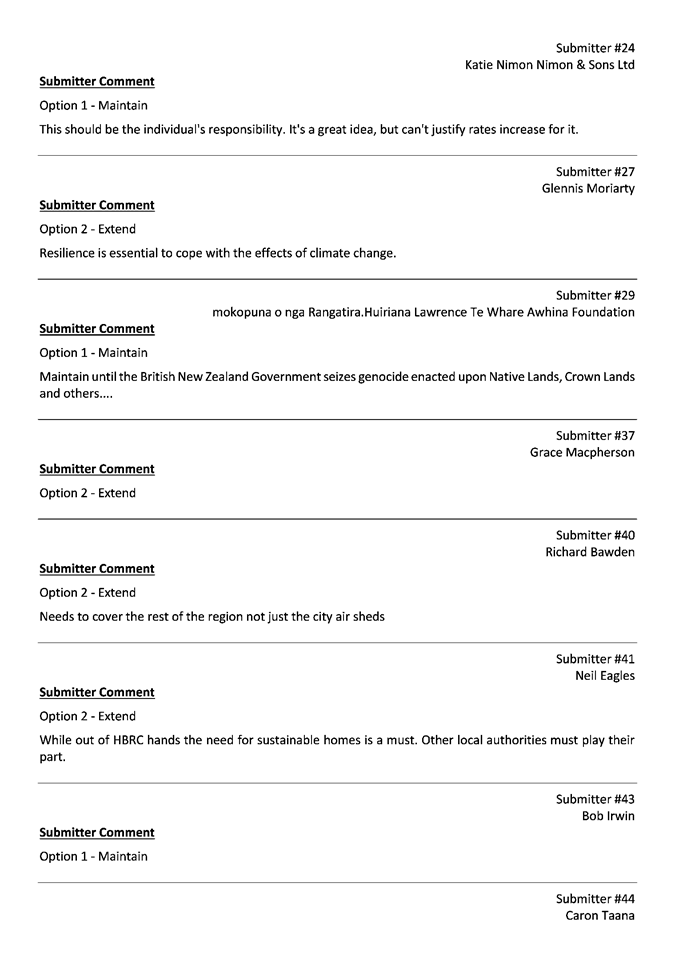





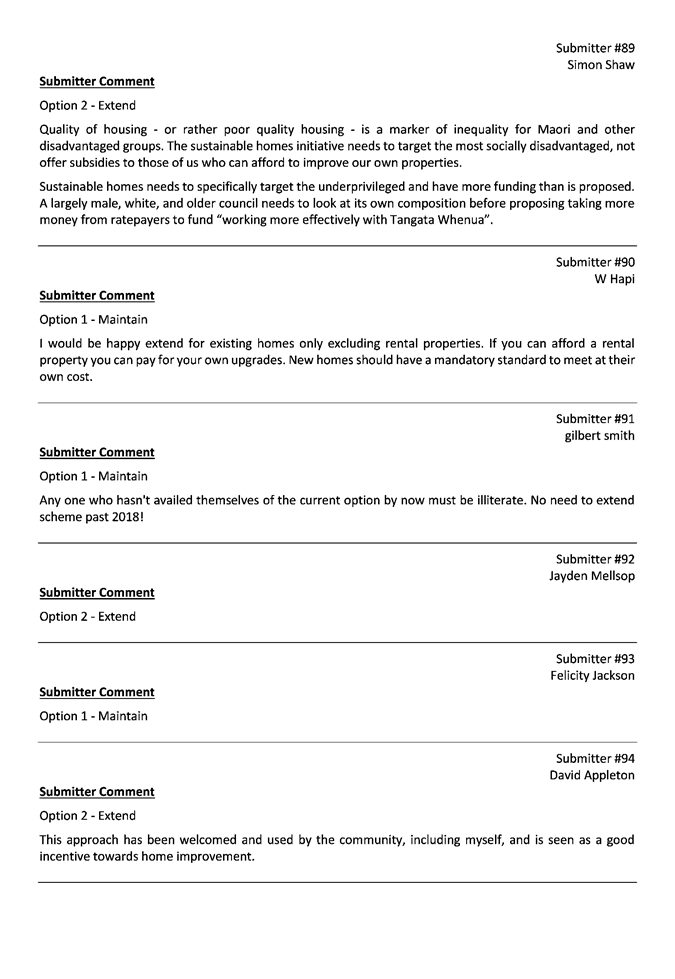







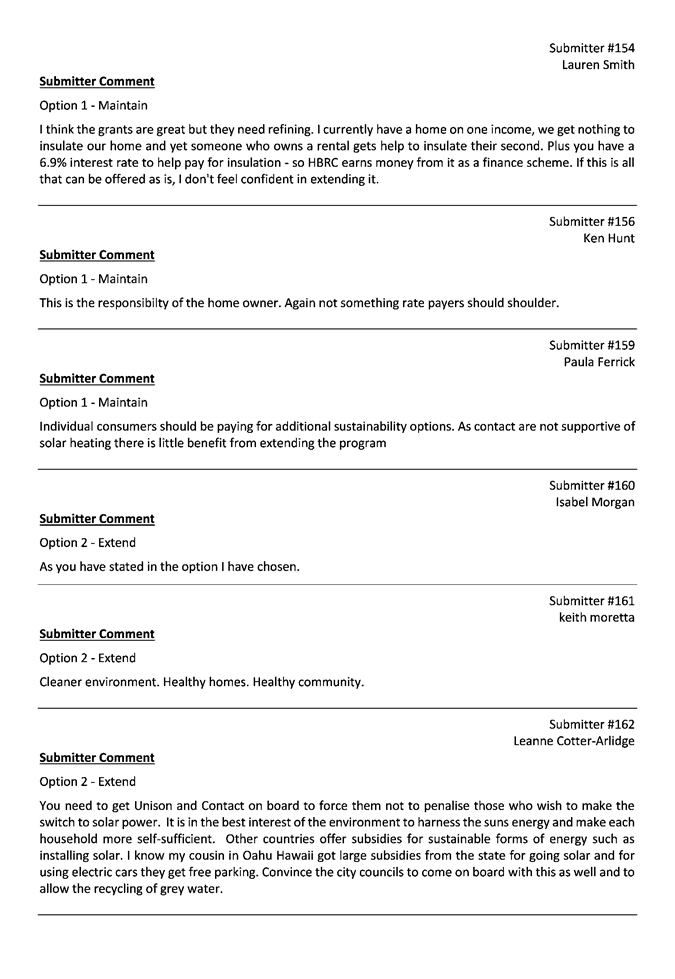
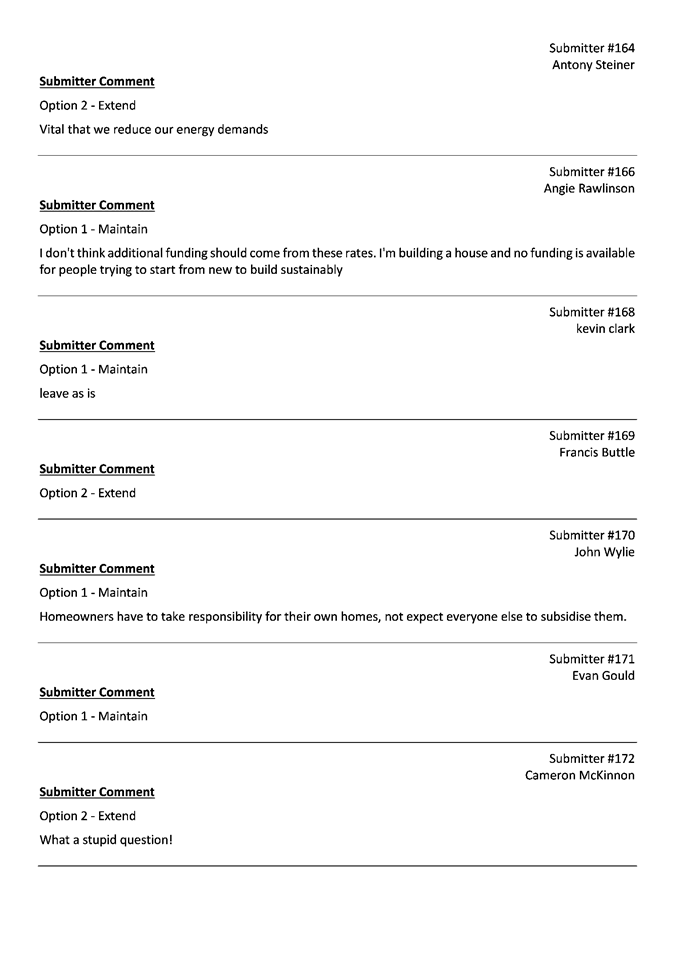

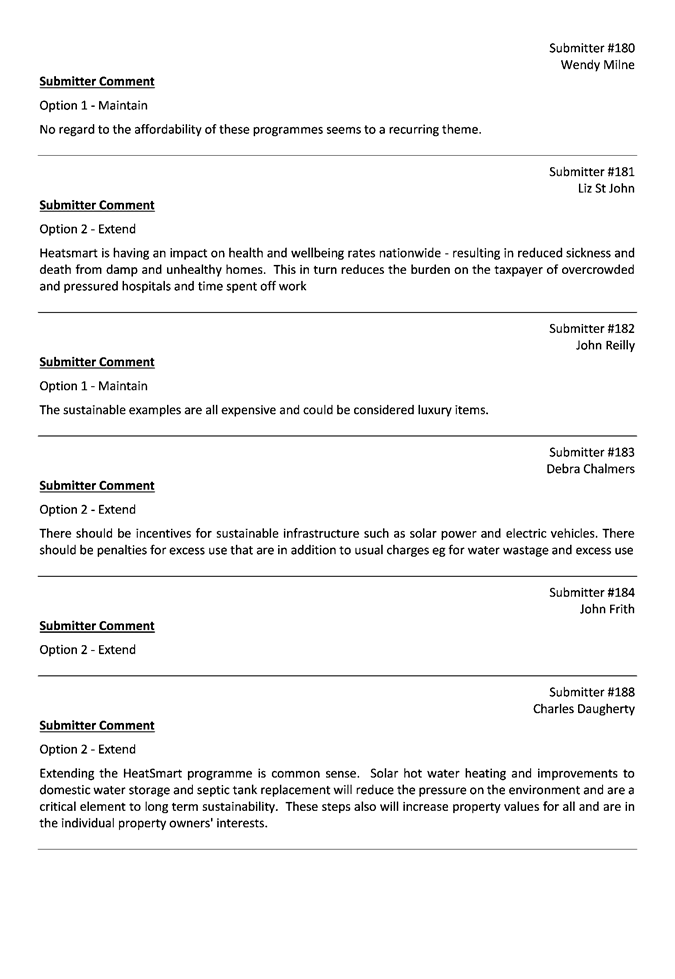
















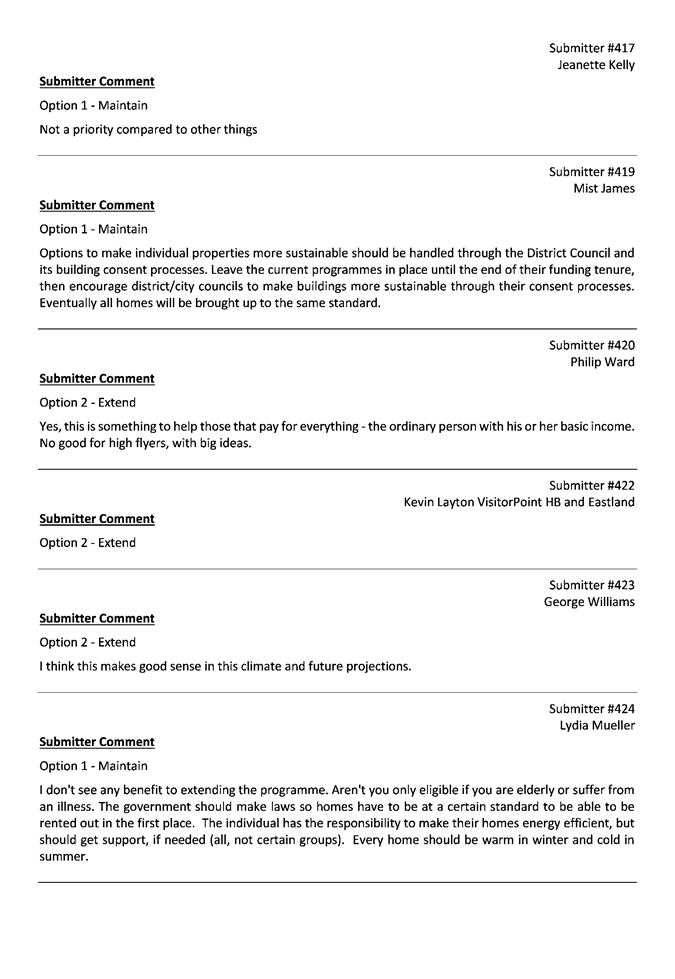




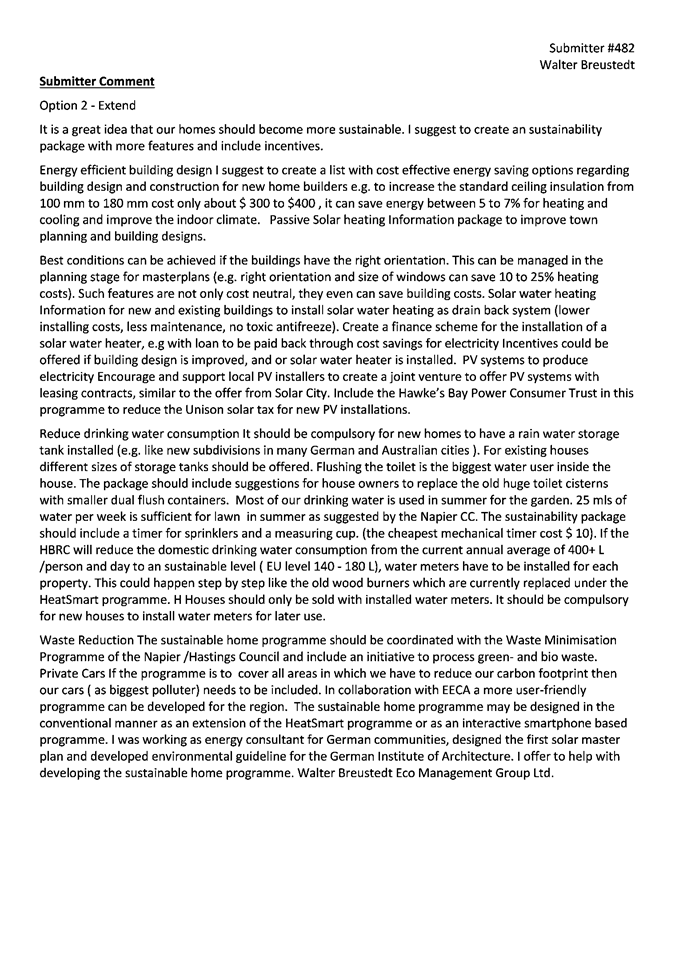



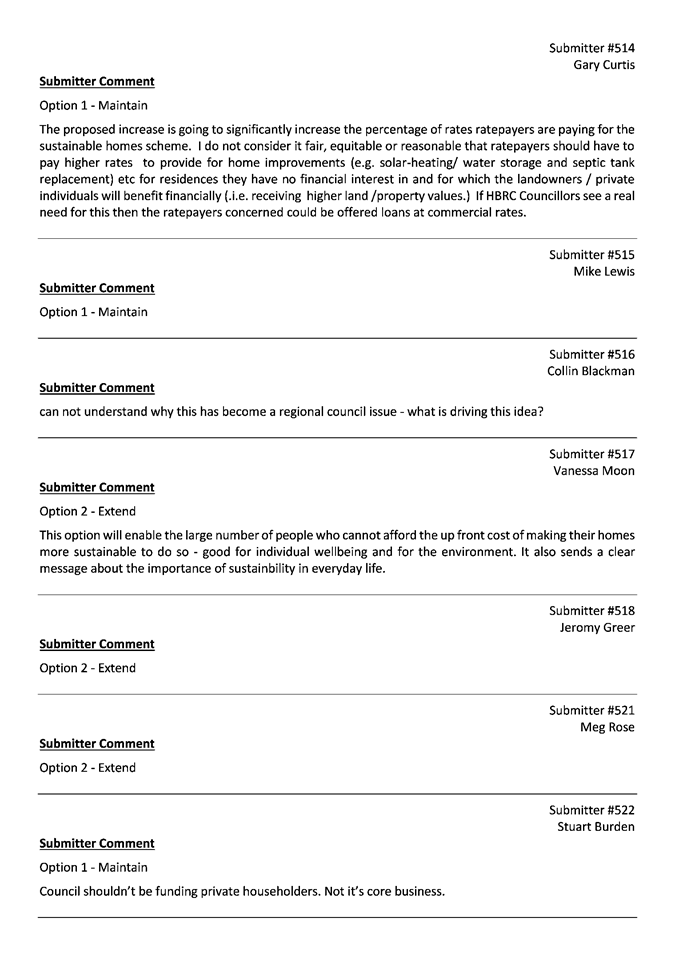
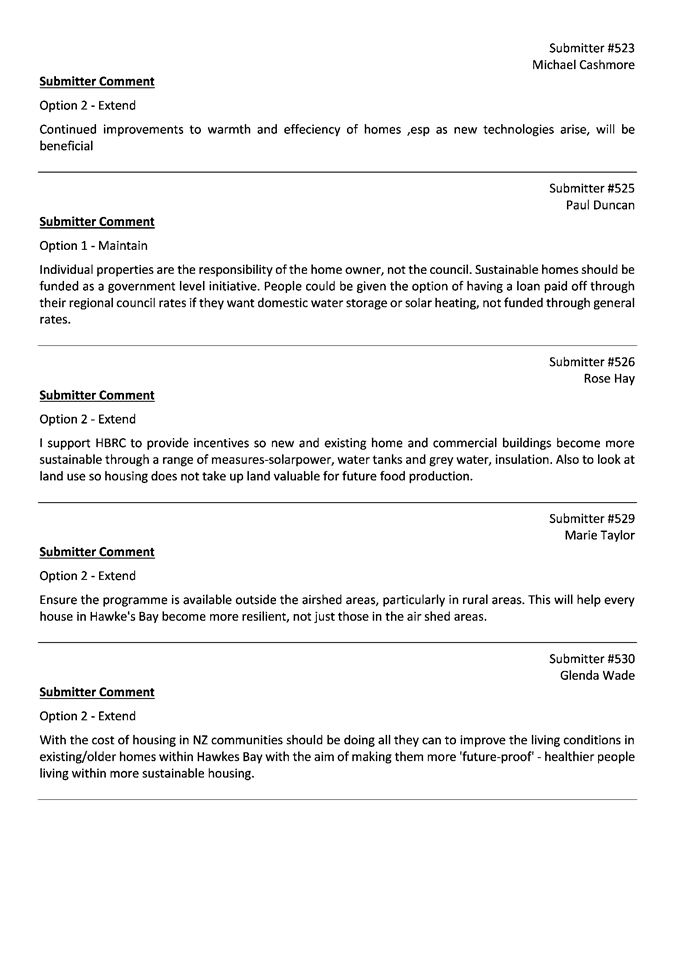

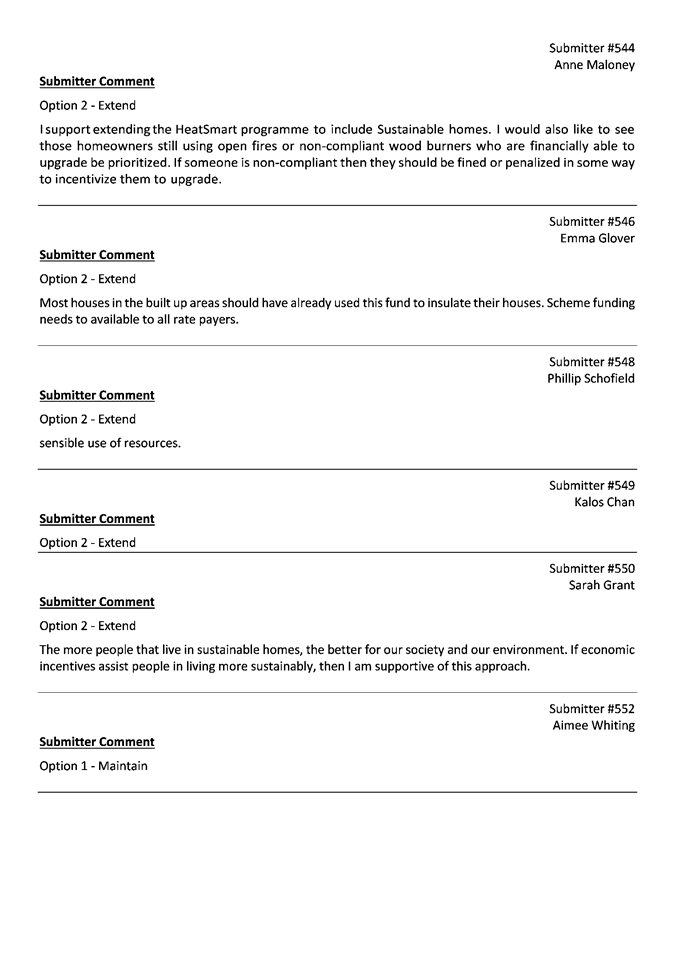
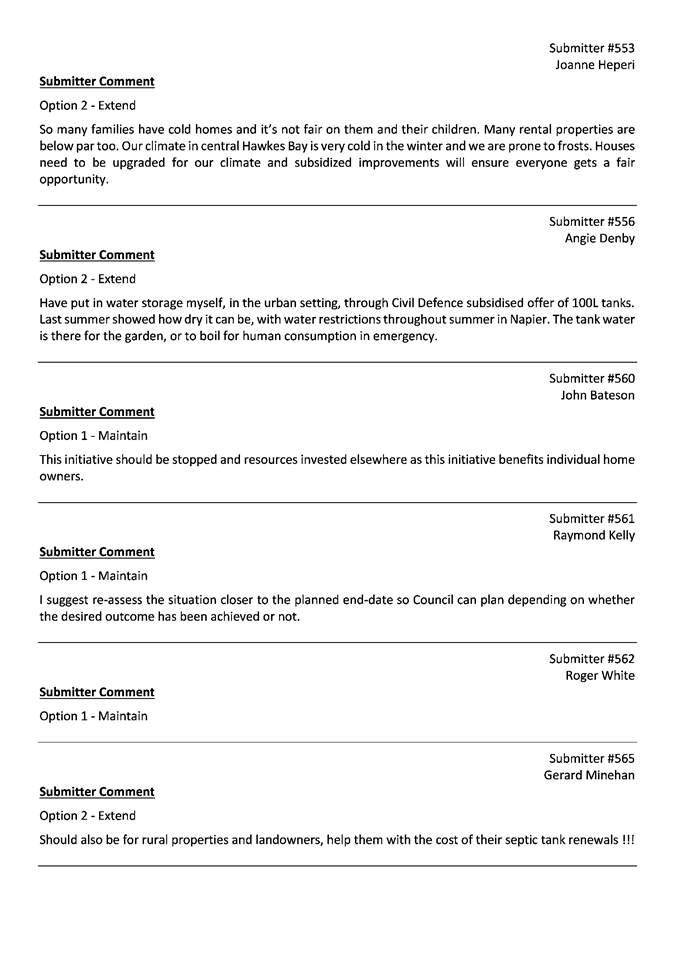




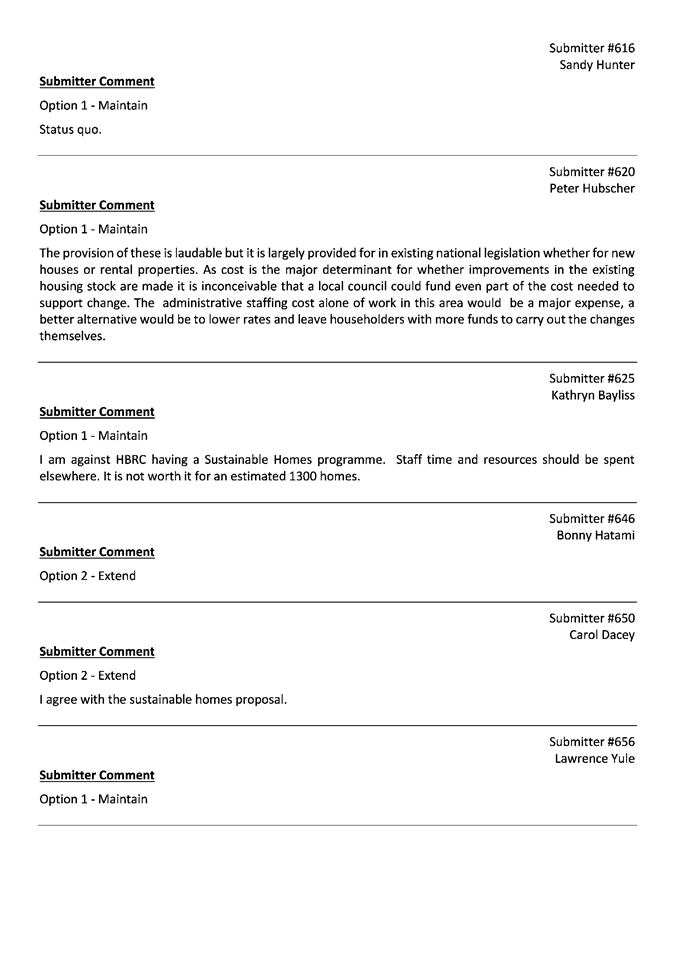
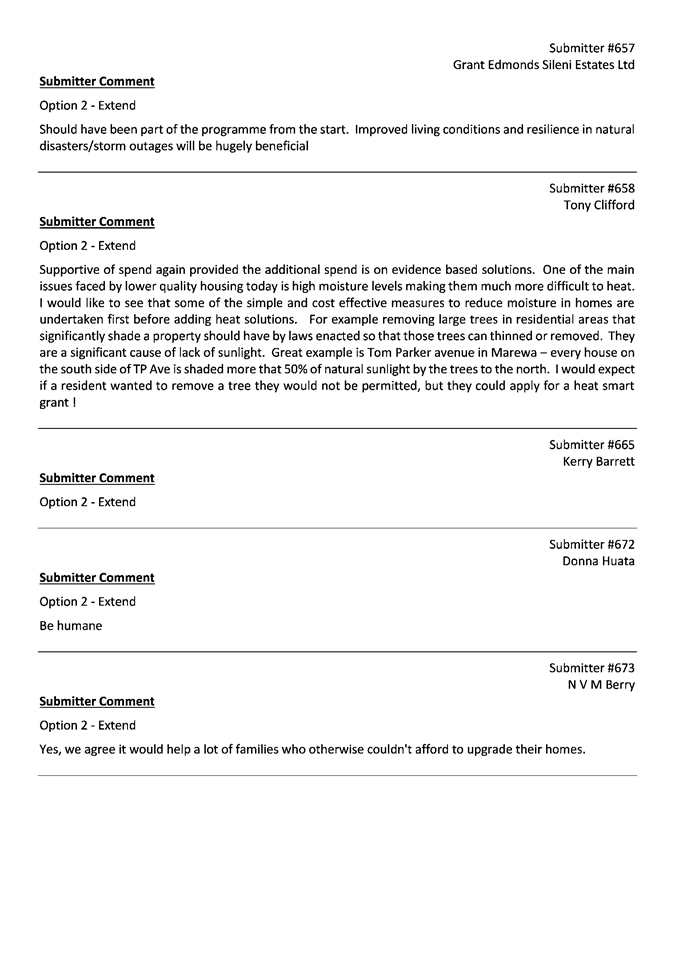
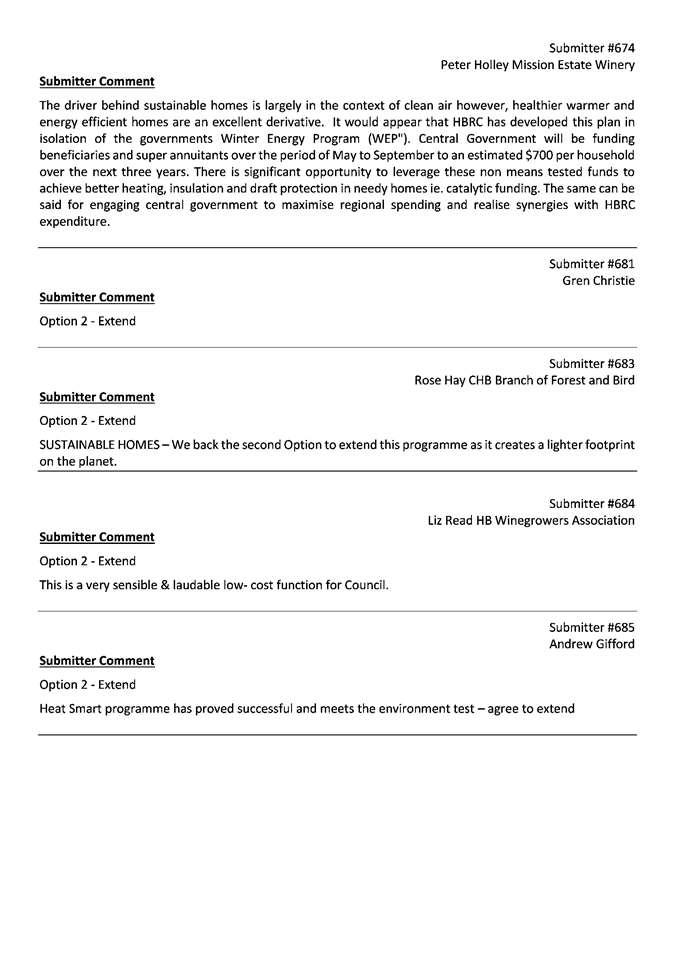




HAWKE’S BAY REGIONAL COUNCIL
Tuesday 22 May 2018
Subject: Local Government
Funding Agency - LGFA
Reason for Report
1. To provide the
Council with an analysis of submissions on the “Local Government Funding
Agency” proposal to join the LGFA as an unrated guaranteeing local
authority as consulted on in the Facing our Future 2018-28 Long Term
Plan consultation document.
Background
2. Local
Government Funding Agency was one of the seven key consultation topics Council
sought public submissions on through the Facing our Future 2018-28 consultation
document. As shown in the following extract from the consultation document,
Council’s preferred option was option 3 to join as an unrated
guaranteeing local authority with unlimited borrowing.


Financial
and Resource Implications
3. The
financial impacts of this initiative are:
|
|
Additional spend
|
|
|
Yr1
2018-19
|
Yr2
2019-20
|
Yr3
2020-21
|
Cumulative over 3 years
|
|
Local Government
Funding Agency
|
$10,000
|
Nil
|
Nil
|
$10,000
|
|
Total rating impact
|
Nil
|
Nil
|
Nil
|
Nil
|
Submissions Received
4. A total of 322
submissions were received on this consultation topic (see attached).
5. Of those submitters who clearly specified an option,
117 of the submitters supported Option 3 (Council’s preferred
option – to join as an unrated guaranteeing local authority); 127
preferred Option 2 (joining as a non-guaranteeing local authority) and 78
preferred Option 1 (the status quo).
6. This equates to
36.34% for joining as unrated; 39.44% for non-guaranteeing and 24.22% for the
status quo (not joining). A total of 76% supported joining in some form.
Key themes
expressed by submitters included:
7. Submissions
opposed to joining the LGFA entirely
7.1. Of those who oppose joining the
LGFA entirely, the key concerns were in relation to the risk involved with
joining as a guarantor.
7.2. Some submitters expressed
concern about whether joining the LGFA would enable councillors to borrow
recklessly and over and above the amounts as disclosed within the consultation
document.
7.3. Another concern in regards to
borrowing to fund long term projects, is the burden of borrowing on future
generations and the possibility of interest rate increases.
7.4. There were some concerns
regarding the costs involved with joining, and had sufficient analysis been
completed to evaluate the cost vs benefit.
7.5. Questions arising to the
reallocation of the $80 million which had been ring-fenced for the RWSS and why
that would not be used to fund the initiatives consulted on.
7.6. One submitter urged Council to
look at alternative methods to fund infrastructure development and
environmental enhancement. These alternative methods include the
establishment of a complimentary local currency.
8. Submissions in
support of joining the LGFA but non-guaranteeing local authority
8.1. The majority
of submitters who provided comments did so in relation to the taking of
un-necessary risk in regards to joining as a guarantor and the potential for a
call on rate payers should another LGFA borrower default.
8.2. Many raised
concern over the use or the phrase of “unlimited” borrowing, which
was used to refer to the limits on membership of the LGFA where as an un-guaranteeing
member you can only borrow up to $20 million. The term “un-limited”
refers to the amount possible to borrow from the LGFA, there are no limits on
levels of borrowing for guaranteeing members, however application for borrowing
will still require strict financial management and borrowing metrics and
financial covenants must be adhered to
9. Submissions in
support of joining the LGFA as an unrated guarantor
9.1. Submitters
support joining as a guarantor, which provides the most flexibility and enables
borrowing above $20 million if required, but under no commitment to do so.
9.2. These
submitters considered that the proportionate risk is appropriate and balanced
in favour of the cost savings that can be achieved by accessing borrowing at
reduced rates.
9.3. They agreed
that it seems prudent to access borrowing at the lowest rate possible however a
common theme was that submitters thought the level of borrowing should be
closely monitored and that borrowing needs to be responsible and should always
consider the impact on future generations.
Officers’ Analysis of Submissions
10. The financial strategy of
the 2018-28 LTP has been developed to enable accelerated investment in our
environment now. The challenge for Council is to provide funding for its
new strategic agenda whilst maintaining a balanced operating budget.
Along with reviewing operational efficiencies, increasing an emphasis on user
pays, and a more aggressive investment strategy we believe it is appropriate
and complementary to our financial strategy to fund initiatives which future
generations will benefit from, through borrowing, which spreads the cost over
many years. This LTP includes borrowing of $71 million over 10 years, and
joining the LGFA scheme as a guaranteeing member would provide access to lower
interest rates and more favourable terms and conditions on borrowing up to and
above $20 million.
11. The LGFA delivers
cost-savings of $20 million each year to its members, which would otherwise
need to be funded by higher rates. Forty-five councils have currently signed
the (joint and several) guarantee with LGFA, which guarantees LGFA, and not
individual council borrowings.
12. Staff believe the benefit
to ratepayers outweighs the minimal risk and in joining this scheme as a
guarantor. While the risk is low, there is potential liability associated with
a call under the guarantee. We have considered this and believe there is very
low probability due to the strong performance of New Zealand’s local
authority sector, rates security, LFGA’s financial covenants, capital,
governance and government relationship to name a few. If we become a
guaranteeing council, our share of the guarantee would be 0.37%. For example,
if a $100 million call was made under the guarantee, Hawkes Bay Regional Council’s
total exposure would be $370,000.
13. There has never been a
default by a New Zealand Council. In addition, there is strong oversight
of the sector by the Office of the Auditor General (OAG) and the Department of
Internal Affairs (DIA).
14. Similar financing vehicles
operate in Denmark, Sweden, Norway, Finland, Netherlands, France, United
Kingdom, Japan and Canada. They all use a cross-guarantee structure by
member councils similar to the structure of LGFA. There has never been a
call under the guarantee in any of these countries.
15. In regards to excessive or
reckless borrowing, joining does not guarantee access to unlimited or
inappropriate borrowing. The LGFA can decline any application for borrowing
based on a range of financial covenants. Member councils that borrow from
LGFA need to comply with these financial covenants on an annual basis.
The covenants restrict the amount of money a council can borrow. In
addition, Council has its own debt affordability limits which must be complied
with.
16. The cost of joining the
LGFA is a one off expense of $10,000. Given the level of forecast
borrowing the potential cost savings from access to lower interest rates far
exceeds the cost of joining.
In regards to the use
or reallocation of the $80 million which was ring-fenced for the RWSS.
$15 million was expensed on the project, of the remaining $65 million, $15
million is currently invested in Wellington leasehold property and the
remaining $50 million is proposed to be invested to be preserved and to provide
investment income to help fund the increase in Council’s operating
activities. Both the Wellington property and the $50 million are forecast
to return a higher yield than current borrowing rates.
Decision Making Process
17. Council
is required to make every decision in accordance with Part 6 Sub-Part 1, of the
Local Government Act 2002 (the Act). Staff have assessed the requirements
contained within this section of the Act in relation to this item and have
concluded:
17.1. Section
93(A) of the Act provides for the use of a special consultative procedure in
relation to the adoption of a Long Term Plan as prepared under section 93 of
the Act.
17.2. The issues to be
considered in this paper are those issues raised by members of the community
that have submitted to the Council on the Consultation Document “Facing
Our Future 2018-28”. All submissions are an integral part of the special
consultative processes set out in Section 83 and 85 of the Local Government Act
2002.
|
Recommendations
That the
Hawke’s Bay Regional Council:
1. Receives and notes
the “Local Government
Funding Agency” staff report.
2. Considers the
submission points made relating to the “Local
Government Funding Agency” proposal and any
comments made by Council officers.
3. Agrees to join the LGFA as an un-rated
guarantor as consulted on through Facing Our Future 2018-28
Or
4. Does not agree to join the LGFA.
Or
5. Agrees to join the LFGA as a non-guaranteeing
authority.
|
Authored by:
|
Jessica
Ellerm
Group Manager
Corporate Services
|
|
Approved by:
|
James Palmer
Chief Executive
|
|
Attachment/s
|
⇩1
|
LGFA LTP
Topic Submissions
|
|
|
|
LGFA
LTP Topic Submissions
|
Attachment 1
|
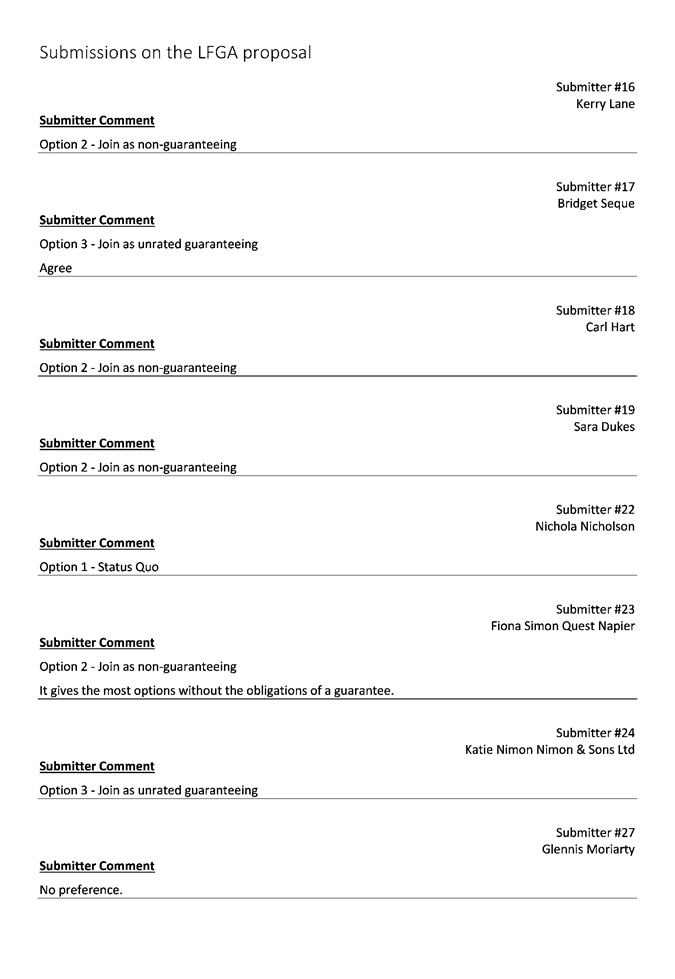

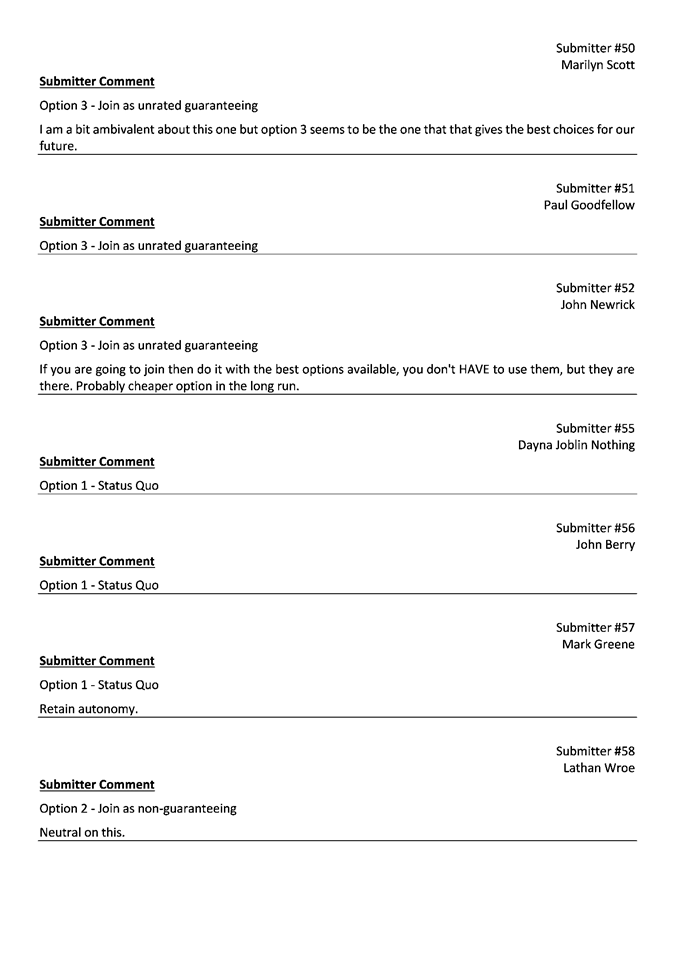

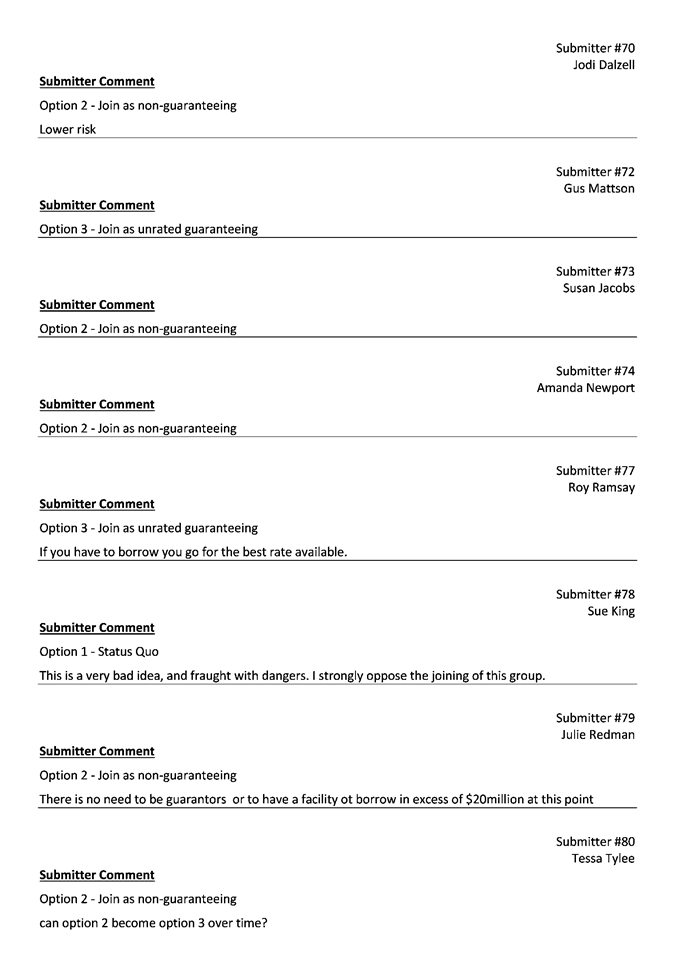


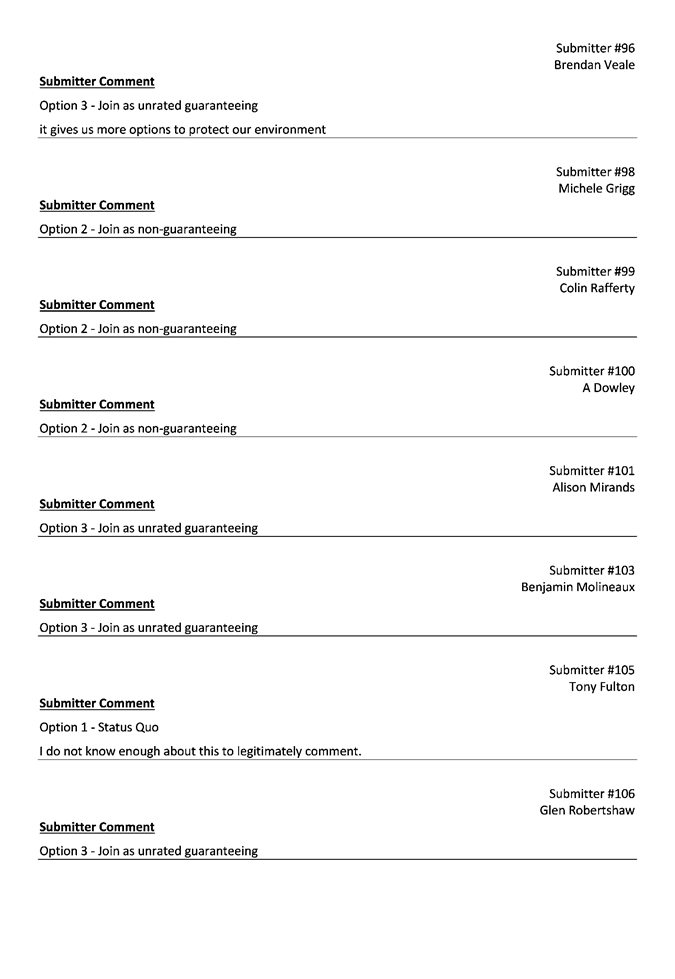
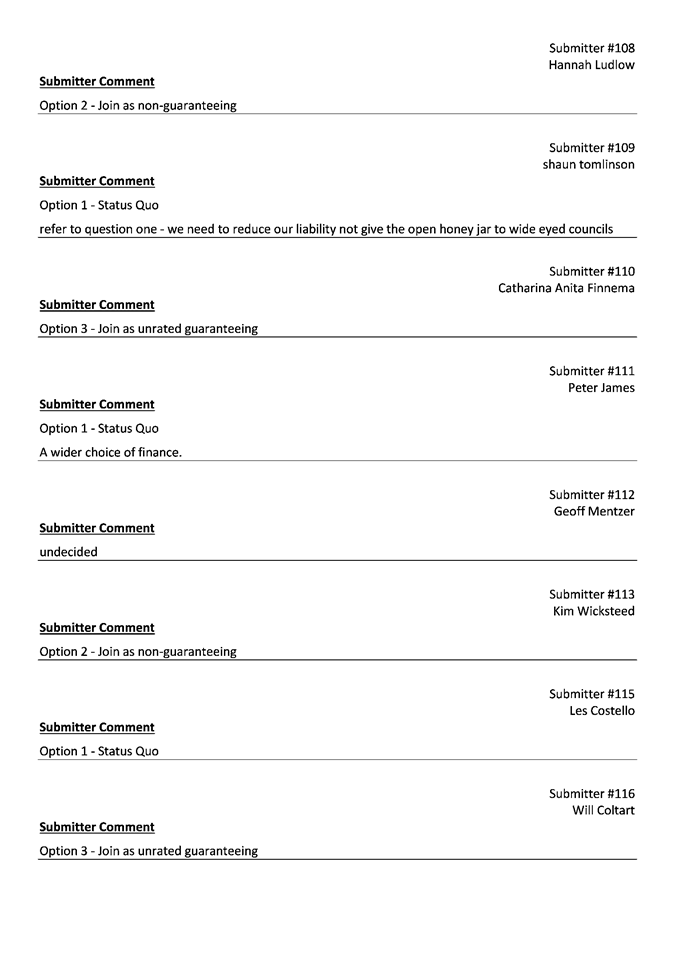


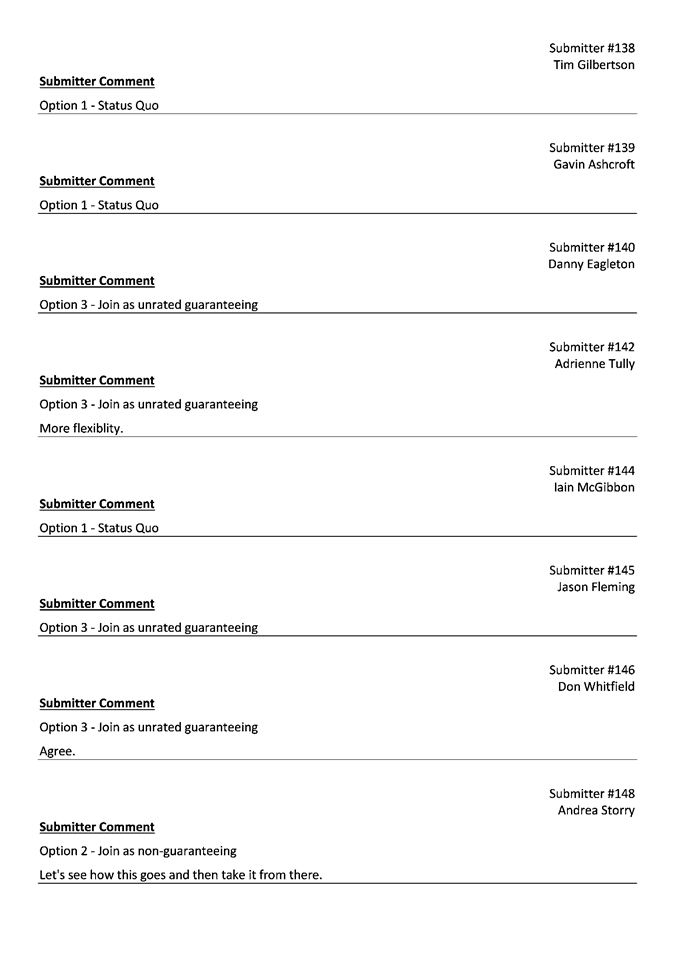
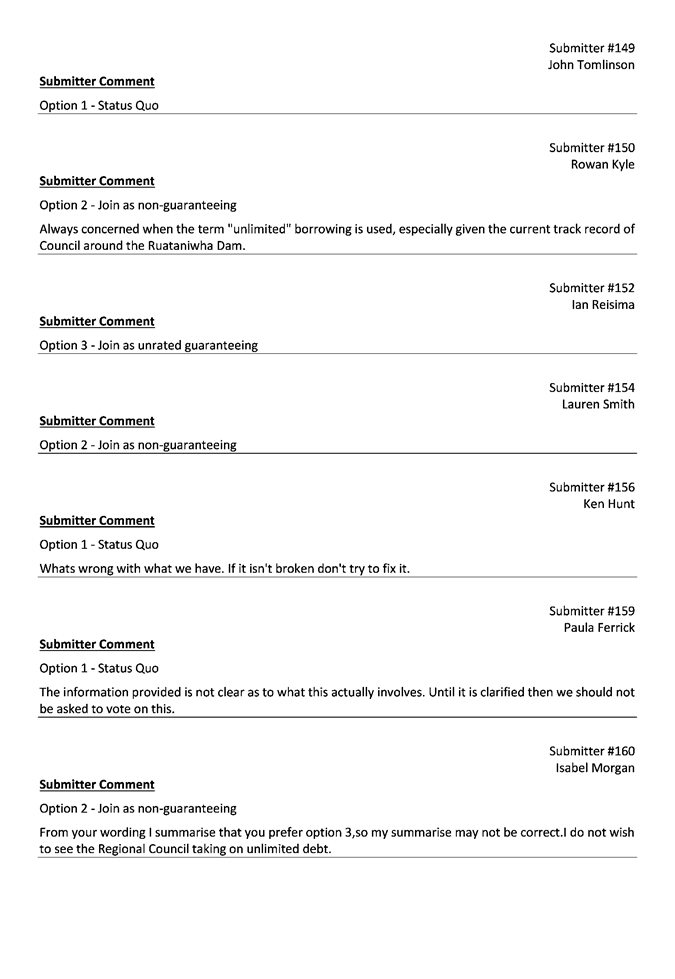
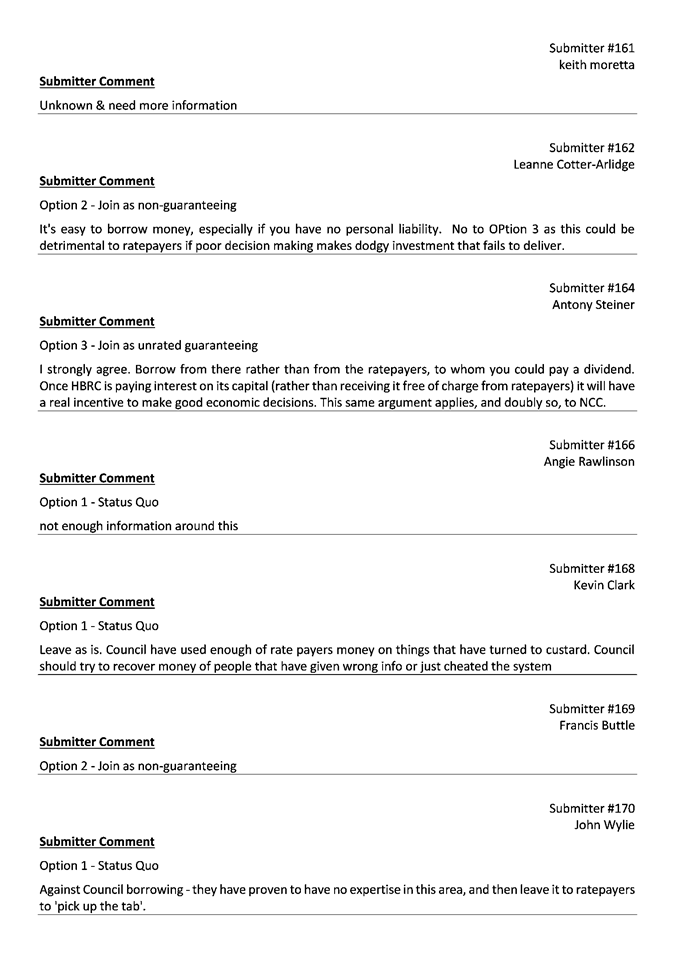
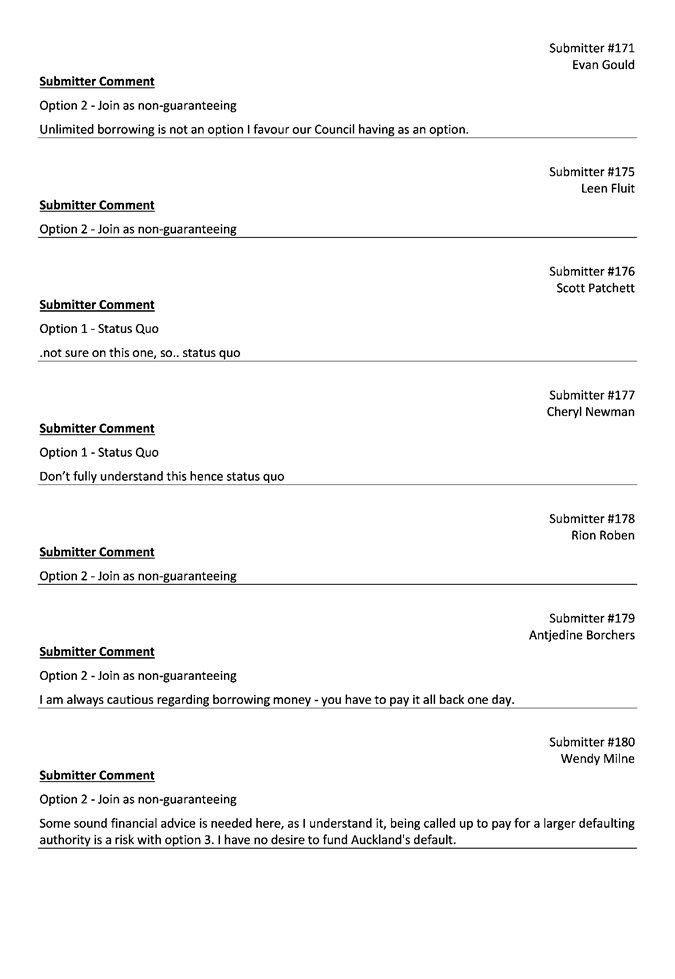
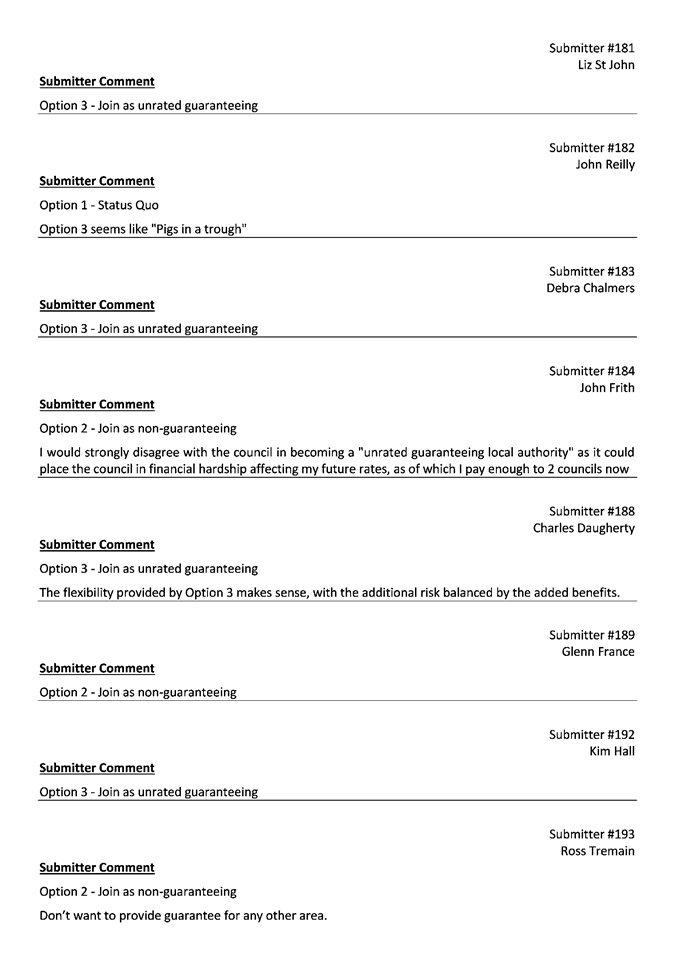
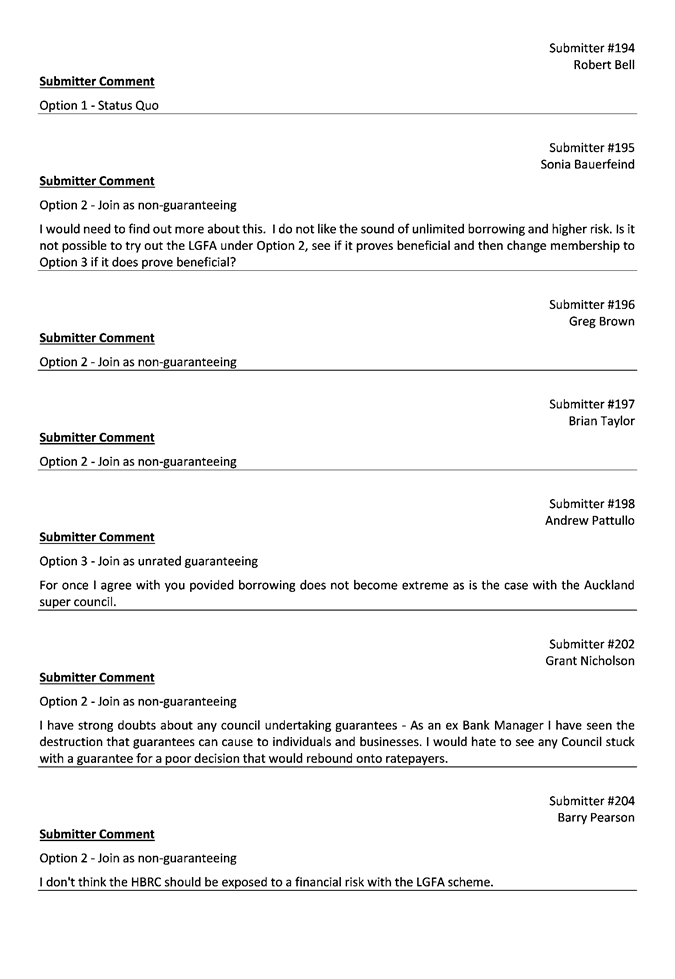
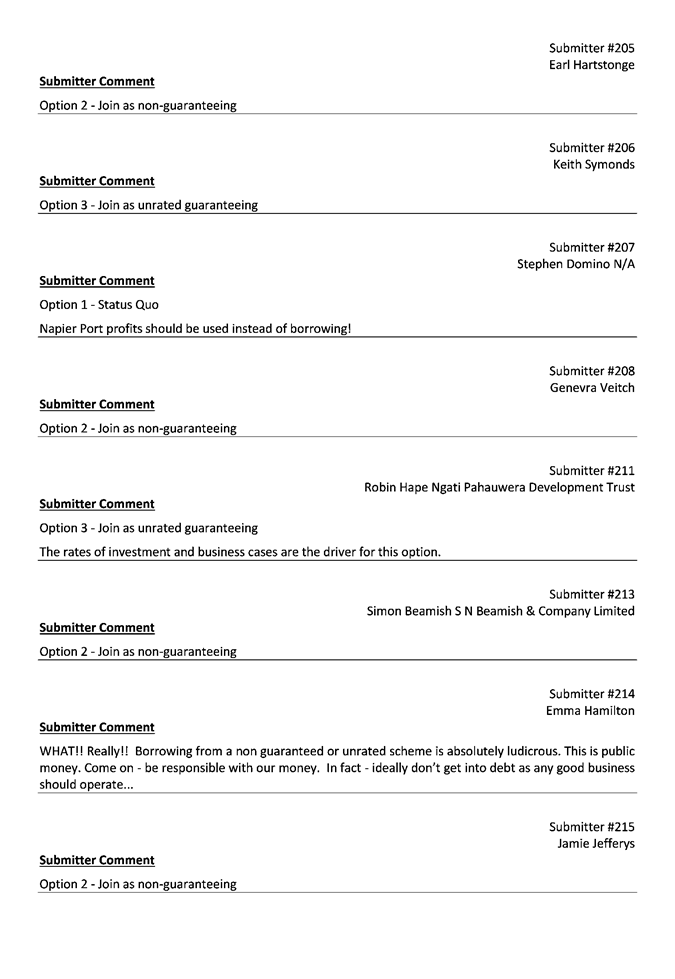
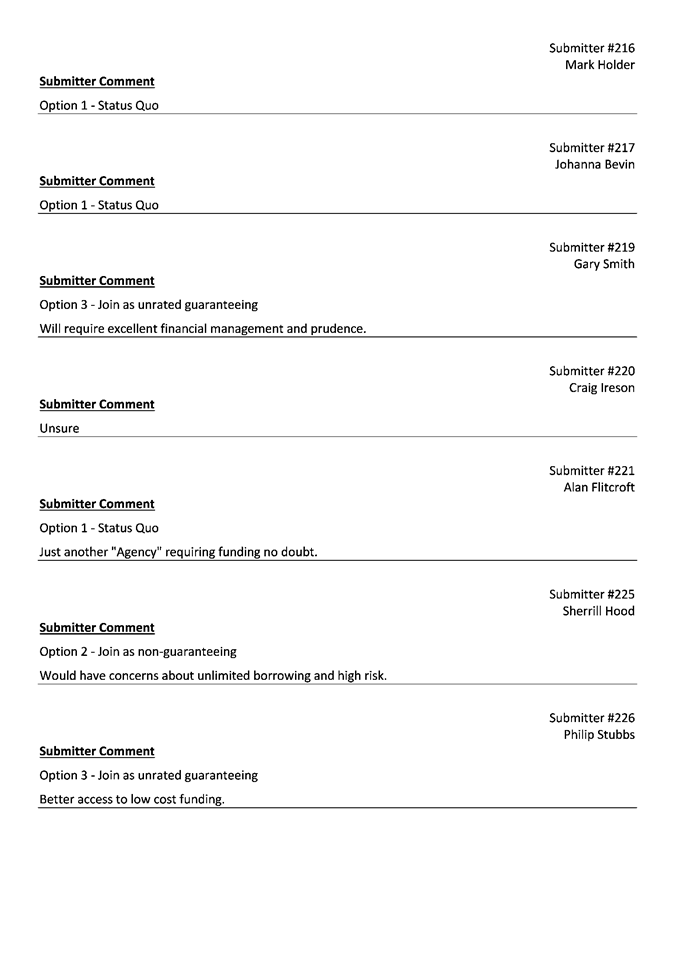

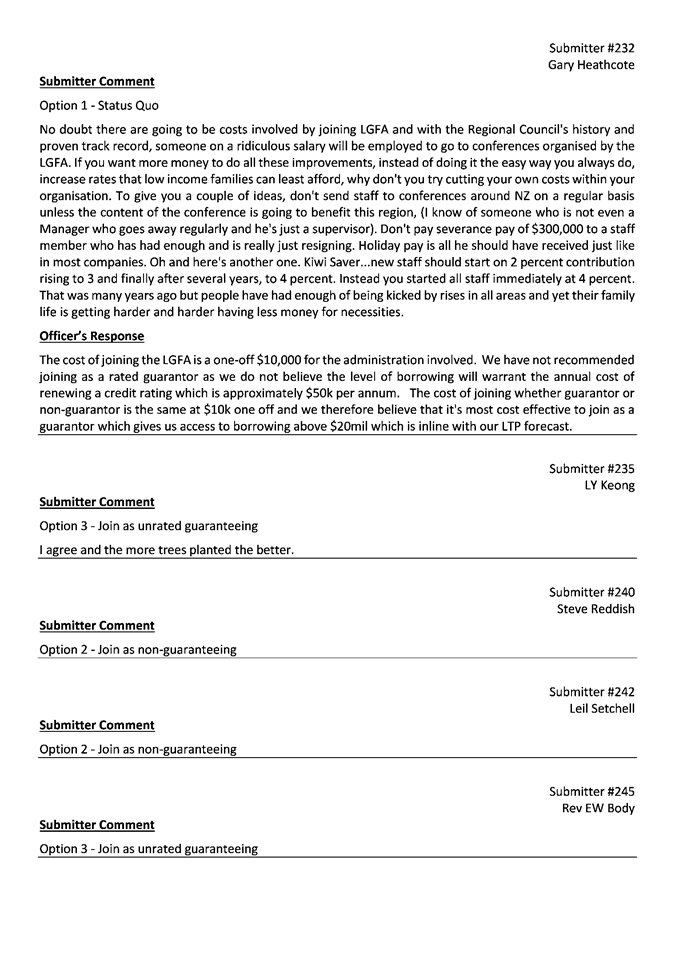
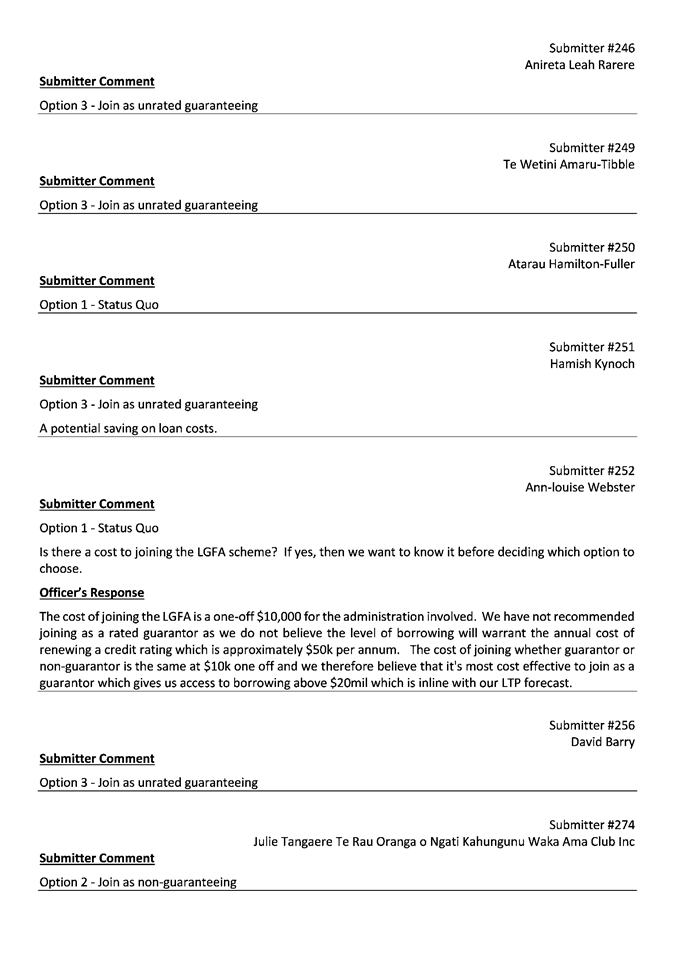
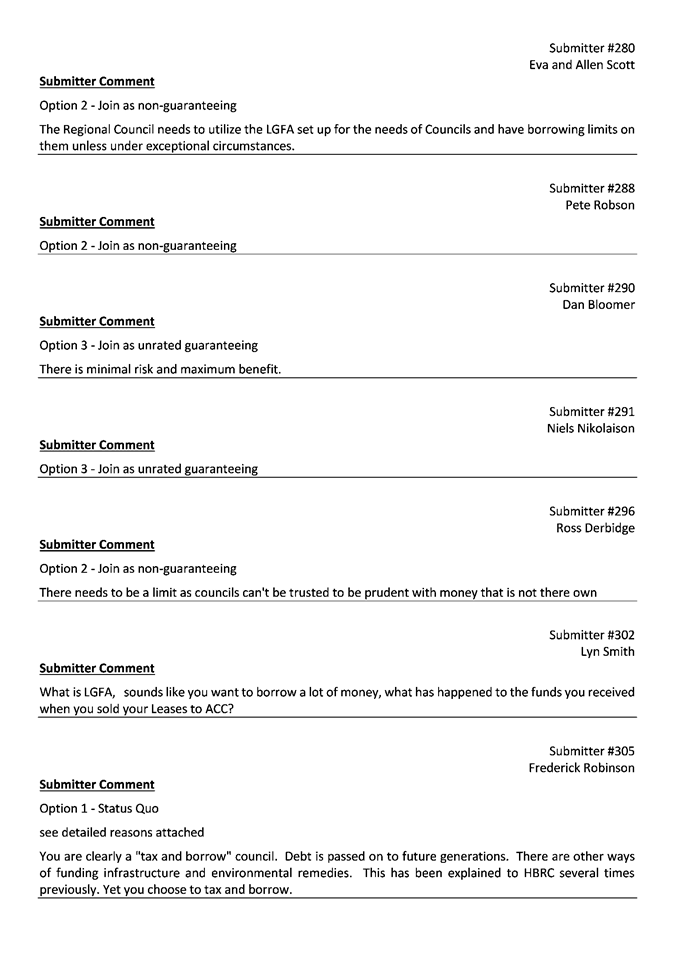

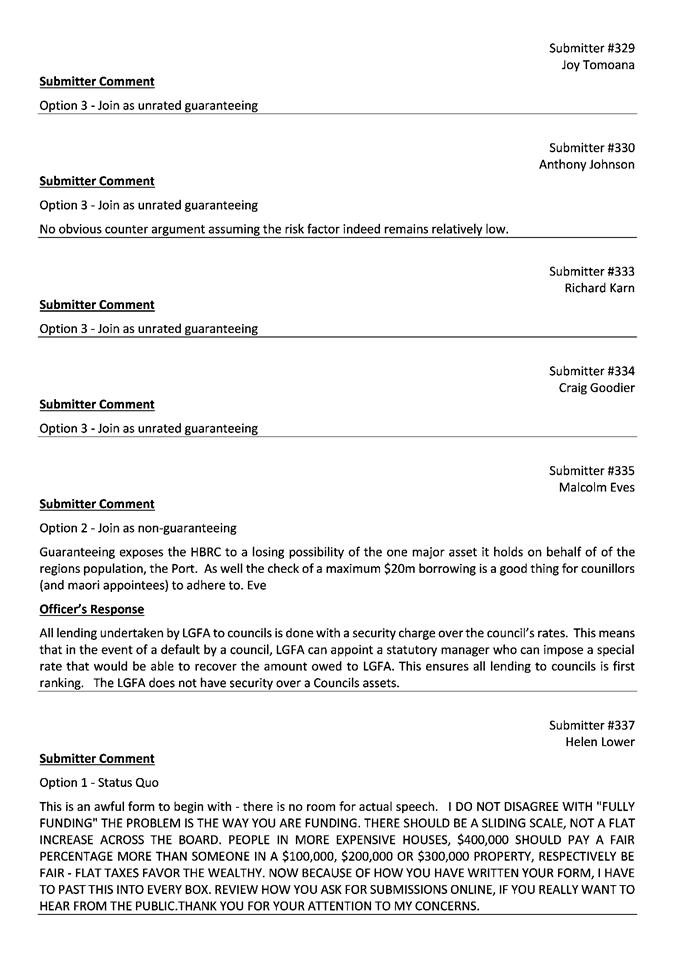
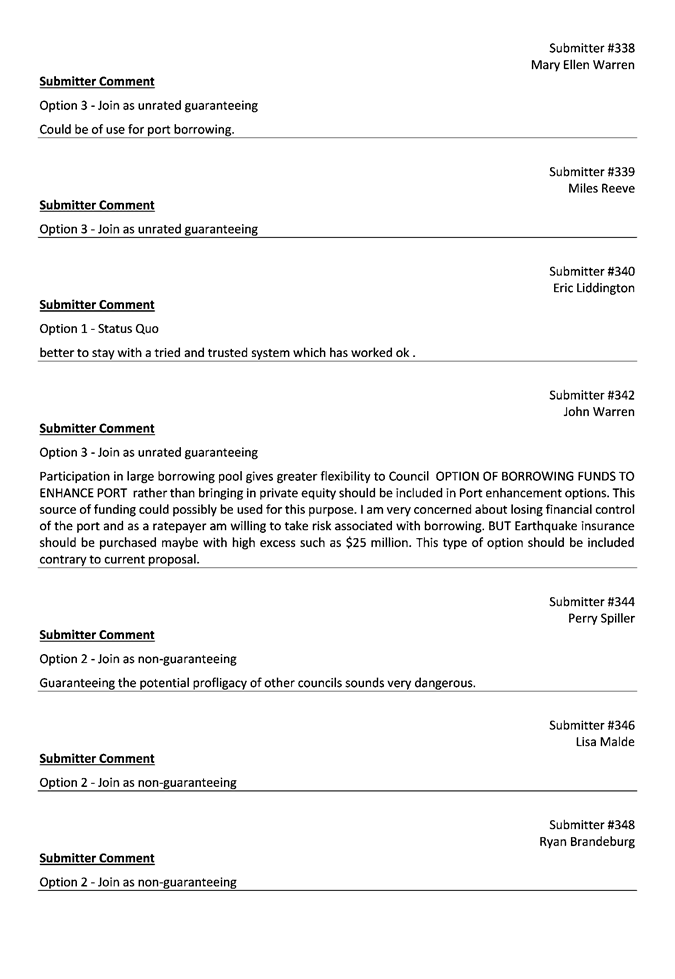
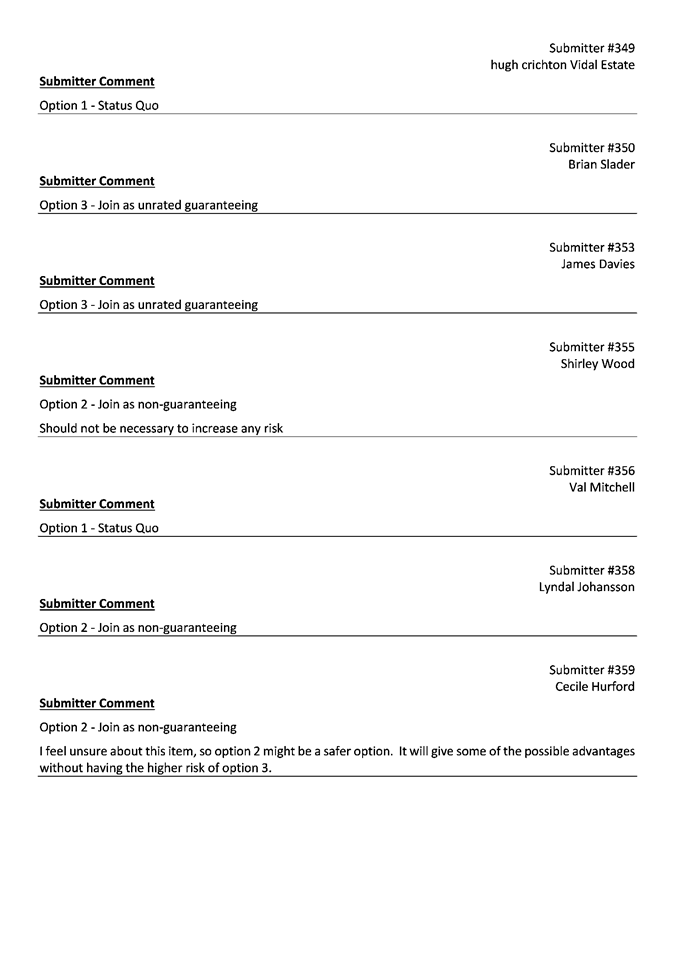
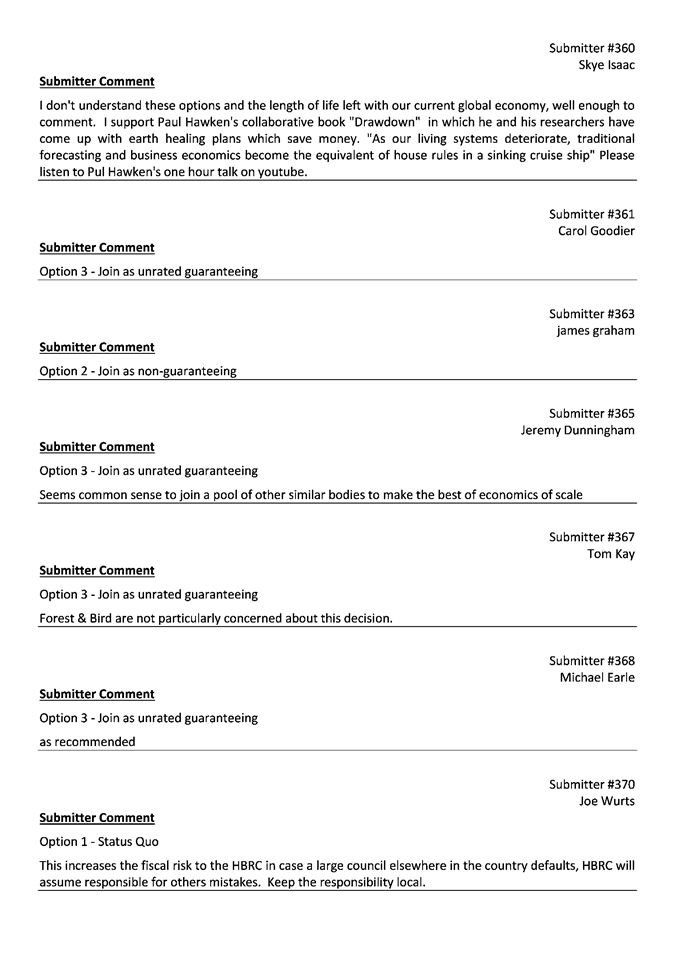
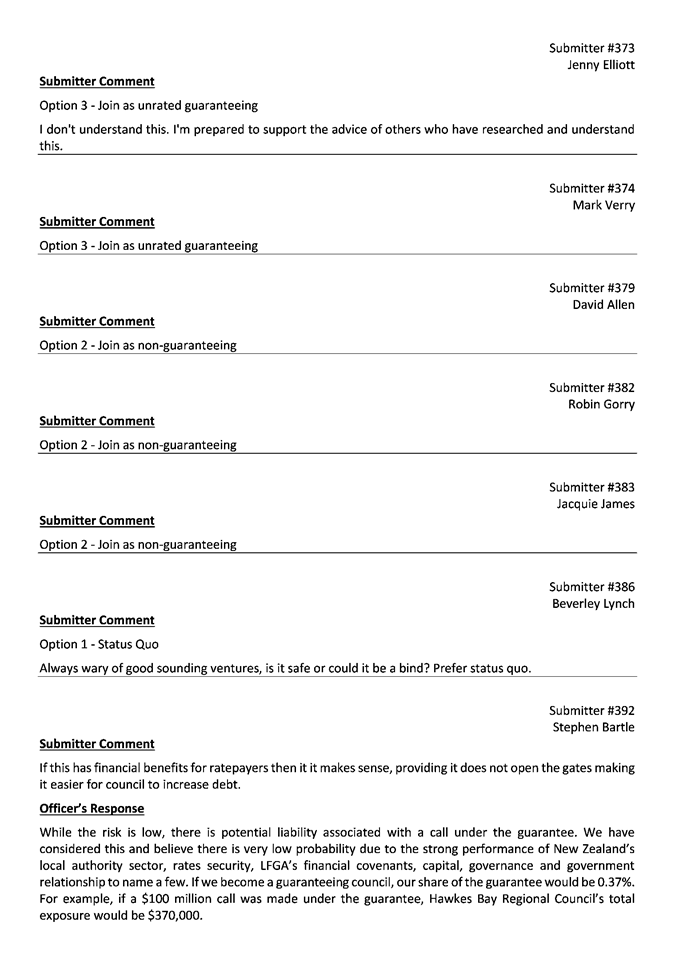
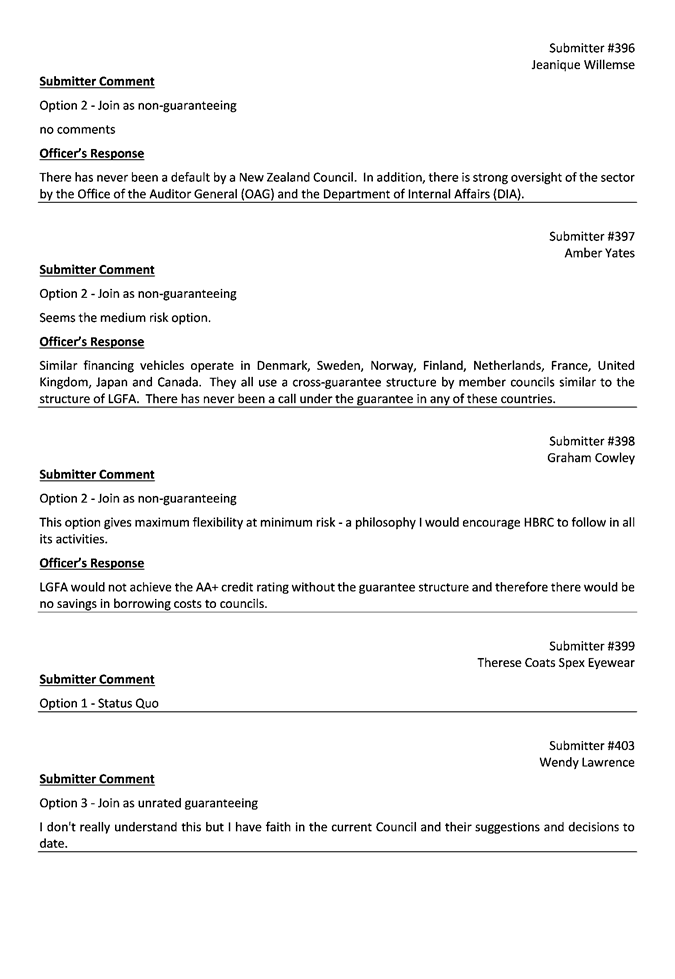
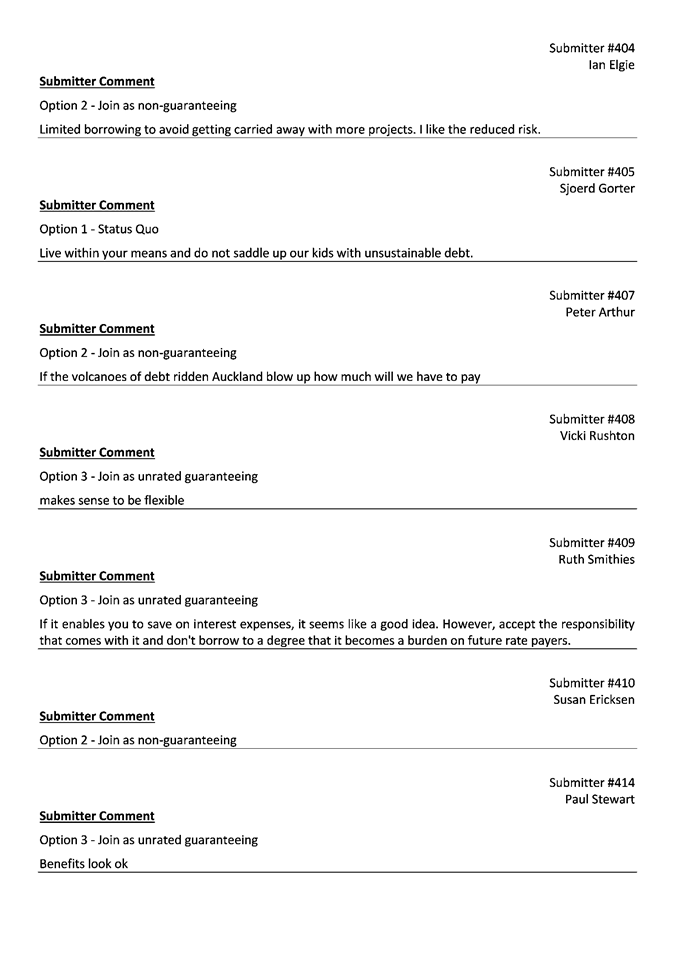
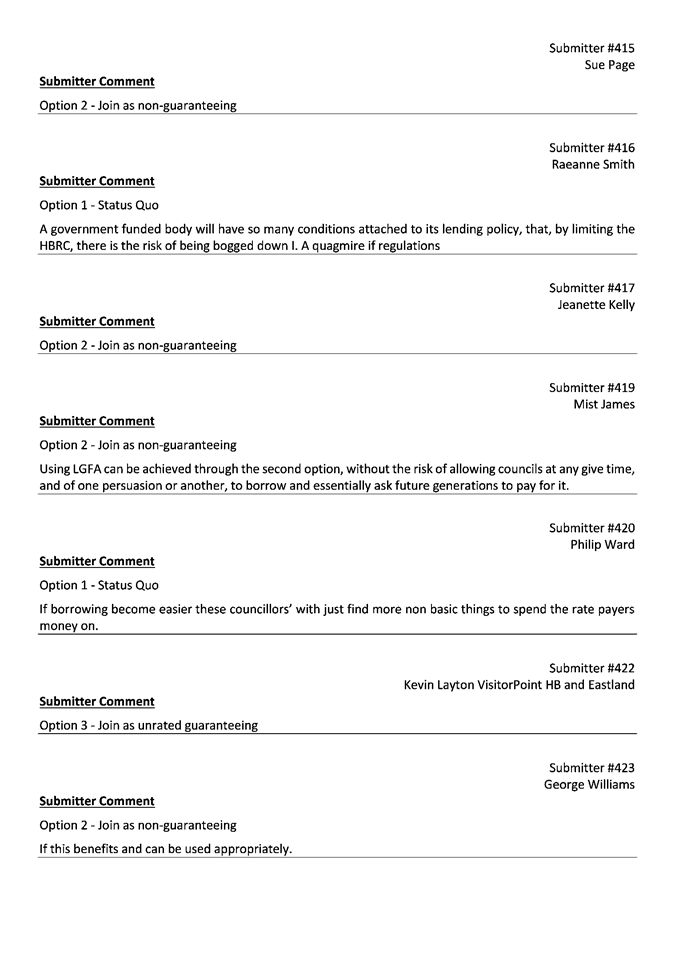
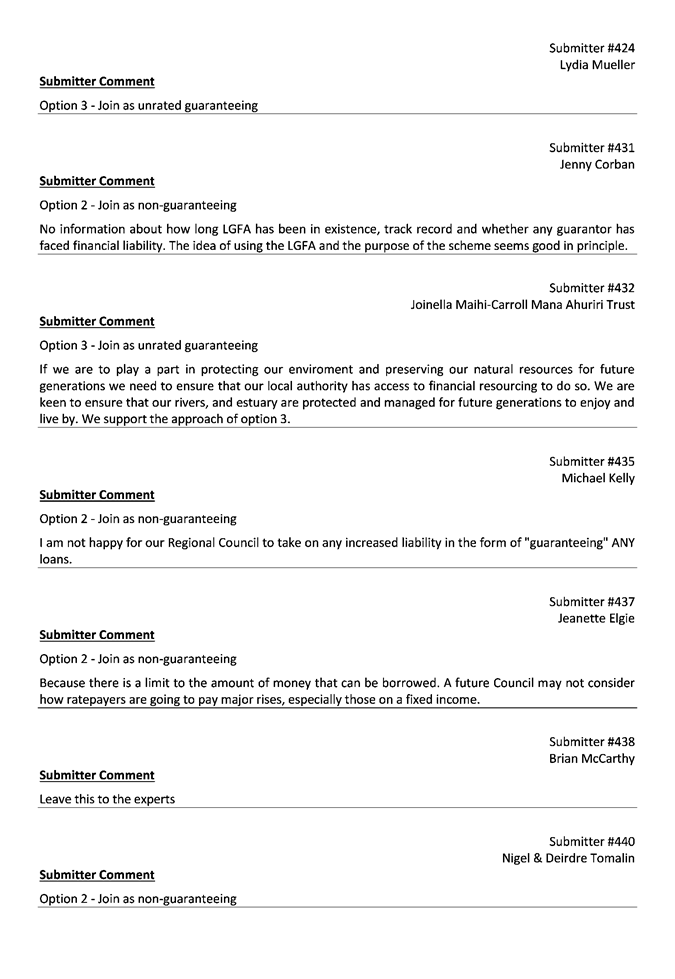
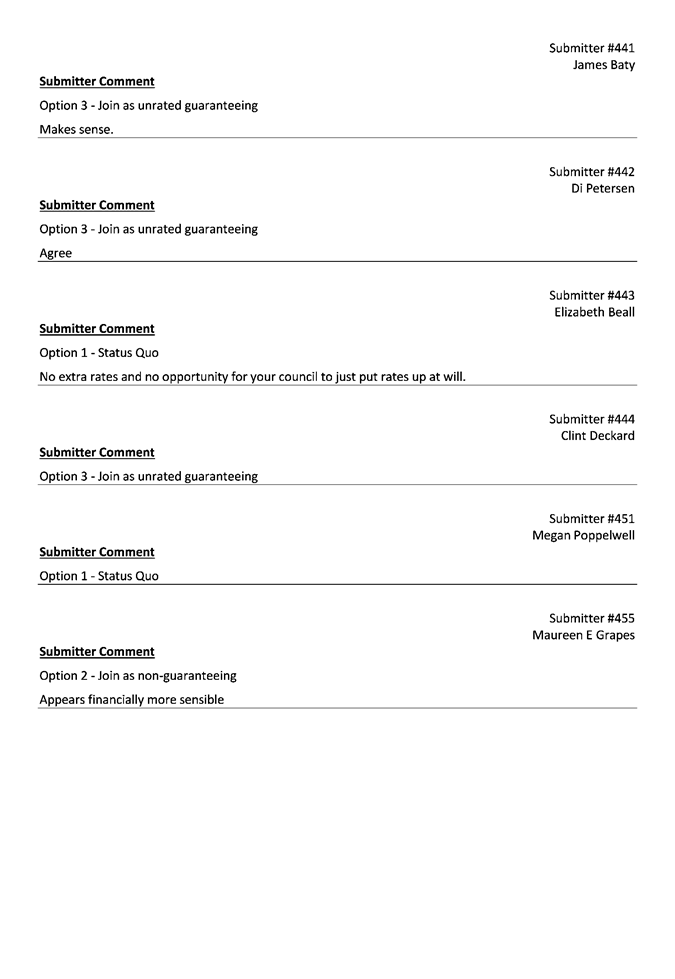
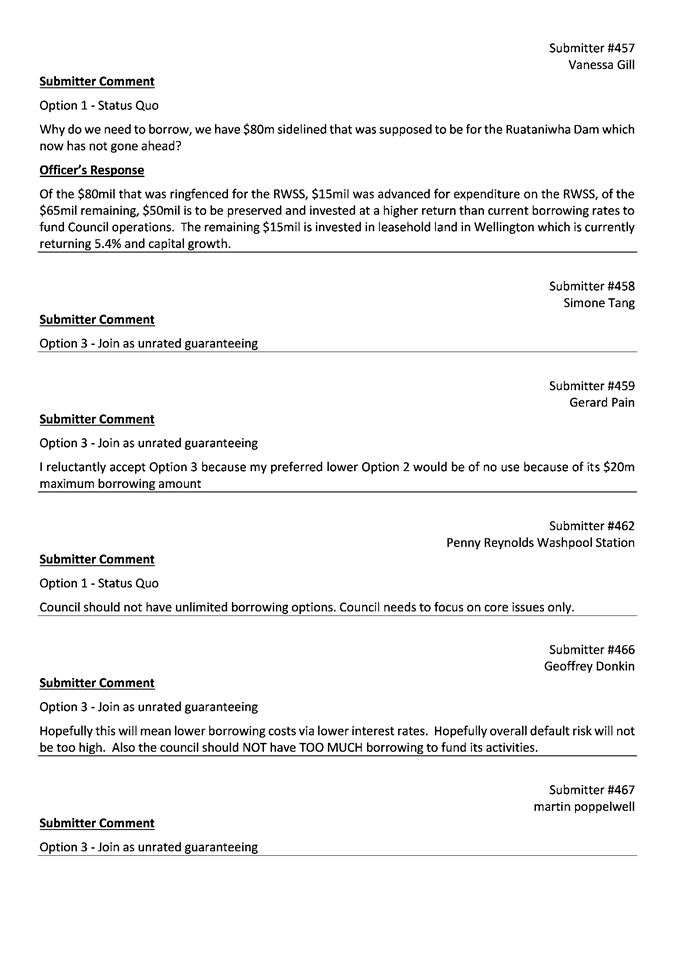
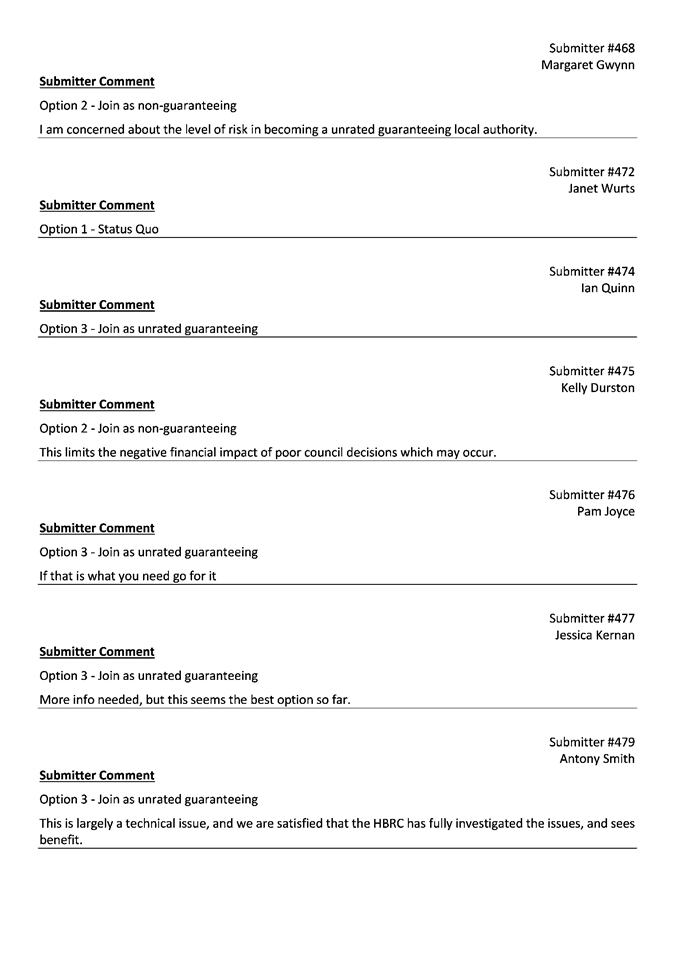
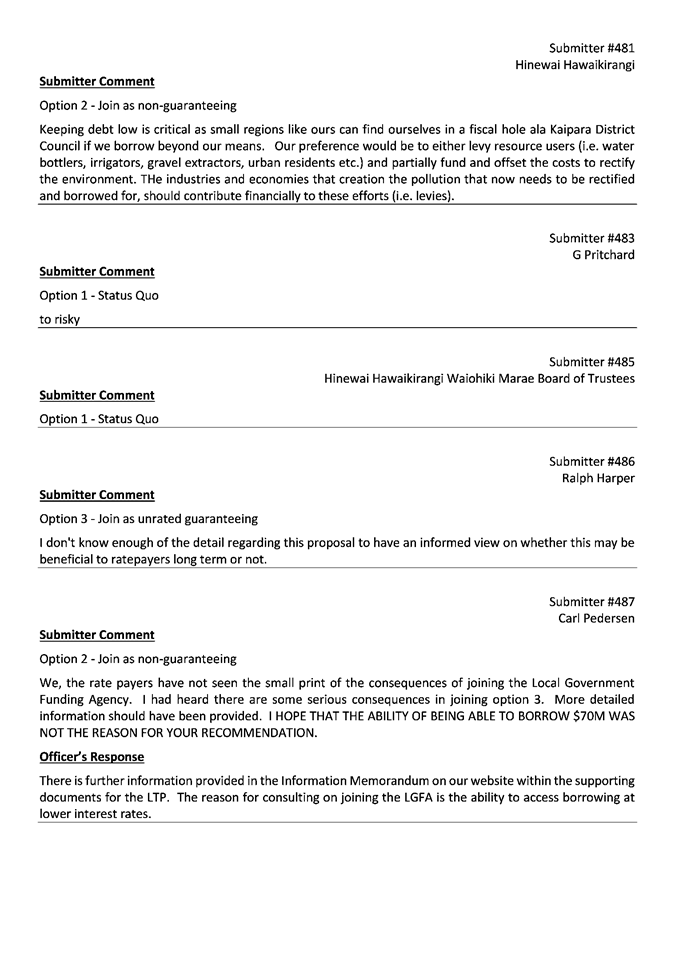


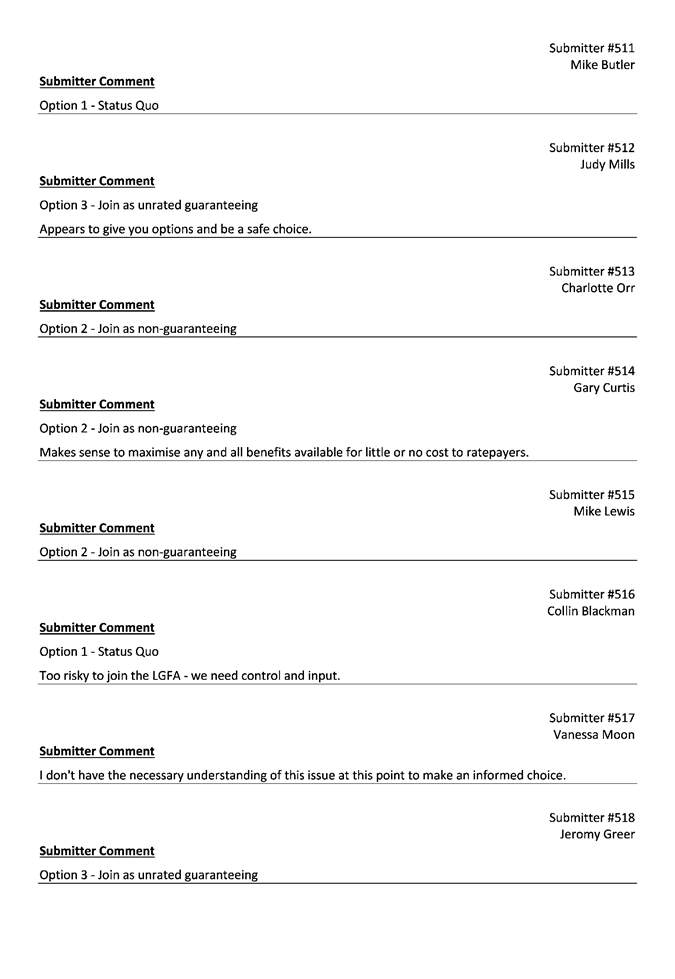

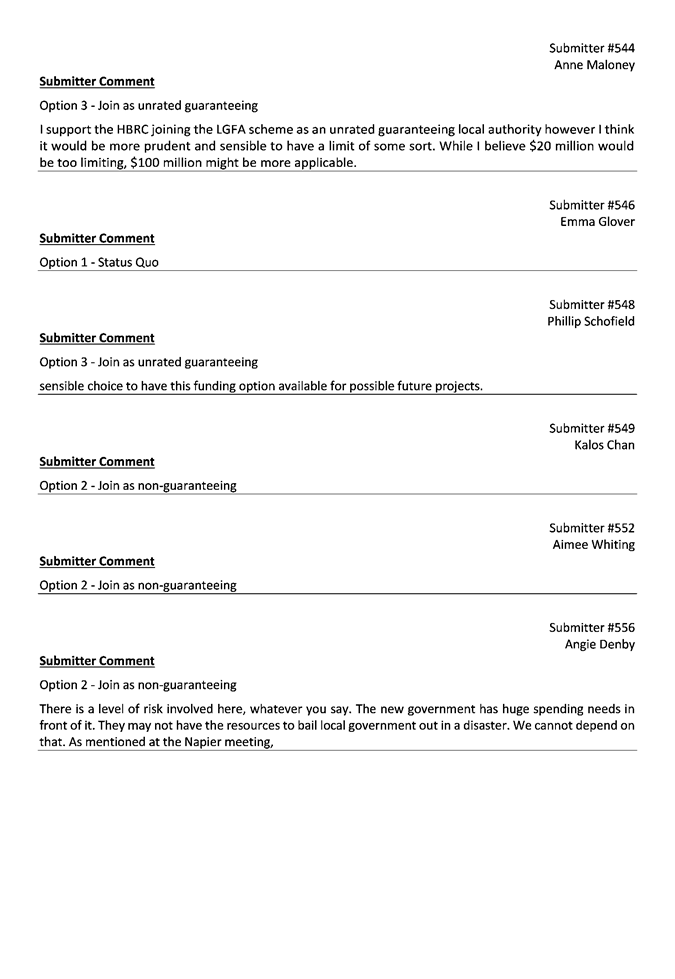
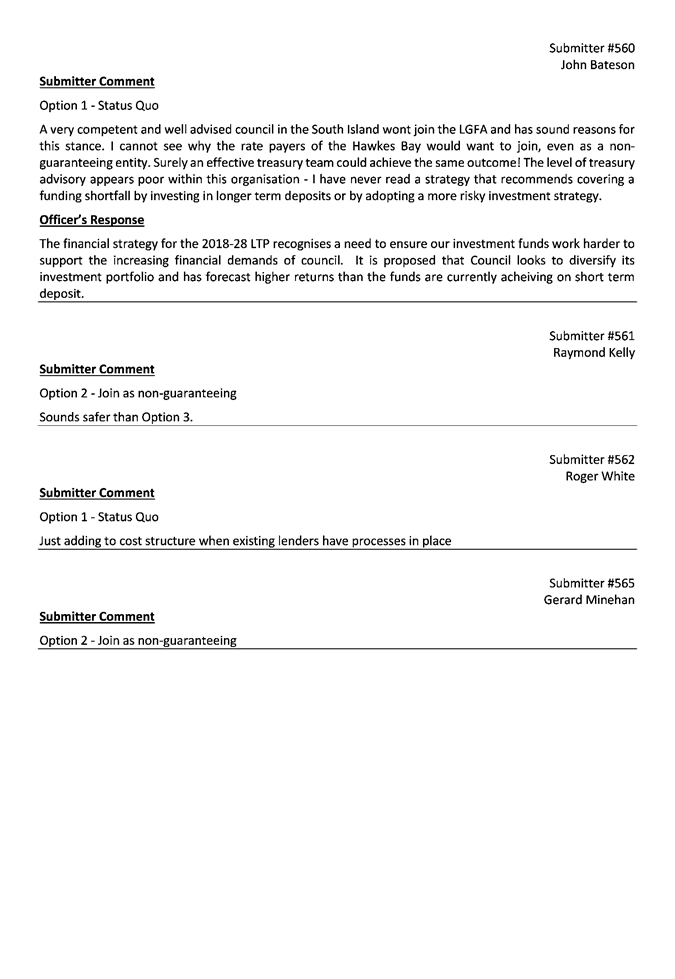
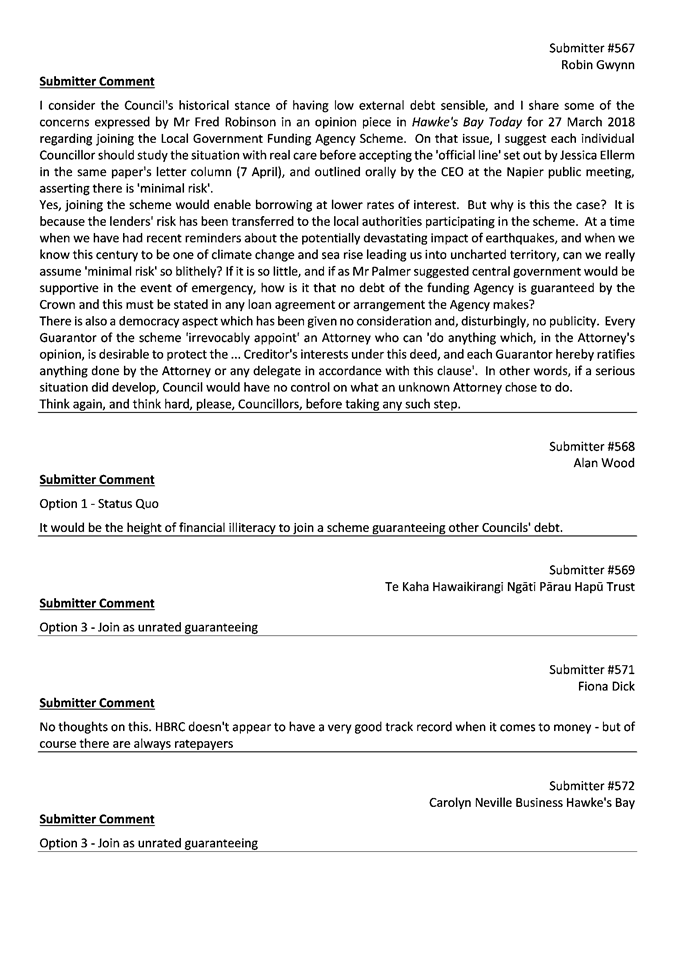
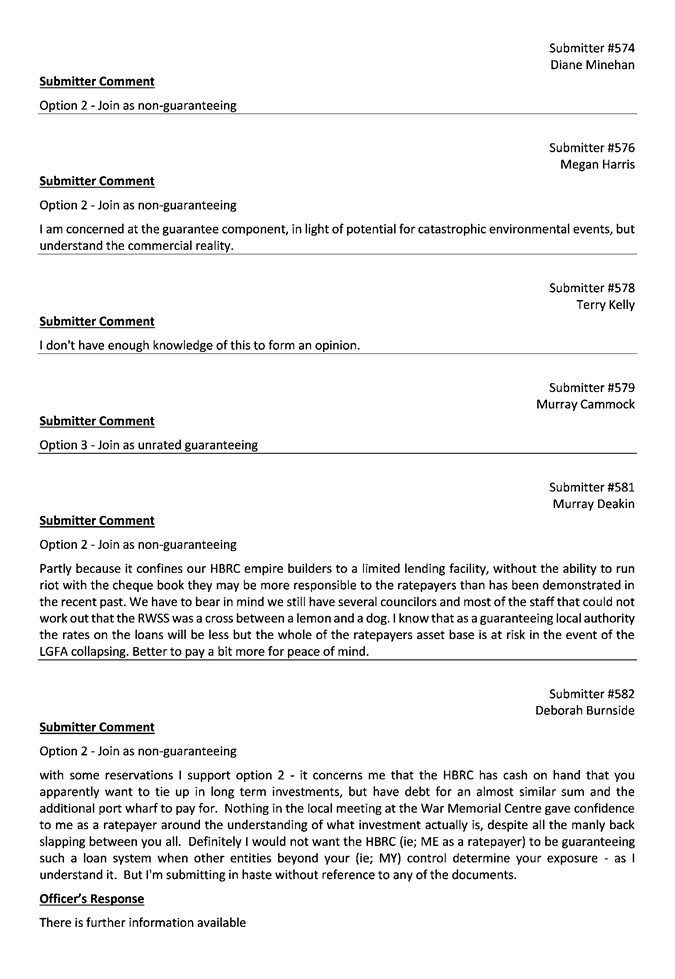
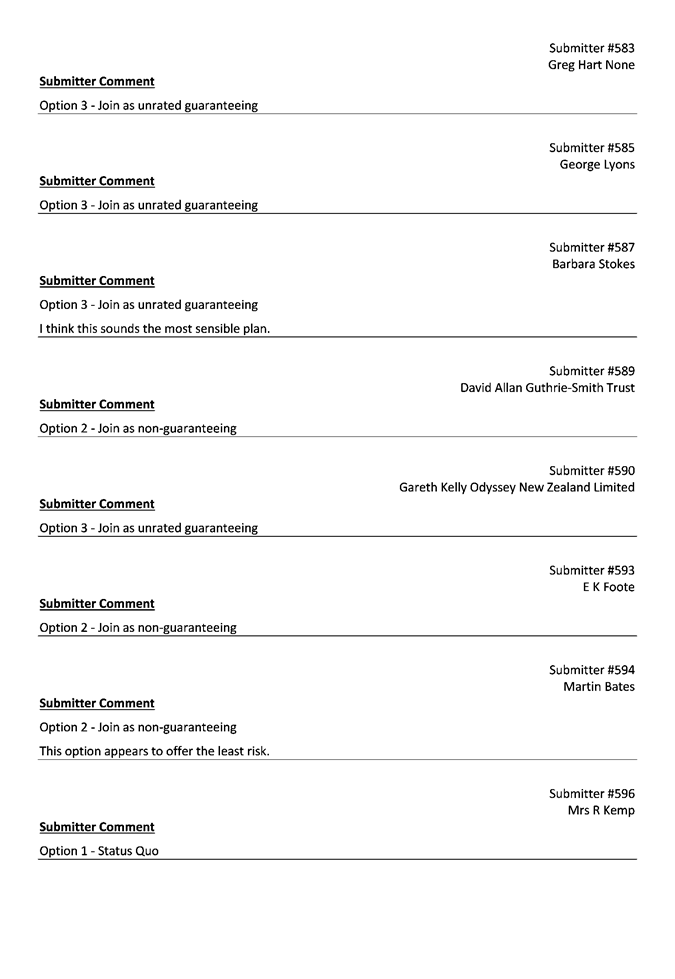


HAWKE’S BAY REGIONAL COUNCIL
Tuesday 22 May 2018
Subject: Regional Assets Group
of Activities
Reason for Report
1. To provide the
Council with an analysis of submissions received in relation to the
“Regional Assets” group of activities through the Facing our
Future 2018-28 Long Term Plan (LTP) consultation period.
Background
2. Analysis of
submissions received related to Regional Assets functions of the Council.
Submissions Received
3. 17 submissions
were received on this topic (see attached).
4. Key themes or
unique points expressed by submitters included:
4.1. Support for
coordinated planning involving community for coastal hazards.
4.2. Comprehensive
plan to reduce region’s contribution to climate change and support best
practice that works with the changes in our environment, rather than fighting
against changes.
4.3. Assistance
for hazard relocation options.
4.4. Some support
for hard engineered coastal protection.
4.5. Request that
HBRC’s LTP includes funds to prepare and obtain a coastal permit to allow
disposal of sand for the purpose of re-nourishing Westshore beach.
4.6. Support for
water quality and land management.
4.7. Request from
Waikato Regional Council for $30,000 per year for three years to fund joint
research into fish passage through flood control and drainage infrastructure.
Officers’
Analysis of Submissions
5. The submissions
in relation to coastal hazards are, or can be, dealt with under the Coastal
Strategy implementation phases. There is still much more work to be done here
and community involvement before decisions can be made.
6. Staff support
the submission to obtain a coastal permit for the purpose of re-nourishing
Westshore Beach. There will need to be investigations, expert advice,
assessment of environmental effects, notification and community engagement as
part of the information to obtain the permit. We do not expect this to be too
big a task, but our estimate is $100,000 to cover costs, excluding staff time.
The expectation would be that NCC share half the costs i.e. $50,000 each. This
would likely take say 2 years to prepare and obtain a permit and the cost could
be spread over 2 or maybe 3 years. This would be subject to the Napier
Port being granted a new dredging consent related to its proposed new wharf.
7. Staff support
the request from Waikato Regional Council for $30,000 over 3 years to carry out
the fish passage investigation.
Proposals
for Consideration
8. That $25,000 is
added to the 2018/19 and 2019/20 budgets (total $50,000), in Project 322
Coastal Processes, to obtain a coastal permit to discharge sand at Westshore
Beach for the purpose of re-nourishment, with the proviso that NCC contribute
an equal amount.
9. That $30,000 is
added to the 2018/19, 2029/20 and 2020/21 budgets (total $90,000), in Project
288 Special Projects, for the purpose of supporting Waikato Regional Council to
carry out the fish passage initiative.
Financial
and Resource Implications
10. The financial impacts of
these submissions are:
|
|
Additional
spend
|
|
|
Yr1
2018-19
|
Yr2
2019-20
|
Yr3
2020-21
|
Cumulative over 3 years
|
|
Coastal permit for
re-nourishment of Westshore Beach - Project 322 (General Fund)
|
$25,000
|
$25,000
|
-
|
$50,000
|
|
WRC fish passage
initiative - Project 288 (Targeted rate – HP Scheme)
|
$30,000
|
$30,000
|
$30,000
|
$90,000
|
|
Total rating impact
$
|
$55,000
|
$55,000
|
$30,000
|
$140,000
|
|
Total rating impact
%
|
0.29%
|
0.23%
|
0.10%
|
|
Decision Making Process
11. Council
is required to make every decision in accordance with Part 6 Sub-Part 1, of the
Local Government Act 2002 (the Act). Staff have assessed the requirements
contained within this section of the Act in relation to this item and have
concluded:
11.1. Section
93(A) of the Act provides for the use of a special consultative procedure in
relation to the adoption of a Long Term Plan as prepared under section 93 of
the Act.
11.2. The issues to be
considered in this paper are those issues raised by members of the community
that have submitted to the Council on the Consultation Document “Facing
Our Future 2018-28”. All submissions are an integral part of the special
consultative processes set out in Section 83 and 85 of the Local Government Act
2002.
|
Recommendations
That the
Hawke’s Bay Regional Council:
1. Receives and notes the “Regional Assets” staff report.
2. Considers the submission points made relating to the
“Regional Assets Group of Activities” and any comments made by Council officers.
3. Agrees to the staff recommendation that $25,000 funding is
included in the 2018-19 and 2019-20 budgets (Total $50,000), (Project 322
Coastal Processes) to obtain a coastal permit to discharge sand at Westshore
Beach for the purpose of re-nourishment.
4. Agrees to the staff recommendation that $30,000 funding is
included in the 2018-19, 2019-20 and 2020-21 budgets (Total $90,000),
(Project 288 HP Scheme), to support the Waikato Regional Council to carry out
the fish passage initiative.
OR
5. Does
not agree to include $25,000 funding in the 2018-19 and 2019-20 budgets to
obtain a coastal permit to discharge sand at Westshore Beach for the purpose
of re-nourishment.
6. Does not agree to include $30,000 funding in the 2018-19, 2019-20
and 2020-21 budgets to support Waikato Regional Council to carry out the fish
passage initiative.
|
Authored by: Approved
by:
|
Gary Clode
Acting
Group Manager
Regional Assets
|
James Palmer
Chief
Executive
|
Attachment/s
|
⇩1
|
Submitters Comments & Officer's
Responses related to Regional Assets Group of Activities
|
|
|
|
Submitters
Comments & Officer's Responses related to Regional Assets Group of
Activities
|
Attachment 1
|

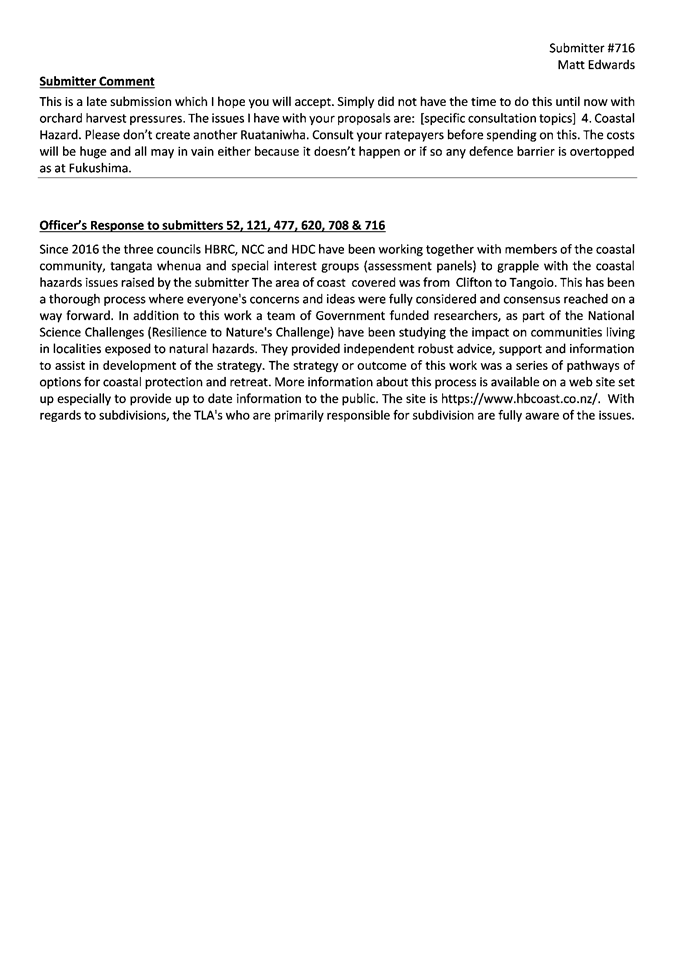

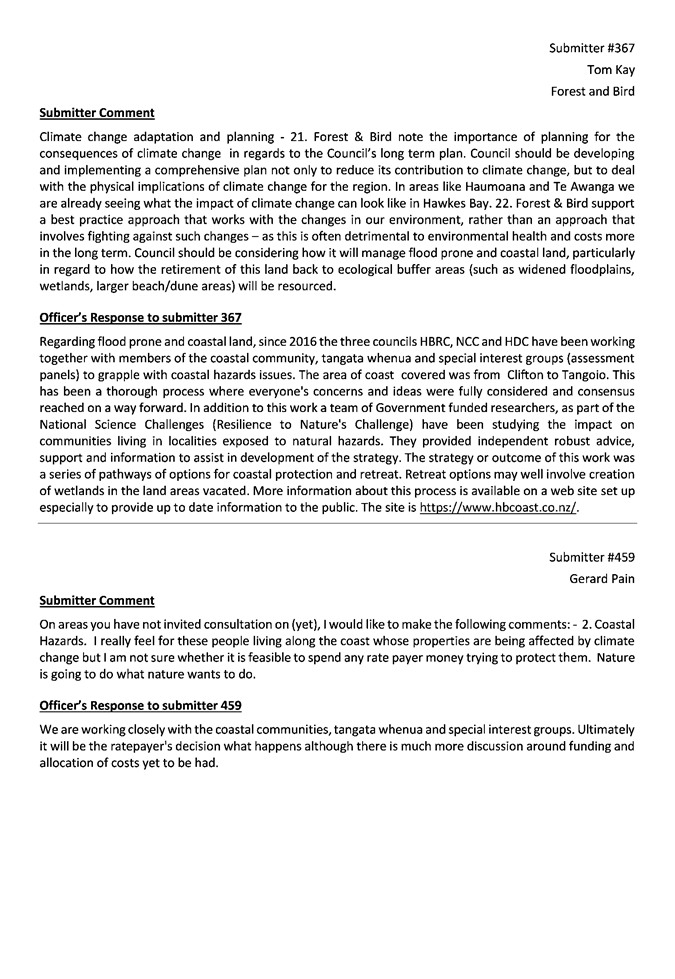
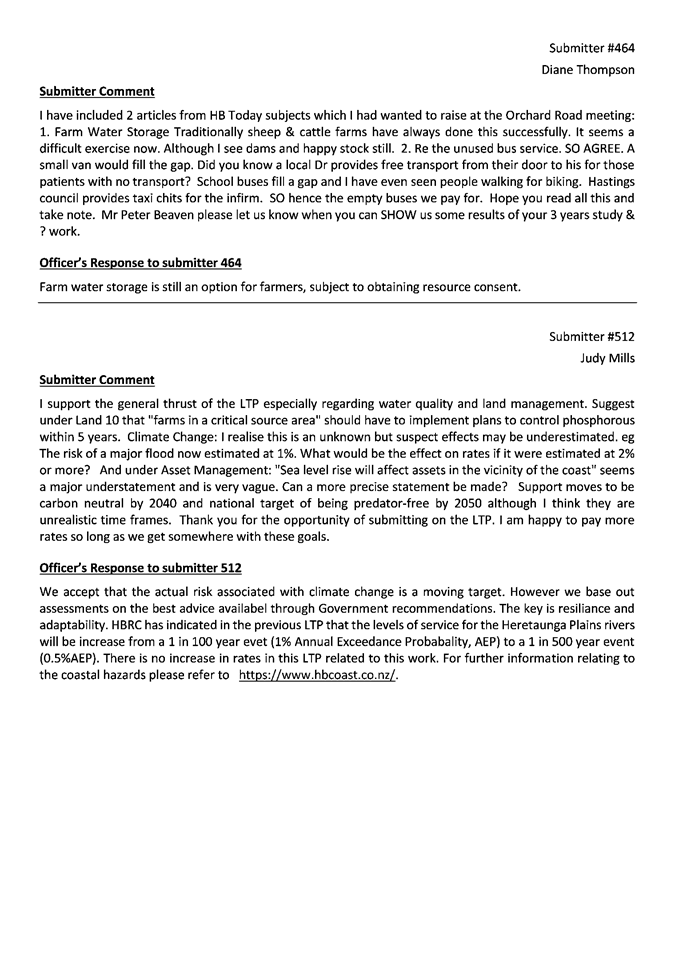
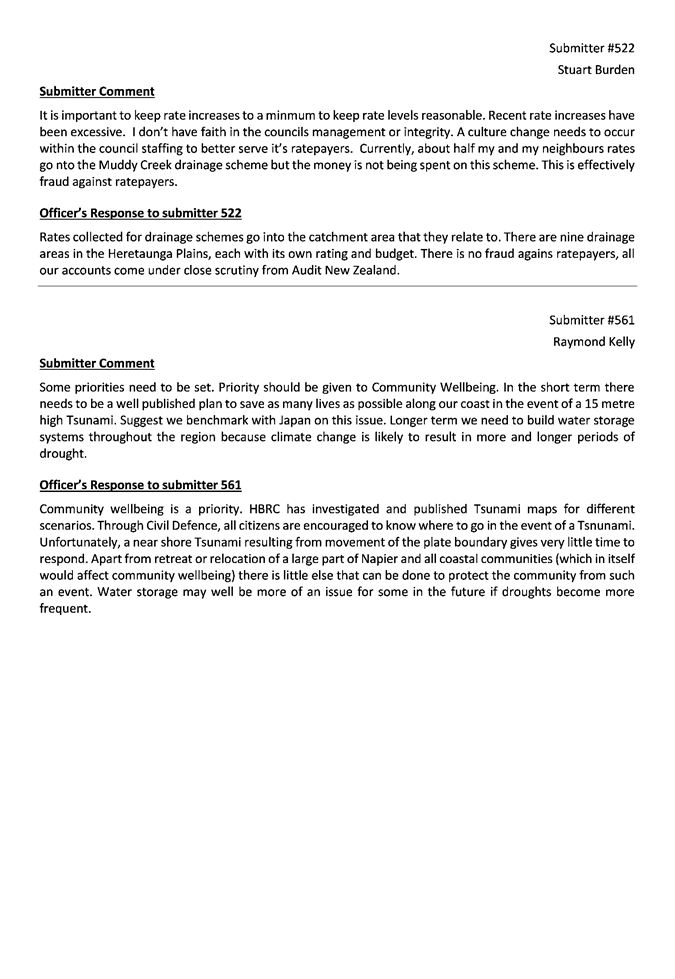
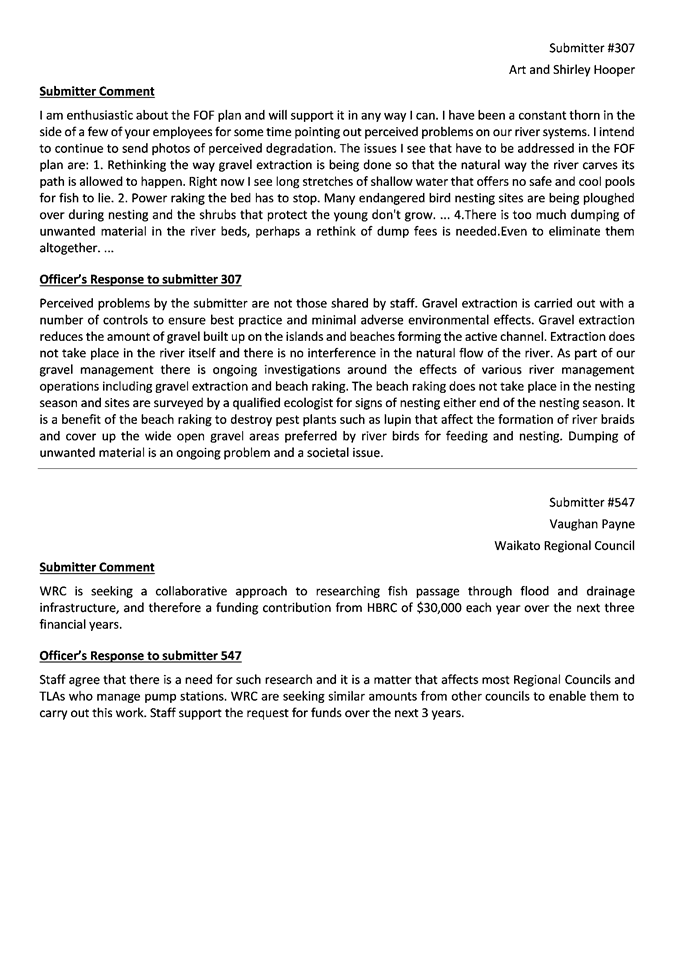
HAWKE’S BAY REGIONAL COUNCIL
Tuesday 22 May 2018
Subject: Integrated Catchment
Management Group of Activities
Reason for Report
1. To provide the
Council with an analysis of submissions received in relation to the
“Integrated Catchment Management” group of activities through the Facing
our Future 2018-28 Long Term Plan consultation period.
Background
2. Analysis of
submissions received related to Integrated Catchment Management functions
of the Council.
Submissions Received
3. 41 submissions
(attached) were received on this topic.
4. Key themes or
unique points expressed by submitters included:
4.1. General
– Some submitters raised concerns about the costs and potential rates
impact. There was a request for an expanded Regional Park at
Tutira. There was a request for a contestable fund for environmental
education. That resourcing was made available to support water security
within the Tukituki catchment.
4.2. Biosecurity
– Concerns were raised about the level of biosecurity funding and the
species of interest in this programme. Wish to prohibit the use of 1080
poison.
4.3. Biodiversity
– support was expressed for the proposed programme and the level of
resourcing.
4.4. Catchment
Management – support was expressed for the proposal including the
scale and pace of the reforestation proposal. Concerns raised that the
planting should be all native. Concern that the commercial forestry
should be left to the private sector. Concern about the broader social
and infrastructural impacts as a result of forestry. The inclusion of
environment specific performance targets.
4.5. Environmental
Science – support was expressed for the proposed work to investigate
our groundwater resources. Desire for additional resourcing for cultural
or matauranga monitoring.
Officers’
Analysis of Submissions
General
5. Consistent with
the specific sections on the detailed proposals submitters to this group of
activities section raised concerns about equity of where the costs fell and a
view that those creating the problem (landowners) should carry the full cost of
remediation. For the reasons noted in both of the Land/Water/Biodiversity
sections, staff support an approach that has both urban and rural ratepayers
contributing to the cost of the programme.
6. HB has 4
Regional Parks recognised by the Hawke’s Bay Regional Council through the
HBRC Regional Park Network Plan since December 2013 (Pekapeka, Pakowhai,
Waitangi and Tutira). The idea of creating a larger regional park at
Tutira than what is there presently was proposed informally around 2015 through
the Tutira Maungaharuru Forum. The thinking at the time was to include HBRC
land (the existing Tutira Regional Park plus Waihapua), Guthrie Smith and Lake
Tutira. Due to the complexity of ownership issues relating to the lake the idea
was “parked”. Staff consider that establishing a
“Super” regional park at Tutira has merit and could be progressed
by omitting the lake Tutira footprint initially. Additional work will be
required confirming the benefits of a larger, multiple ownership, Regional Park
at Tutira. Investigations would need to be resourced. Currently nothing
is allocated for work along these lines and staff do not consider this issue
should be advanced at this time.
7. Council will
continue to support and guide the landowners within the Tukituki catchment
affected by the new policy to support the successful implementation of the
policy. A $5 million dollar capital fund has been included in the LTP to
support investigation and feasibility of water storage/augmentation/aquifer
recharge, some of which is anticipated to be invested in the Tukituki
catchment.
8. Environmental
Education and facilitation of the Enviroschools Programme have current focus in
the Community Engagement team of HBRC. A more coordinated approach to education
for sustainability is currently under discussion, between HBRC and other local
agencies, including the region’s city and district councils, Sustaining
HB Trust/ Environment Centre HB, EIT, the Department of Conservation, Fish and
Game, etc. While not publicly referenced in the Facing our Future document, a
stronger focus on environmental education and coordination is proposed. This
objective will become the sole focus of one member of staff in the Community
Engagement team, with effect from 1 July 2018.
Biosecurity
9. Hawkes Bay
regional Councils spends a significant amount of resource managing plant pests
including biodiversity plants such as Old Mans Beard, Japanese Honeysuckle and
Pinus Contorta. Plant pests do require a considered commitment before
committing to control programmes however as the seed beds often mean control
programmes need to continue for decades to have enduring impact. HBRC also
invests collectively with other regional councils in Biocontrols which are an
effective long term solution to plant pests.
10. HBRC supports communities
who want to undertake Argentine ant control through bait subsidies and advice.
Mothplant is not currently on the regional pest management plan but HBRC have
received submissions and are reviewing its pest status.
11. The animal pest rates fund
a range of directly available services for our farming community including
subsidised baits and material, up to 50% of the cost of larger rabbit control
operations, support for on farm biodiversity programmes and advice and support
for possum control.
12. Hawkes Bay Regional
Council makes very limited use of aerial 1080 for pest management and does so
with the agreement of the landowner. The Regional Pest Management Plan process
which is being reviewed concurrently to the Long Term Plan includes a cost
benefit analysis as part of the process to determine if pests should be
included.
Biodiversity
13. Staff acknowledge and
appreciate the support for the proposed activity to improve the regions
biodiversity
Catchment
Management
14. There is majority support
for the scale and pace that is proposed for this work. Submitters have
also confirmed the need to direct landowner engagement as a factor for success.
15. A minority consider the
scale and space to be unwarranted or unnecessary. Staff disagree and have
the view that Councils monitoring confirms that the scale and pace of change
has been significantly short of what is required.
16. Staff acknowledge the
desire for all native plantings as part of the reforestation initiative.
In many situations natives would be entirely appropriate. In many
situations they will not. Ultimately the decision on this will lay with
the landowner. Staff will be promoting the use of native species where
appropriate and supported but not at the cost of reforestation occurring on a
property.
17. Commercial investment by
Council into forestry is not subject to consultation in the current LTP.
18. Staff acknowledge the
potential impacts of land use change, including forestry on communities.
In this current year financial year work is already underway to understand this
and therefore set strategies to minimise the impact of any land use change.
19. The development of
catchment specific objectives and outcomes for the Catchments team will be
developed in each catchment over time through a community driven non-statutory
Integrated Catchment Management plan. Supporting this is Council’s
non-statutory Strategic Plan that has set a range of goals for water quality
and sustainable land use. Staff consider that an approach that engages
the broad catchment community in setting outcomes is a critical factor for successful
implementation of this programme.
Environmental
Science
20. Council is currently
supporting the development of a matauranga monitoring framework with Te
Taiwhenua O Heretaunga. This work is being completed from with existing
budgets. Staff consider that the implementation of any approaches that
come from this can be accommodated within existing budgets. Staff also
anticipate approaching this in a partnership model with tangata whenua and
supporting them to undertake their own monitoring.
Decision Making Process
21. Council
is required to make every decision in accordance with Part 6 Sub-Part 1, of the
Local Government Act 2002 (the Act). Staff have assessed the requirements
contained within this section of the Act in relation to this item and have
concluded:
21.1. Section
93(A) of the Act provides for the use of a special consultative procedure in
relation to the adoption of a Long Term Plan as prepared under section 93 of
the Act.
21.2. The issues to be
considered in this paper are those issues raised by members of the community
that have submitted to the Council on the Consultation Document “Facing
Our Future 2018-28”. All submissions are an integral part of the special
consultative processes set out in Section 83 and 85 of the Local Government Act
2002.
|
Recommendations
That the
Hawke’s Bay Regional Council:
1. Receives and notes the “Integrated
Catchment Management” staff report.
2. Considers the submission points made relating to “Integrated Catchment Management” and
any comments made by Council officers.
|
Authored by:
|
Iain Maxwell
Group Manager
Resource Management
|
|
Approved by:
|
James Palmer
Chief Executive
|
|
Attachment/s
|
⇩1
|
Integrated
Catchment Management Group of Activities related submissions
|
|
|
|
Integrated
Catchment Management Group of Activities related submissions
|
Attachment 1
|
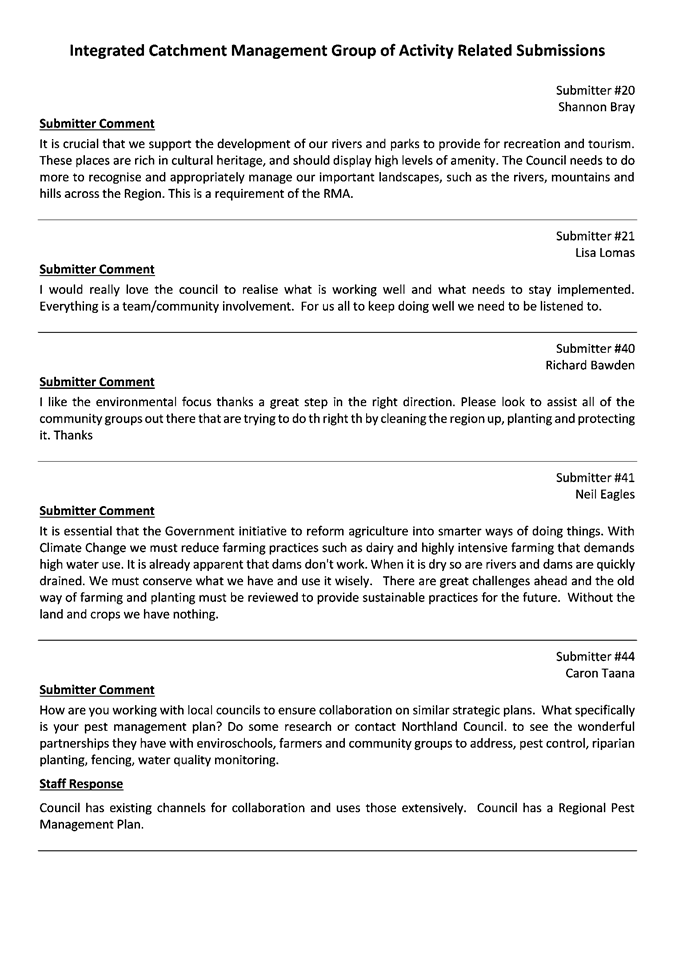
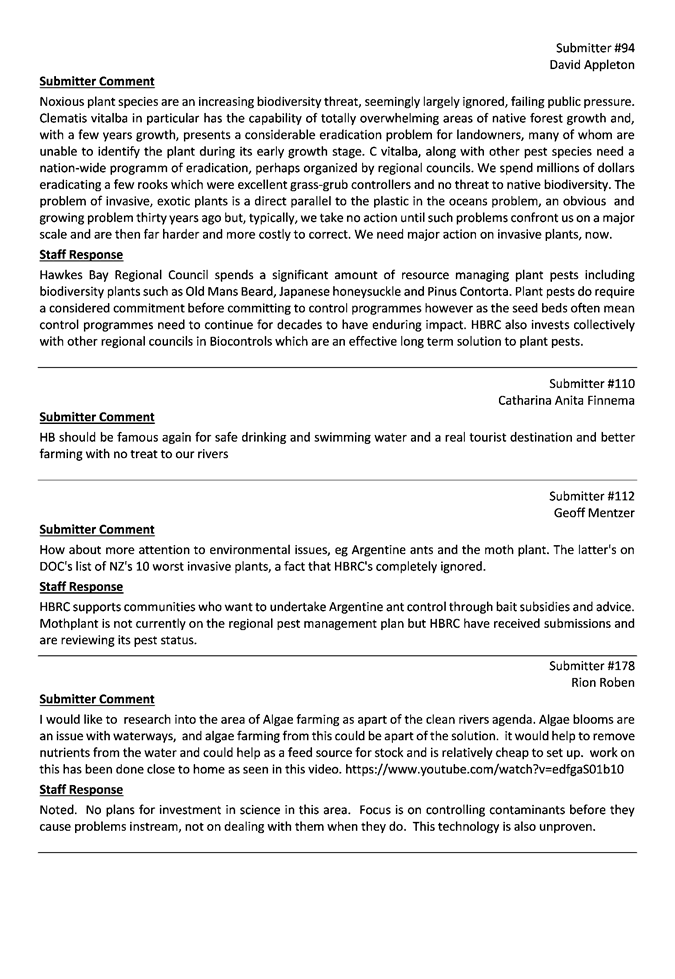

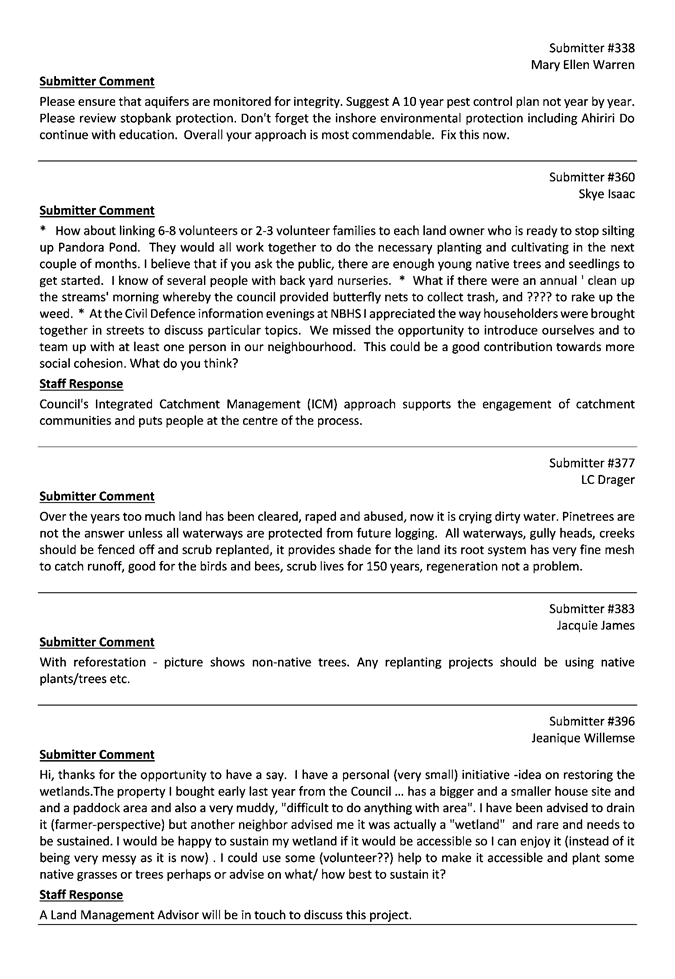
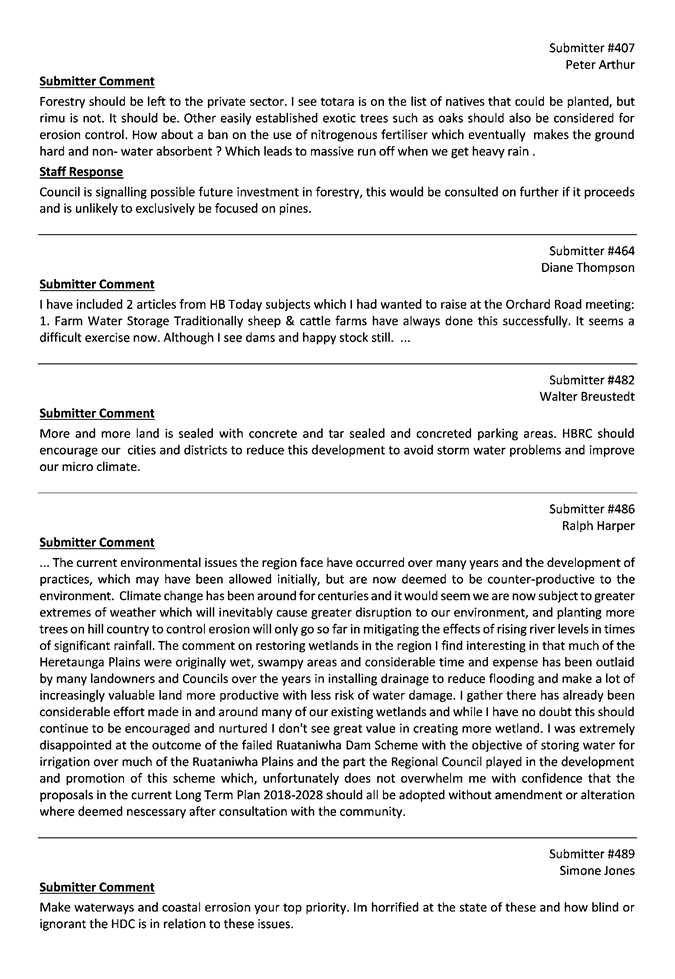
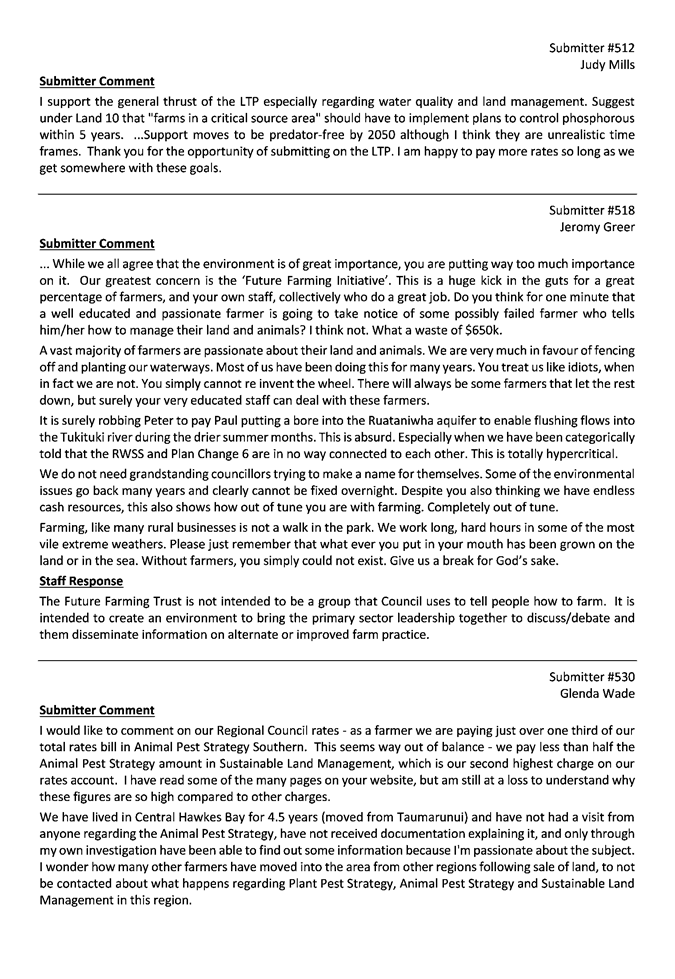

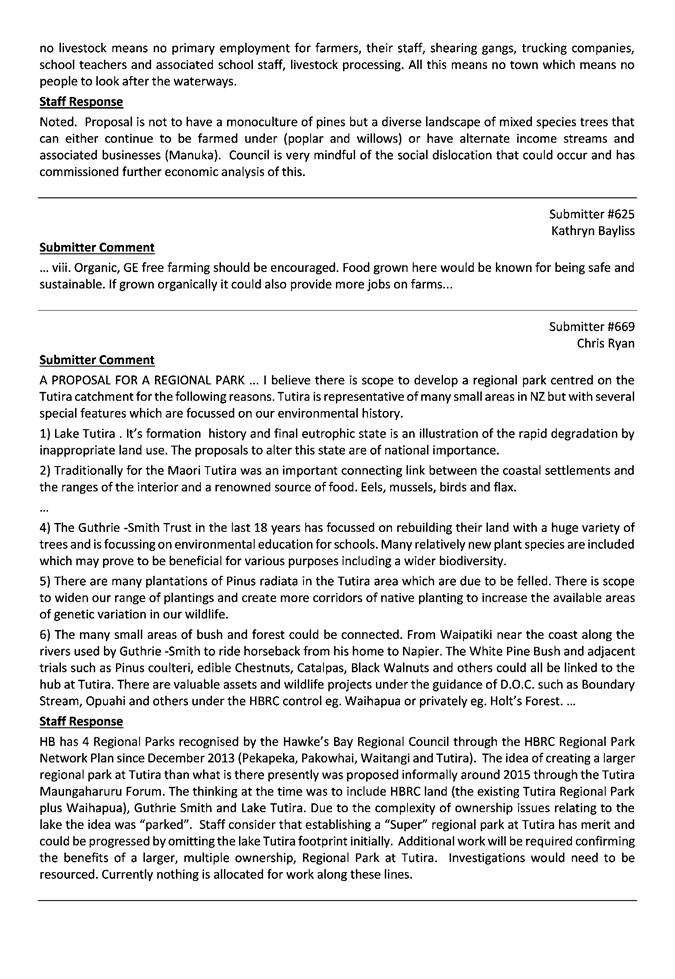
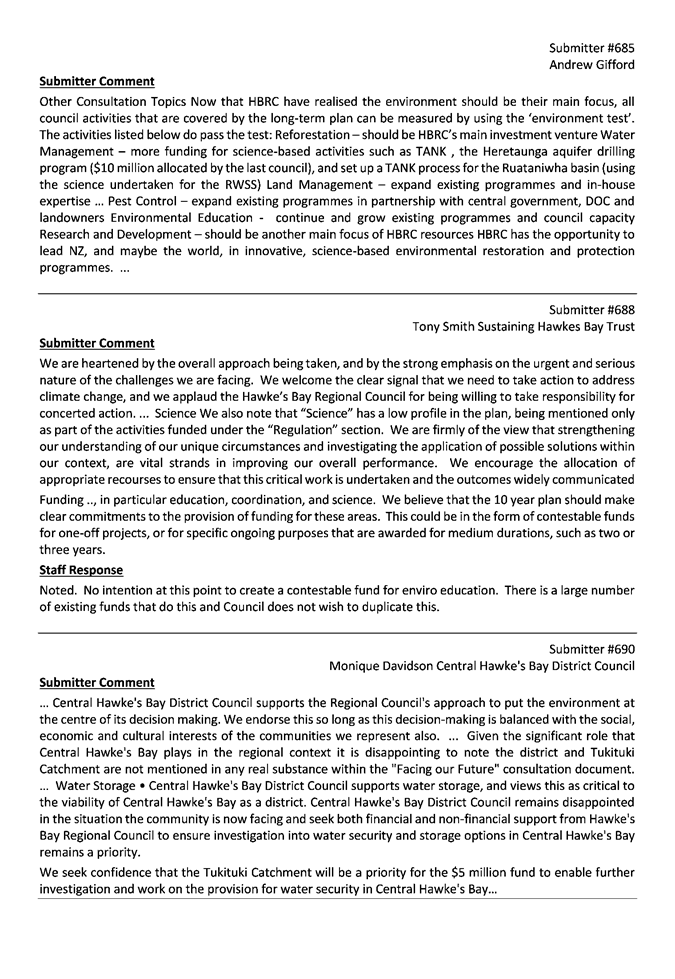
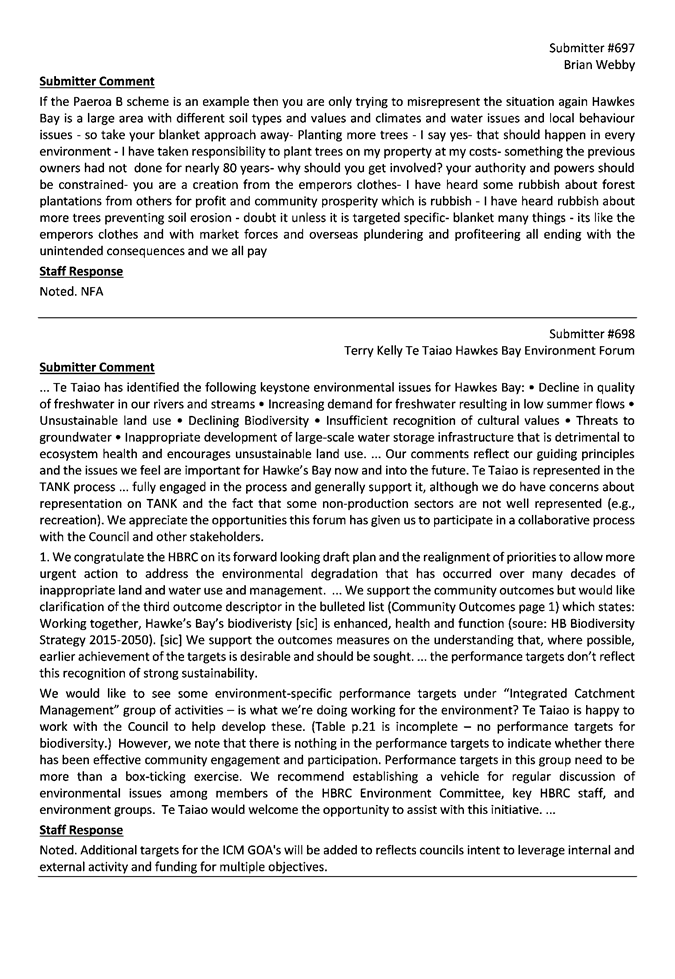
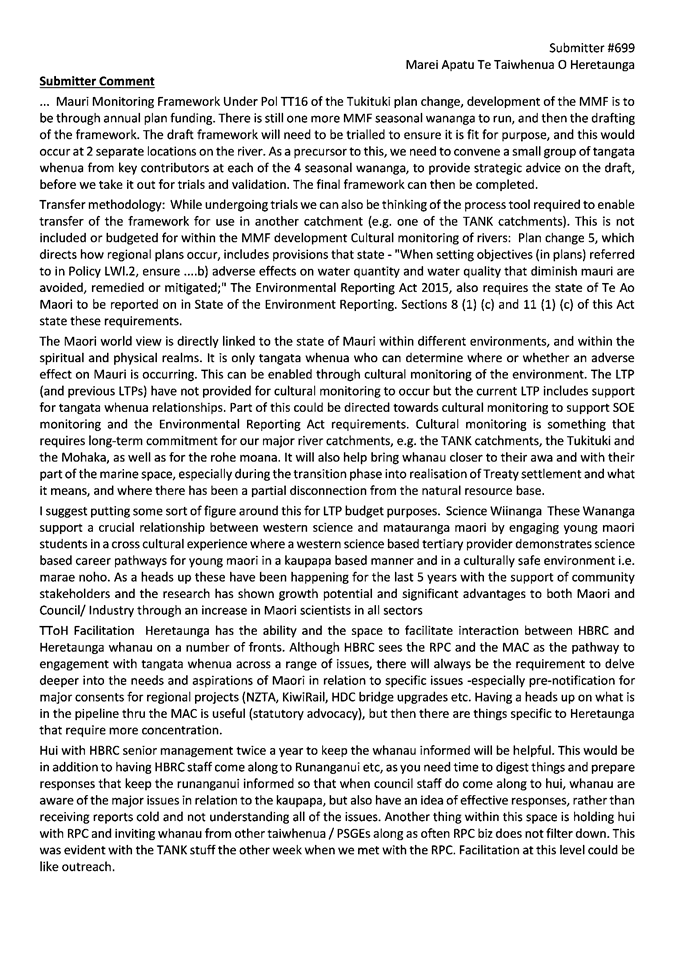

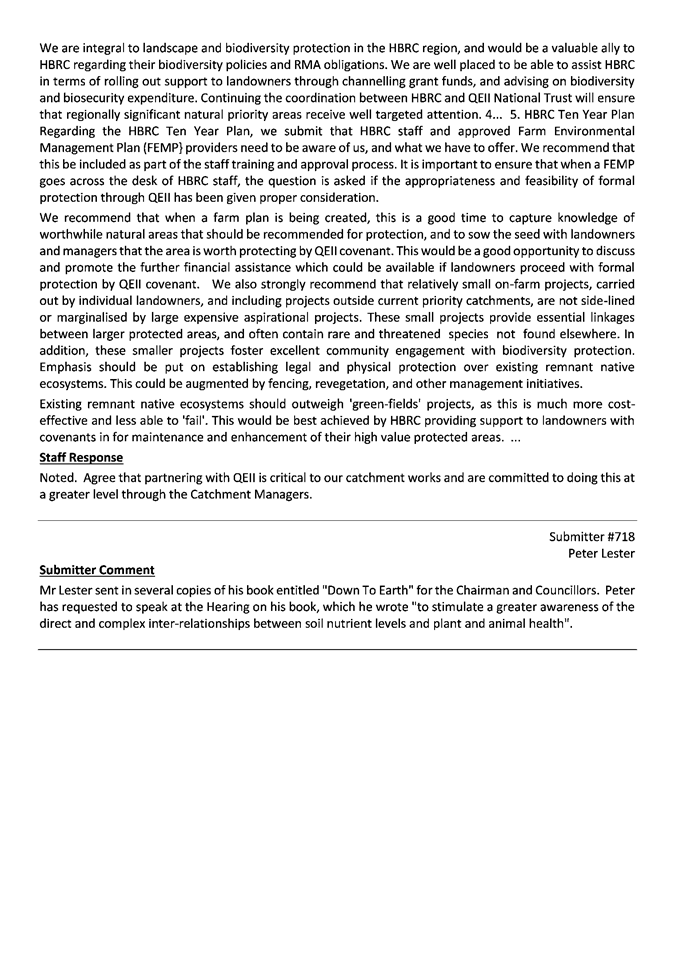
HAWKE’S BAY REGIONAL COUNCIL
Tuesday 22 May 2018
Subject: Strategic Planning
Group of Activities
Reason for Report
1. To provide the
Council with an analysis of submissions received in relation to the
“Strategic Planning” group of activities through the Facing our
Future 2018-28 Long Term Plan consultation period.
Background
2. Analysis of
submissions received related to Strategic Planning and Transport functions of
the Council.
Submissions Received
3. 43 submissions
were received on this topic (see attached). A small number of submissions (or
parts of them) related to issues beyond the responsibility of a Regional
Council.
4. Key themes or
unique points expressed by submitters included:
4.1. Napier
Port: a number of submitters addressed the ownership of the Port and will
be advised that no decision has been made or will be made until full public
consultation takes place.
4.2. Transport:
Consistent with previous years there remains a degree of confusion about
HBRC’s role in public transport and/or the funding model that sits behind
the operation of passenger transport programmes.
4.3. Freshwater
Management Policy: A small number of submissions addressed Council’s
activities in freshwater management policy and planning, some concerned that
the changes are too onerous and others concerned that more needs to be done.
Submitters supported the extension of the $5m Ngaruroro water storage
feasibility funding to whole-of-region initiatives.
4.4. Climate
Change: A number of submitters felt that this subject did not have
sufficient prominence in the LTP.
4.5. Funding
for Socio-Economic Development: A small number of submitters felt that
while the LTP is environmentally aspirational, more leadership is required
around both social and economic well-being. It was felt that sustainability can
best be achieved when the three pillars - social,
environmental and economic or often referred to as people, planet and profit -
enjoy equal priority.
Officers’
Analysis of Submissions
5. Neither
Strategic Planning nor Transport were matters for specific consultation. Apart
from Port ownership, the matters raised by submitters are broadly consistent
with the issues that staff deal with in relation to their day to day
activities.
6. The submissions
on Port ownership, highlights the need for Council to have a comprehensive and
well organised public communication and consultation plan on this issue.
7. The LTP
represents a modification to the economic development role it has played, in
tandem with other local authorities and regional stakeholders, in recent
years. This reflects the desire by Council, as set out in its Strategic
Plan 2017-2021, to focus resourcing on addressing a wide and complex range
of environmental issues as proposed throughout the LTP.
8. In
doing so, however, staff do not agree with the view that it is scaling back its
commitment to regional economic development. Staff perceives HBRC’s
primary role in the realm of regional economic prosperity as not so much to
target new growth initiatives (as has traditionally been the case across all
agencies across the region), rather to first and foremost ensure that the
economy does not shrink as a result of poor resource management and
stewardship. This approach is supported by research that demonstrates that “improved
long run economic performance has occurred primarily through a decline in the
rate and frequency of shrinking, rather than through an increase in the rate of
growing” (source: https://www.nuffield.ox.ac.uk/users/Broadberry/Growing%20Shrinking%20v3.pdf).
That is to say, avoiding losses by ensuring the long-term
sustainability and certainty of the region’s resource platform will have
a longer term positive impact on the region growth.
9. In terms of
supporting the growth side of the equation, HBRC activities in the space
include: its support of Business Hawke’s Bay and the Business Hub, the
management of the Regional Business Partner Contract, participation in Matariki
REDS, and long-term support for the good management and growth of the Port of
Napier.
Proposals
for Consideration
10. The final Long Term Plan
document to include a specific section detailing Council’s approach to
addressing Climate Change across its groups of activities as well as its
commitment to support the region’s future ambition for carbon neutrality.
Decision Making Process
11. Council
is required to make every decision in accordance with Part 6 Sub-Part 1, of the
Local Government Act 2002 (the Act). Staff have assessed the requirements
contained within this section of the Act in relation to this item and have
concluded:
11.1. Section
93(A) of the Act provides for the use of a special consultative procedure in
relation to the adoption of a Long Term Plan as prepared under section 93 of
the Act.
11.2. The issues to be
considered in this paper are those issues raised by members of the community
that have submitted to the Council on the Consultation Document “Facing
Our Future 2018-28”. All submissions are an integral part of the special
consultative processes set out in Section 83 and 85 of the Local Government Act
2002.
|
Recommendations
That the
Hawke’s Bay Regional Council:
1. Receives and notes the “Strategic
Planning” staff report.
2. Considers the submission points made relating to the Strategic Planning group of activities and
any comments made by Council officers.
|
Authored by:
|
Tom Skerman
Group Manager
Strategic Development
|
|
Approved by:
|
James Palmer
Chief Executive
|
|
Attachment/s
|
⇩1
|
Strategic
Planning Group of Activities submissions
|
|
|
|
Strategic
Planning Group of Activities submissions
|
Attachment 1
|

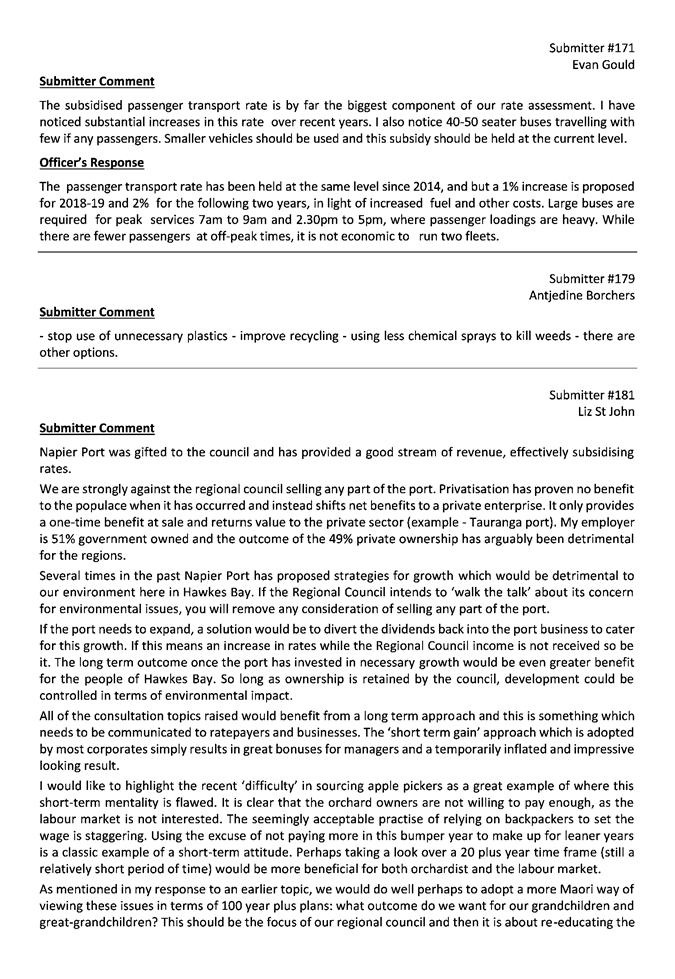
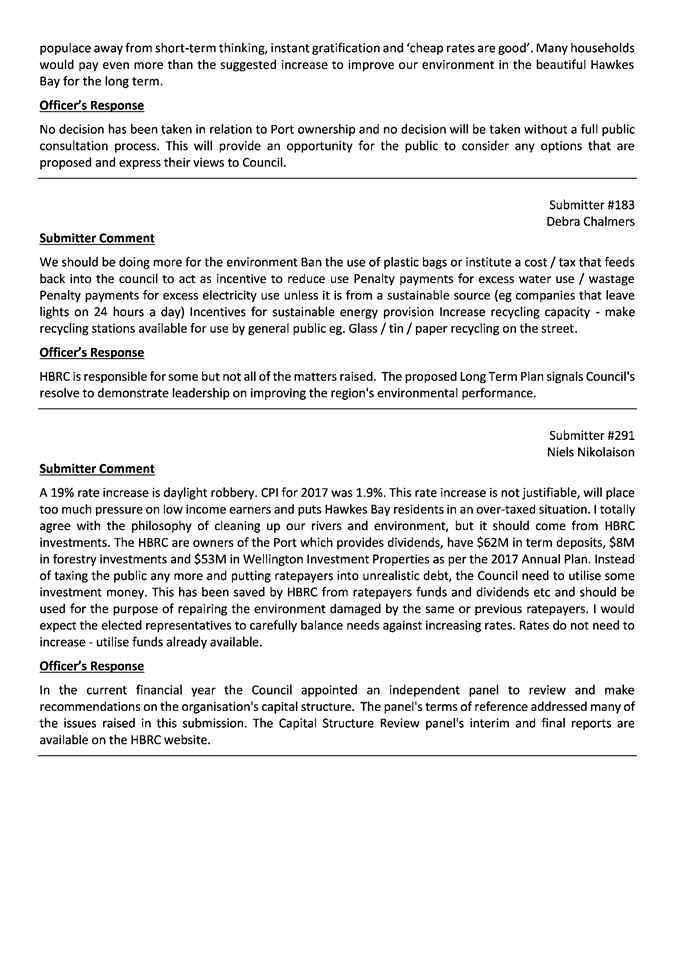
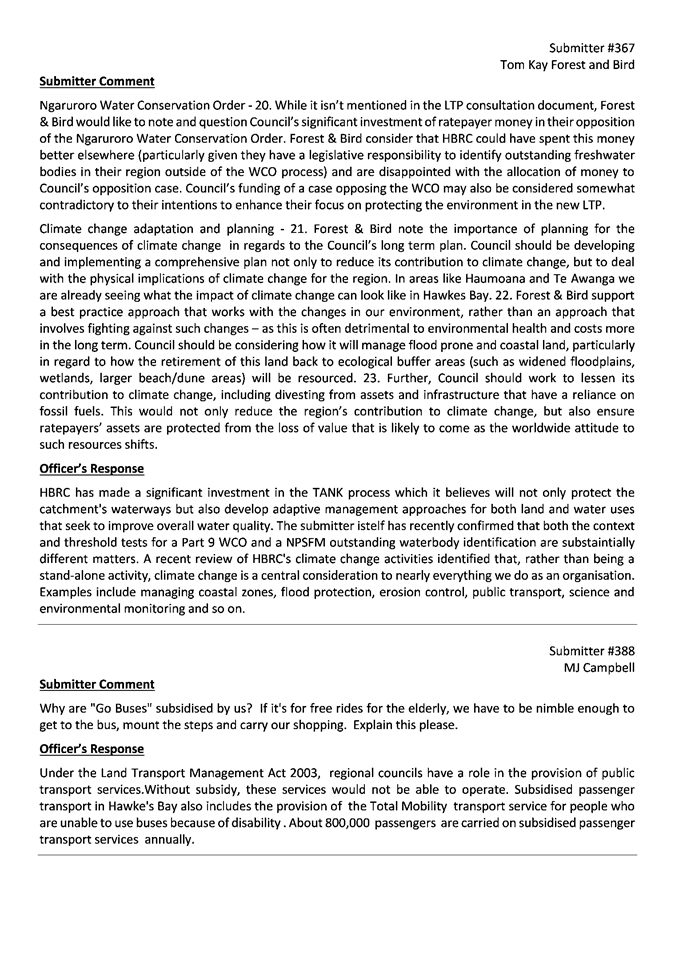

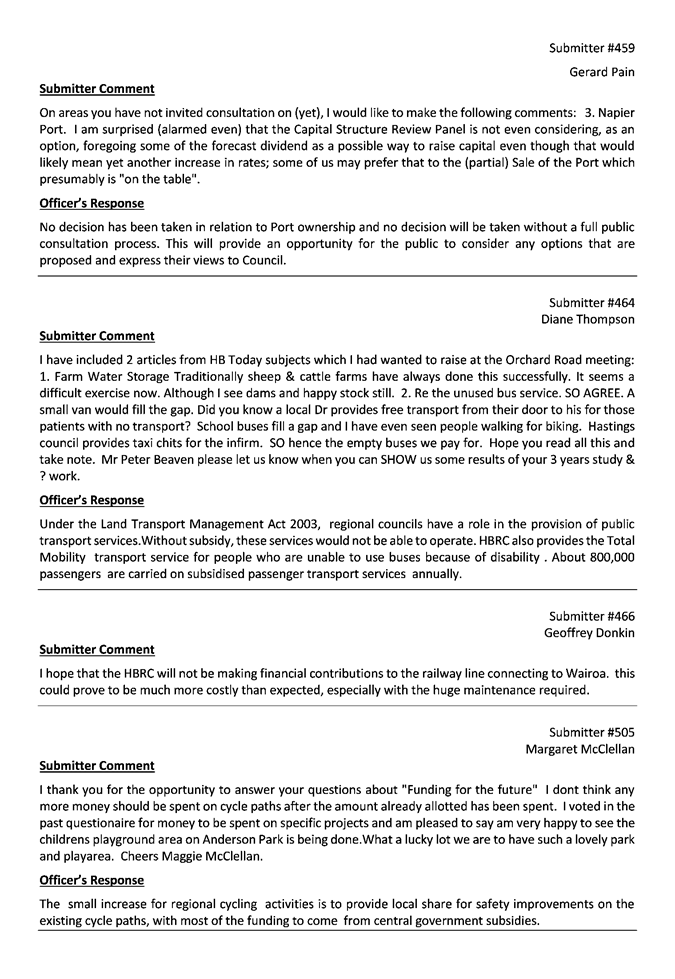


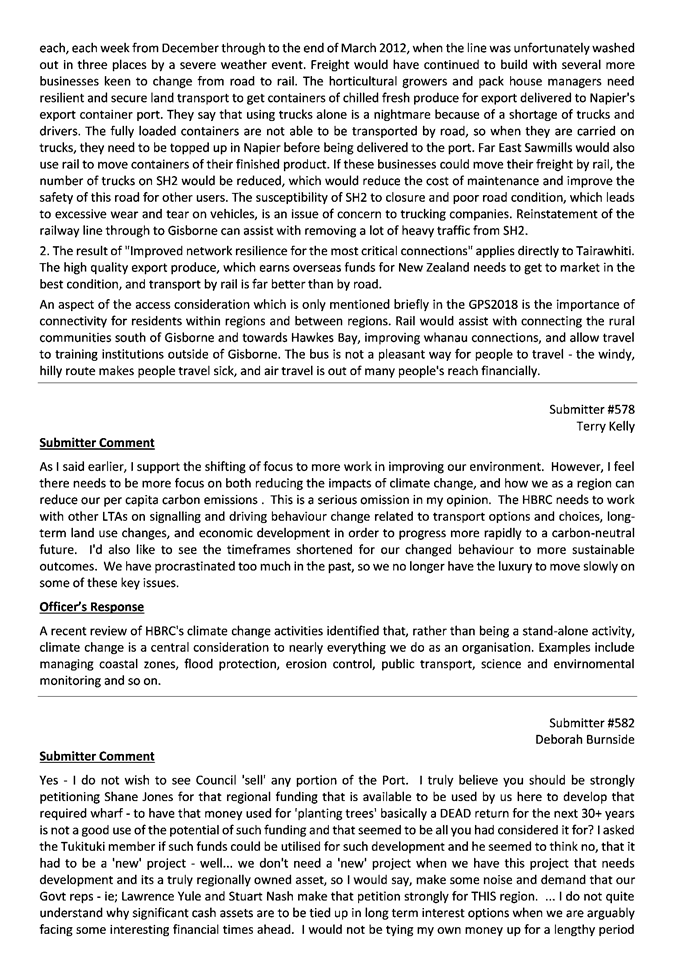
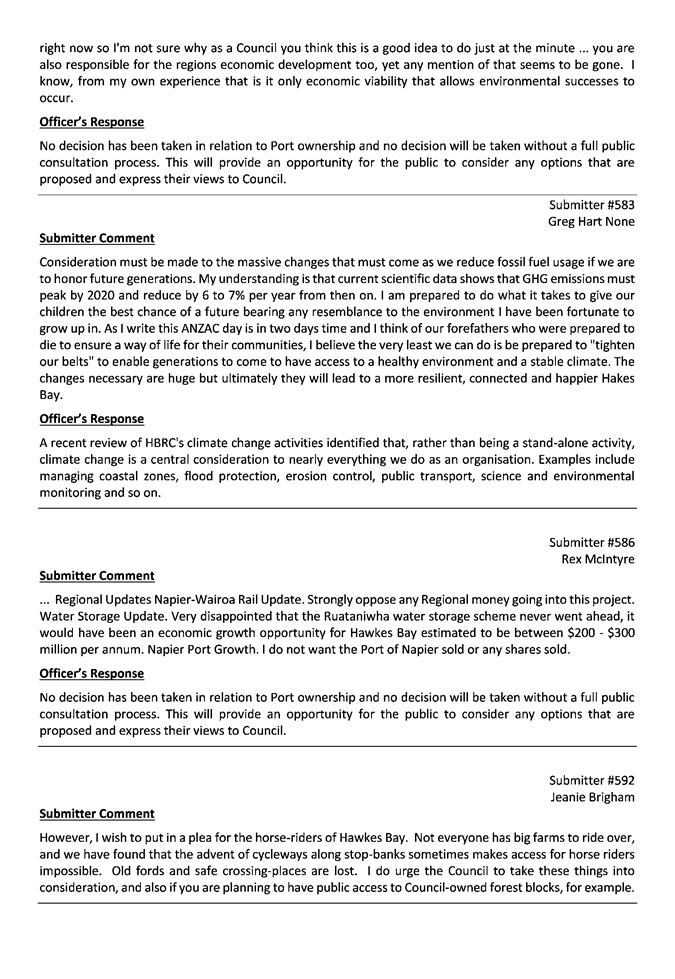
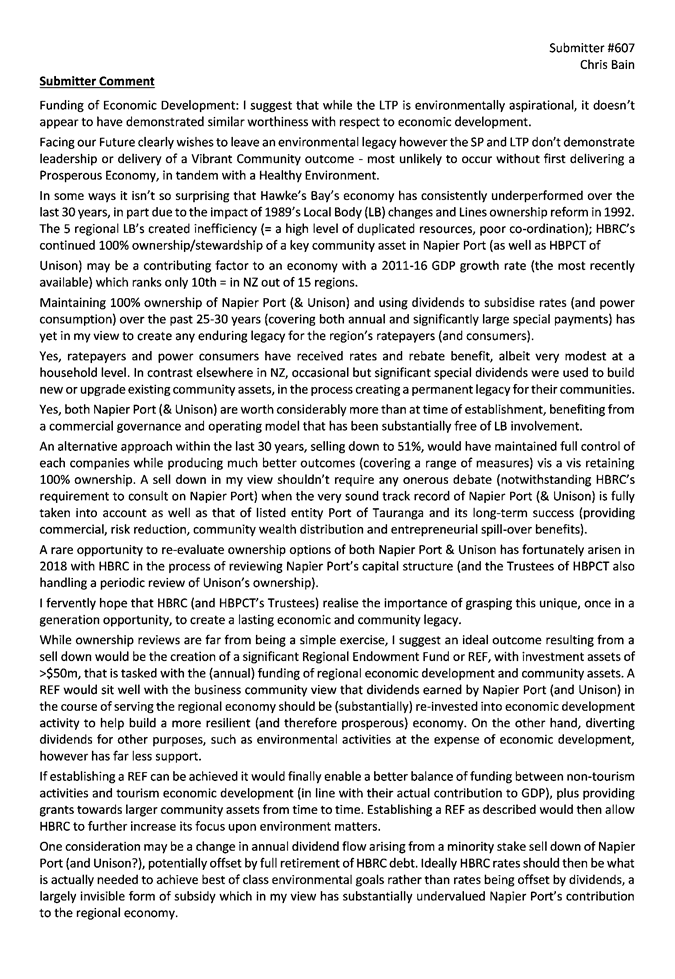
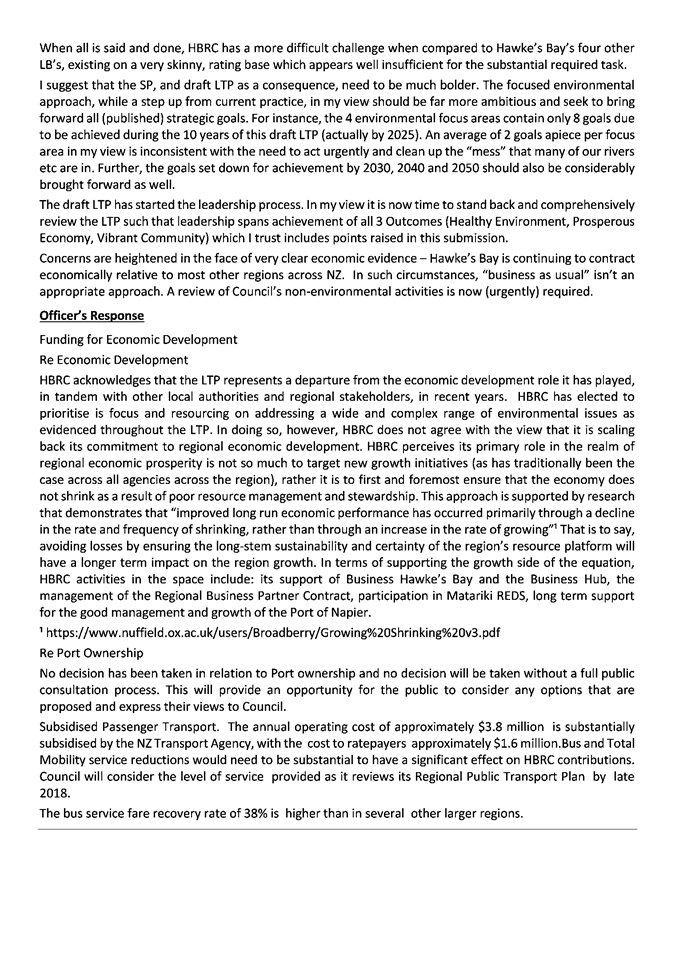

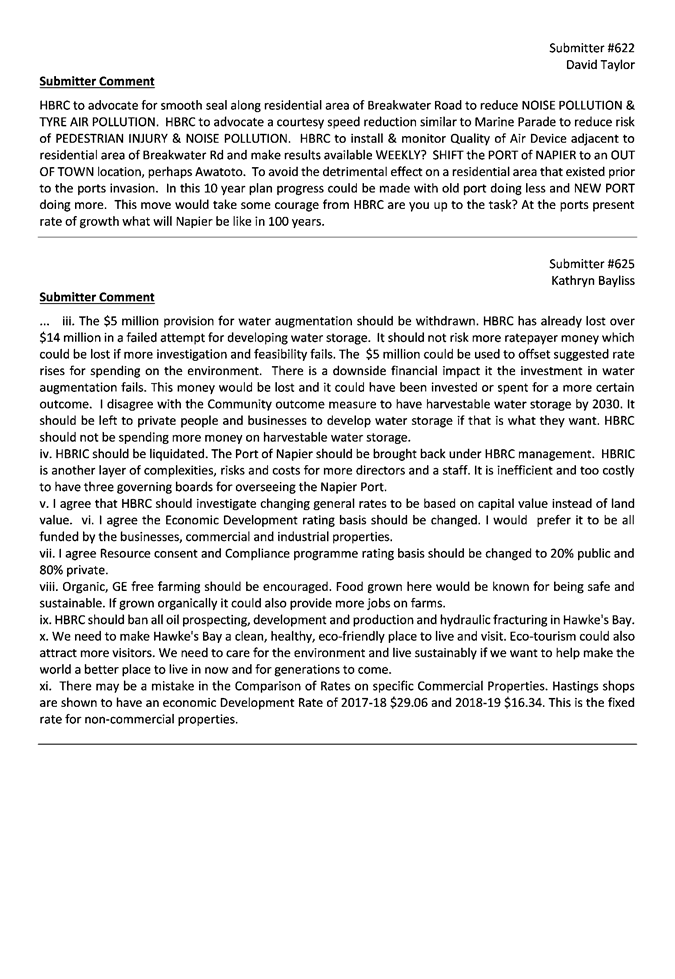
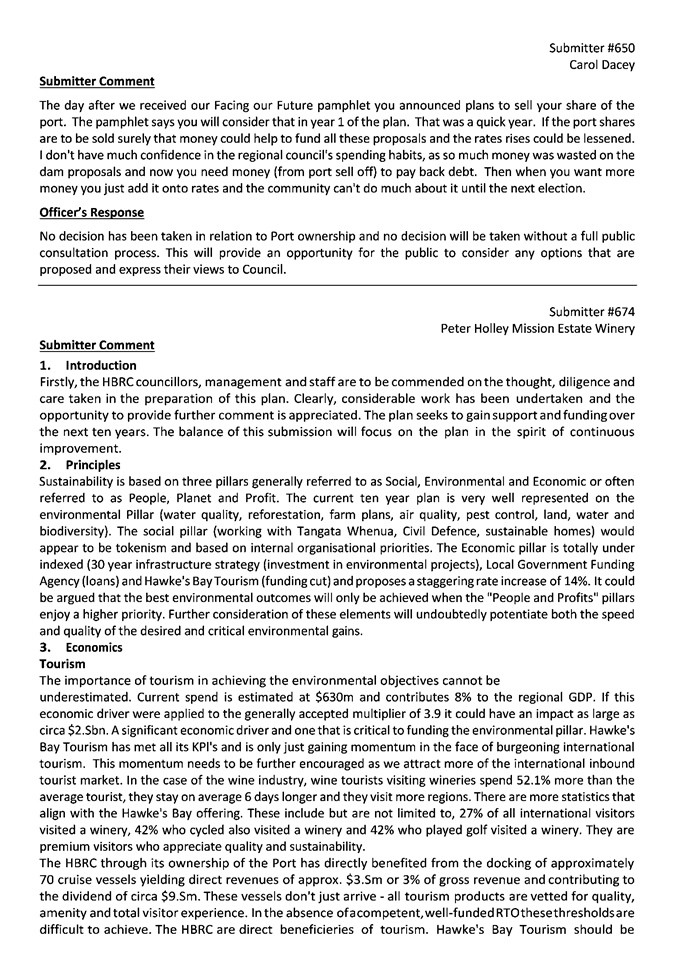
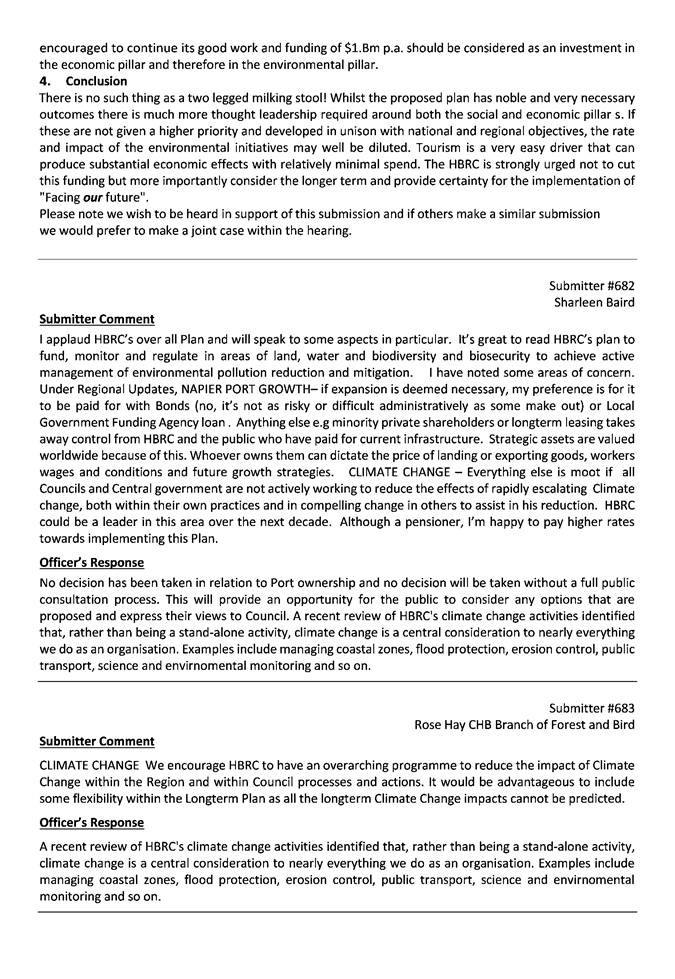
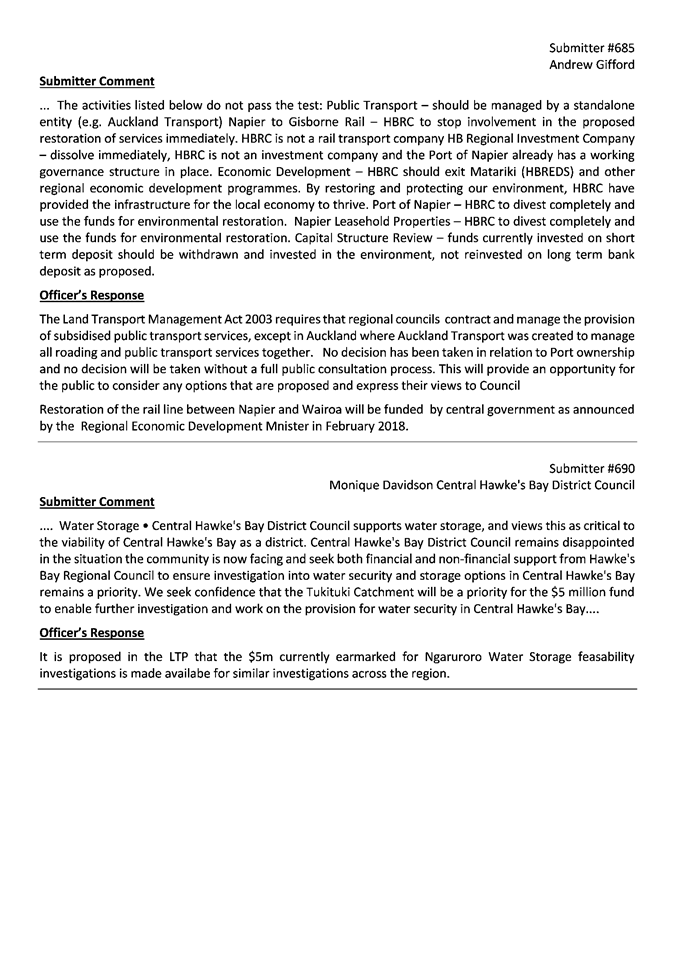

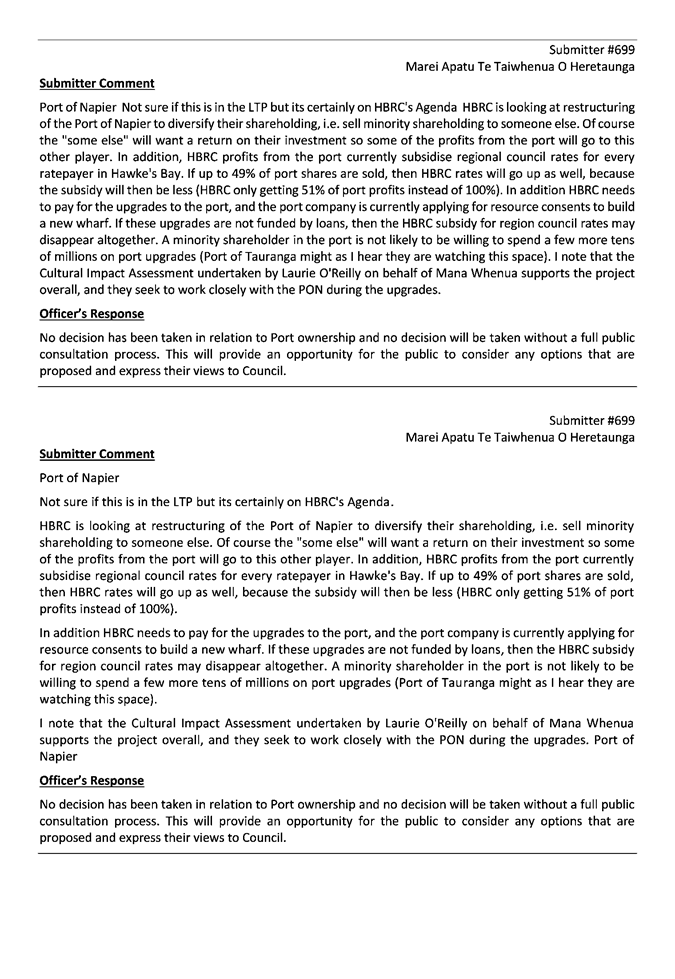
HAWKE’S BAY REGIONAL COUNCIL
Tuesday 22 May 2018
Subject: Corporate Services
Group of Activities - including Rates Affordability
Reason for Report
1. To provide the
Council with an analysis of submissions received in relation to the
“Corporate Services” group of activities through the Facing our
Future 2018-28 Long Term Plan consultation period.
Submissions Received
2. 189 submissions
(attached) were received on this topic. A small number of submissions (or
parts of them) related to issues outside the responsibility of a Regional
Council.
3. Key themes
expressed by submitters included:
Affordability
3.1. Many
ratepayers on fixed incomes are concerned about the proposed increase, and the
size and scale of the average 19% increase compared to inflation, with 99
submissions commenting on the affordability of the rate increase.
3.2. Many comments
included an overall agreement of the direction and strategy the council is
taking, and agree the environment needs investment and attention, but they
simply believe Council’s ambitions are unaffordable.
3.3. Some thought
the commentary or ‘story-telling’ of $1 per week was misleading and
a PR spin given some ratepayers, particularly rural land owners, will have a
significantly higher increase than $52 per annum.
3.4. Members of
the community who are on a fixed income will struggle to afford a rates
increase which is considerably higher than inflation.
3.5. There were
many submitters who thought there should be greater emphasis on user pays and
targeting the recovery of expenditure from those who are the greatest
polluters, and for those who use the environment for commercial gain.
3.6. Some
expressed a view that Council should live within its means, and are concerned
about future year increases and whether these will be restricted to the amounts
outlined in the consultation document given the significant increases of the
last two years.
3.7. There were
questions about whether Council could achieve further savings through its own
operational efficiencies to ensure Council is operating in the most cost
effective manner given the increasing burden on the community, and urged staff
to look for more cost savings internally. Specific mention was made of
the suggestion to wind up the Hawke’s Bay Regional Investment Company Ltd
to reduce governance expenses.
Rates Review
3.8. Some
submitters requested a review of rating policies to ensure that allocation of
expense is ‘fair’, and would like to express support for the full
package proposed but would like to see some phasing of the initiatives into
further years to spread the impact.
3.9. Others would
like to see a review of fairness of the current rating mechanisms with specific
view to implement a possible remission or rebate for those on a fixed income
and more specifically, pensioners.
3.10. There was also concern
expressed about the significant increase of the general rate which is based on
land value and whether the types of costs allocated via this mechanism are
appropriate, specifically governance and strategic planning.
3.11. The District Health
Board has asked that consideration be made of the impact that funding policies
can have on household budgets, and that for the most financially disadvantaged
households these impacts can be significant. The DHB further recommends that
HBRC reviews its rating policy to ensure that the planned rates and other
subsidies will contribute to reducing inequity across the region.
Governance
3.12. There was strong
feedback about the leadership and governance of the Council. Overall
there were 72 submissions in this area, 44 of which signalled strong support
for the vision and leadership shown by the Council with many submitters
thanking management and governors for showing clear leadership and also
supporting the focus on core business. Twenty-eight did not agree with the
direction of Council and did not support the narrowing of focus.
3.13. One submitter thought
that Hawke’s Bay is continuing to contract economically relative to most
other regions across NZ and therefore suggested that “business as
usual” isn’t an appropriate approach from an economic development
point of view. They suggested a review of Council’s non-environmental
activities is now (urgently) required.
3.14. Submissions included
some comments and concerns about a lack of gender and cultural diversity of
councillors, and would like to see greater diversity in the future.
3.15. It was asked that
consideration to the viability of the economy in some of the rural areas be
made and had enough analysis been completed. An example given was the
proposal to plant trees in Wairoa, and possible future impact on the Wairoa
economy.
3.16. Other comments relating
to governance and vision included support in divesting risk in the Port of
Napier Limited, and it was requested that education be given more emphasis in
the next 10 year plan given this plays a key role in the promotion of change.
Process
3.17. 11 submitters commented
on the process of the LTP consultation with some expressing appreciation for
the user friendly methods to provide feedback, and some thought there was an
increased level of engagement. Others expressed a dissatisfaction and the
need to do more, to allow a wider cross section of the community to express
their views. This included a request to have a variety of town-hall
meeting times including daytime, to allow parents and nightshift workers to
attend.
3.18. Some of the Wairoa
community thought they was insufficient time allowed to submit following the
town-hall meeting, and requested the process be refined in future.
Track-record
3.19. Concerns were made about
the ability of this council to deliver on its promises given its recent track
record, with specific mention to the Ruataniwha Water Storage Scheme and the
subsequent significant write off of funds expensed on the project.
3.20. The question was also
asked “what have previous councils been doing”, with some of the
community requesting further explanation as to why such significant invested is
required now, what have we been doing?
Officers’
Analysis of Submissions
4. Given the scale
of the proposals in the 2018-28 LTP and the ambition of this plan, we are
asking the community to help fund this step change through an increase in the General
Rate.
5. This LTP
includes a move to more directly charge users of our services. For
example, we have proposed significant changes to the way we allocate and
collect our Economic Development rate, shifting a larger percentage of the cost
to commercial ratepayers. This is intended to align the cost of the
activity to those who benefit the most.
6. HBRC
acknowledges that this LTP requires a significant contribution from the
community, particularly those on low or fixed incomes. The affordability of
the proposed increase was given significant consideration. Whilst we
understand that for some ratepayers the increase will be much higher than $1
per week, this is the exception, with our modelling showing the average
increase for 49,522 or 70% of the community will be $1 per week or less.
Furthermore, half of all ratepayers will pay 60 cents or less per week.
7. We believe we
must accelerate our efforts and therefore our investment, to see major changes
across the region in the next 10 years. This requires scaling up
particularly in year one of the long term plan to support a step change in
activity.
8. The submissions
requesting Council review the fairness of its rating allocation highlights the
need for Council to continue its comprehensive review of all rating policies.
There is room for better organised communication regarding this issue.
9. All comments
regarding possible improvement to the process of the long term plan
consultation will be taken into consideration. It is our goal to be both
as transparent as possible reach as many in the community as possible and we
will continue to look at ways of achieving this.
Decision Making Process
10. Council
is required to make every decision in accordance with Part 6 Sub-Part 1, of the
Local Government Act 2002 (the Act). Staff have assessed the requirements
contained within this section of the Act in relation to this item and have
concluded:
10.1. Section
93(A) of the Act provides for the use of a special consultative procedure in
relation to the adoption of a Long Term Plan as prepared under section 93 of
the Act.
10.2. The issues to be
considered in this paper are those issues raised by members of the community
that have submitted to the Council on the Consultation Document “Facing
Our Future 2018-28”. All submissions are an integral part of the special
consultative processes set out in Section 83 and 85 of the Local Government Act
2002.
|
Recommendations
That the
Hawke’s Bay Regional Council:
1. Receives and notes the “Corporate
Services Group of Activities” staff report.
2. Considers the submission points made relating to “Corporate Services Group of Activities”
and any comments made by Council officers, and makes
no changes to the 2018-28 Long Term Plan as a direct result of those.
|
Authored by:
|
Trudy Kilkolly
Financial Accountant
|
Jessica
Ellerm
Group Manager
Corporate Services
|
Approved by:
|
James Palmer
Chief Executive
|
|
Attachment/s
|
⇩1
|
Corporate
Services Group of Activities Submissions
|
|
|
|
Corporate
Services Group of Activities Submissions
|
Attachment 1
|
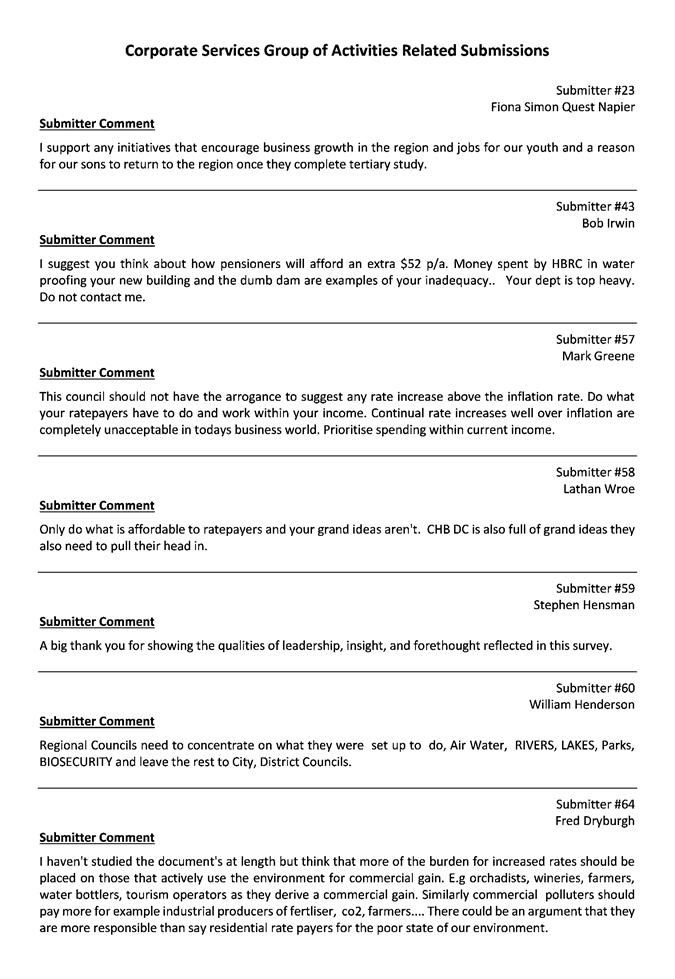
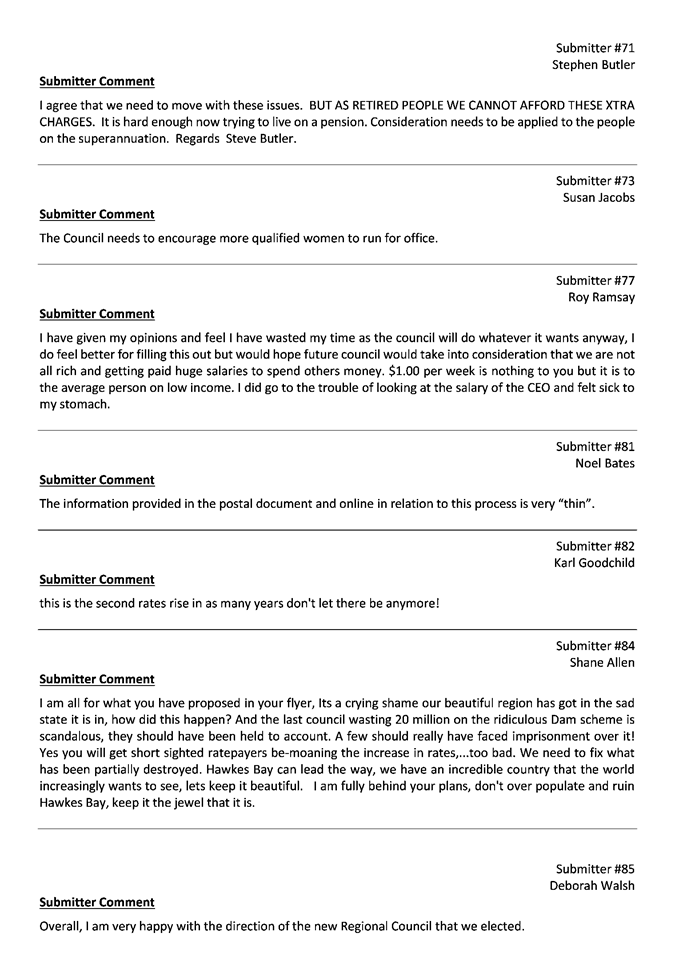
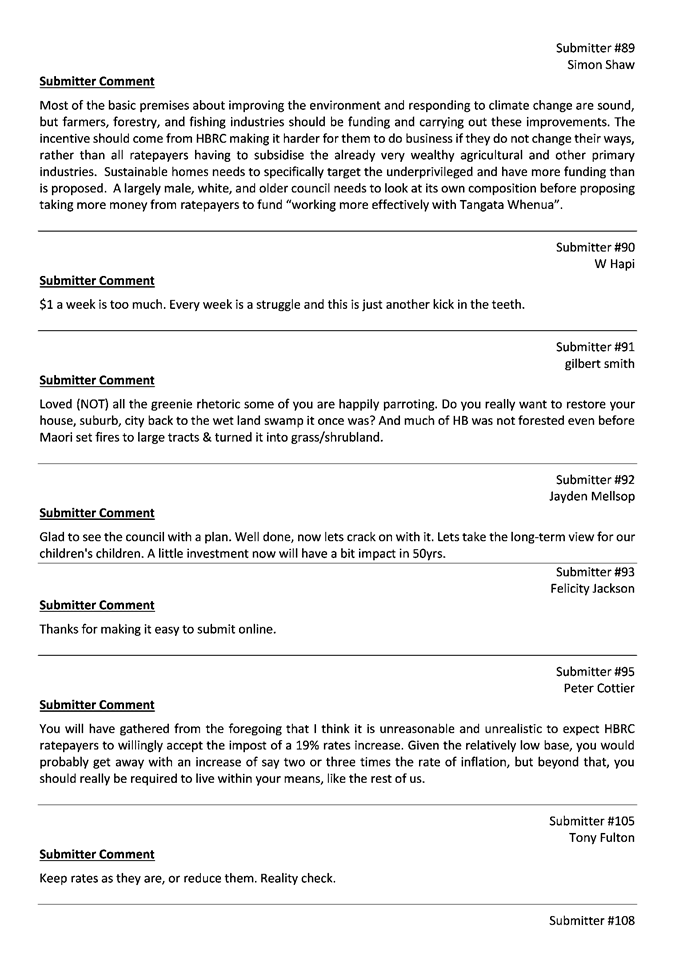
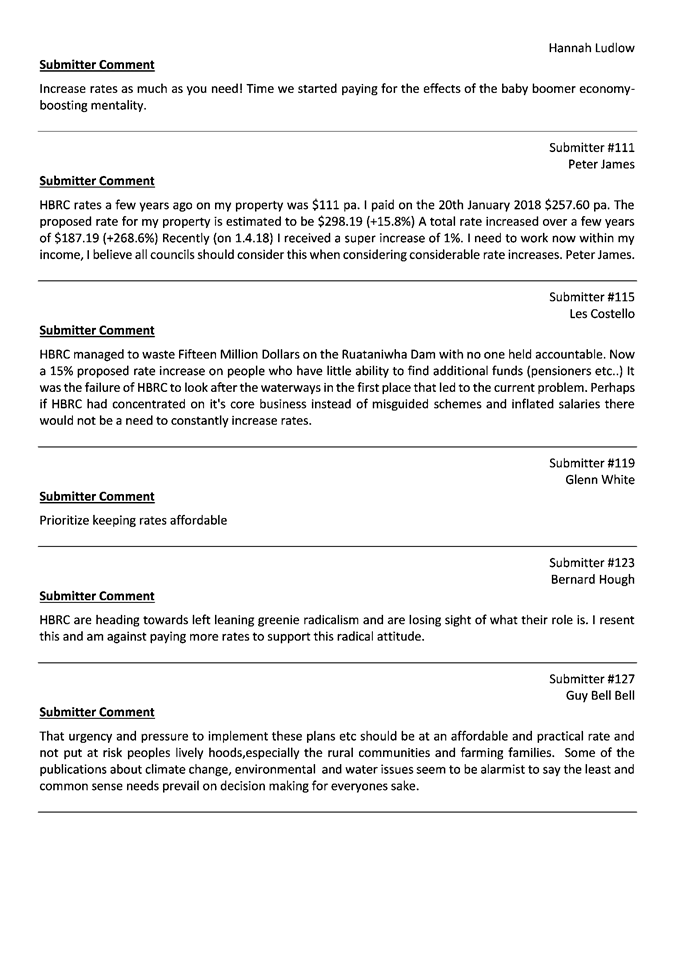
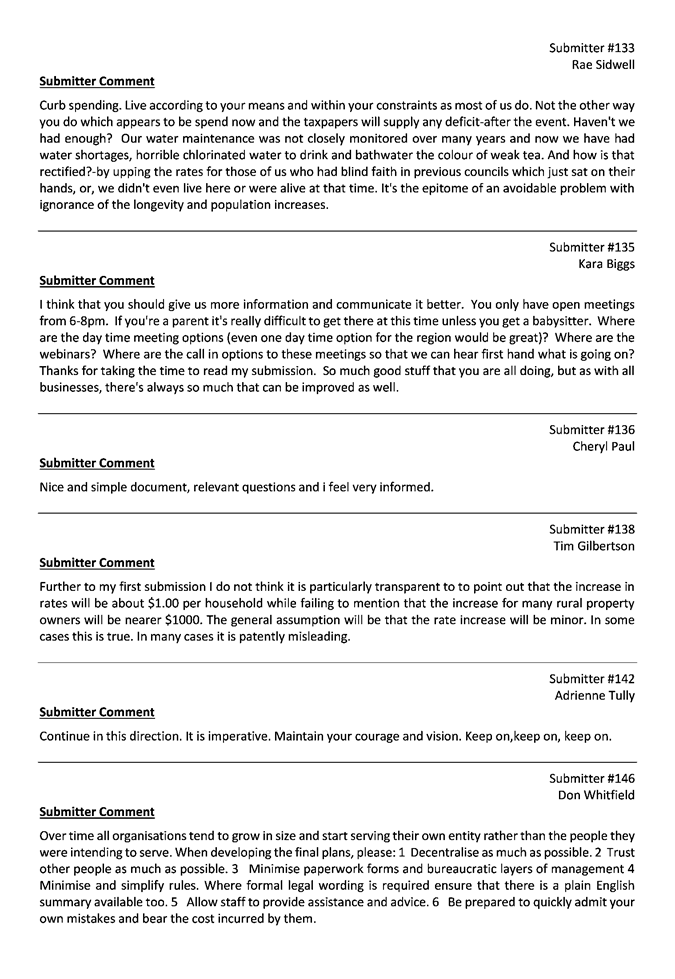
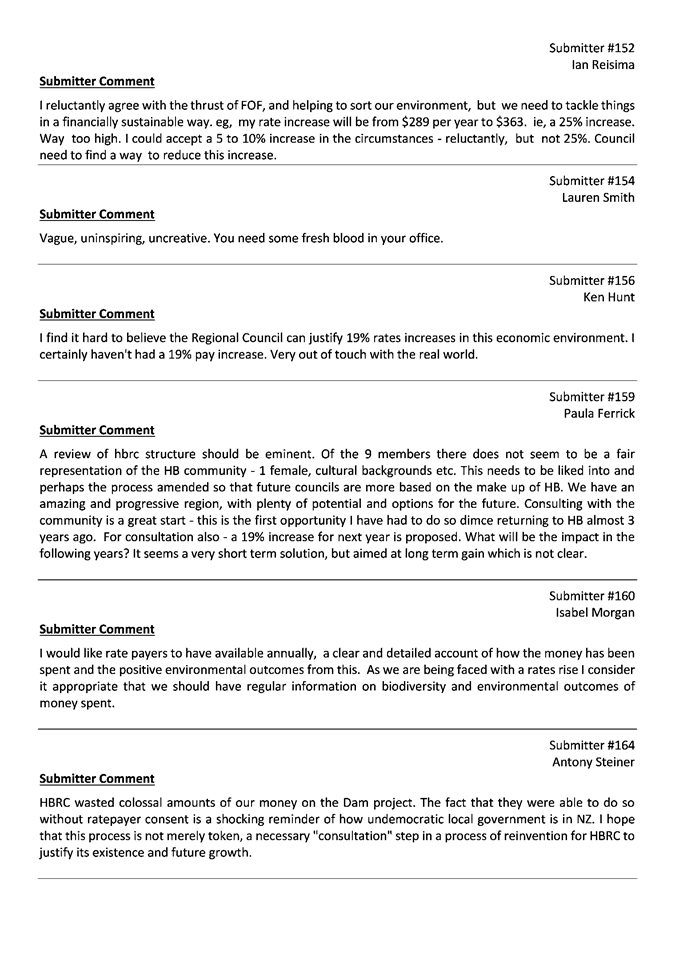
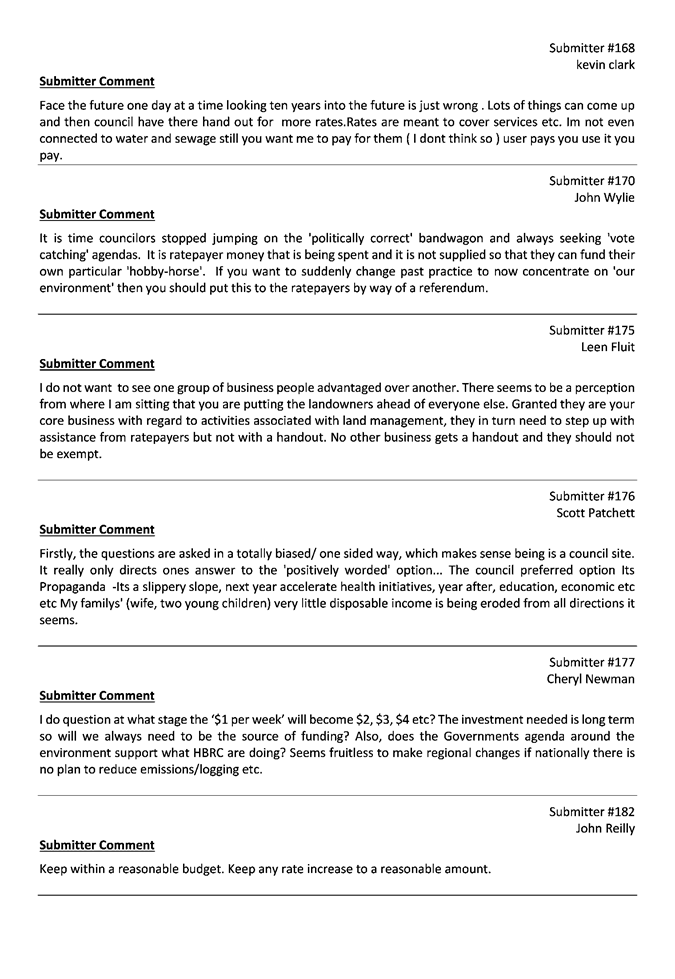

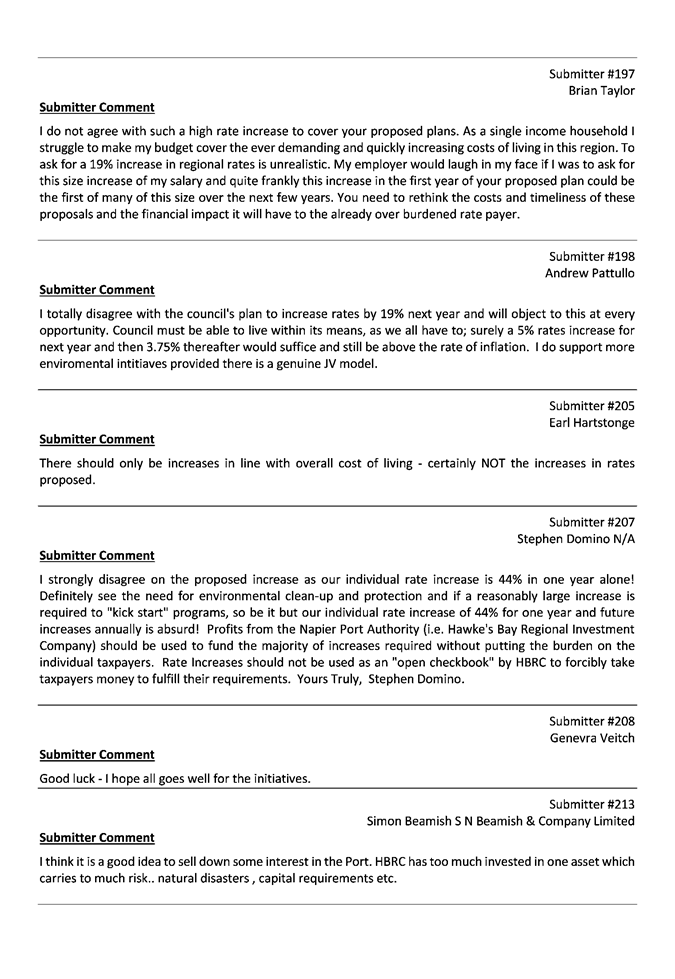
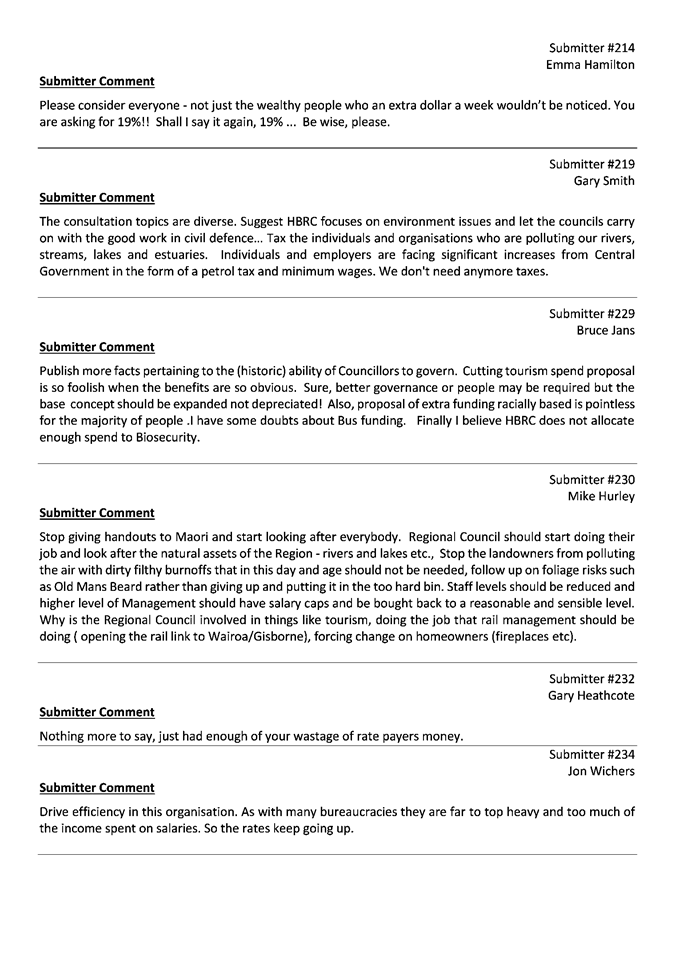
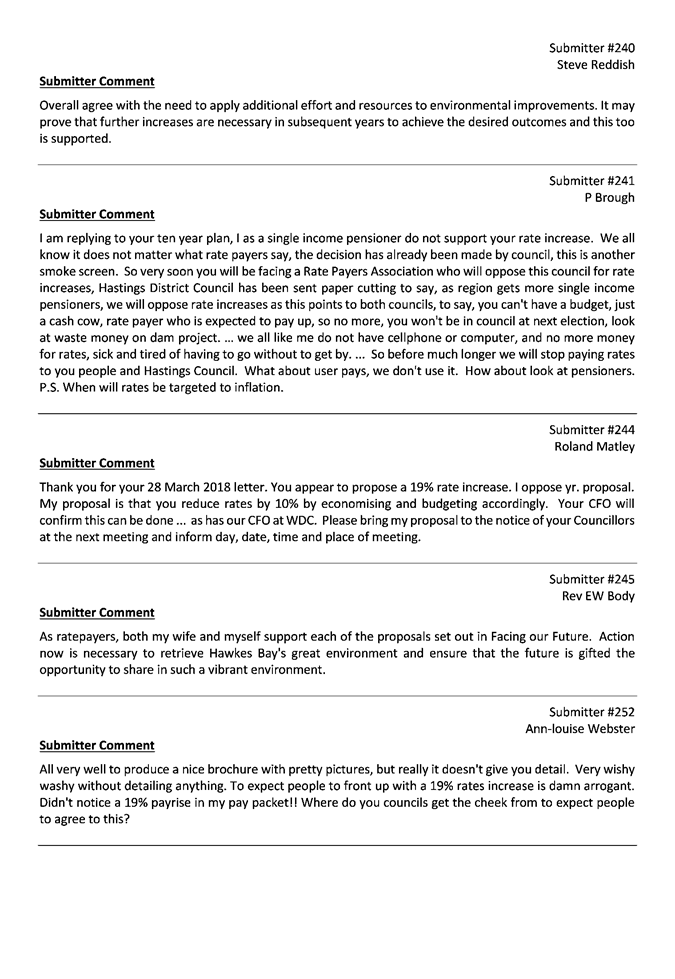

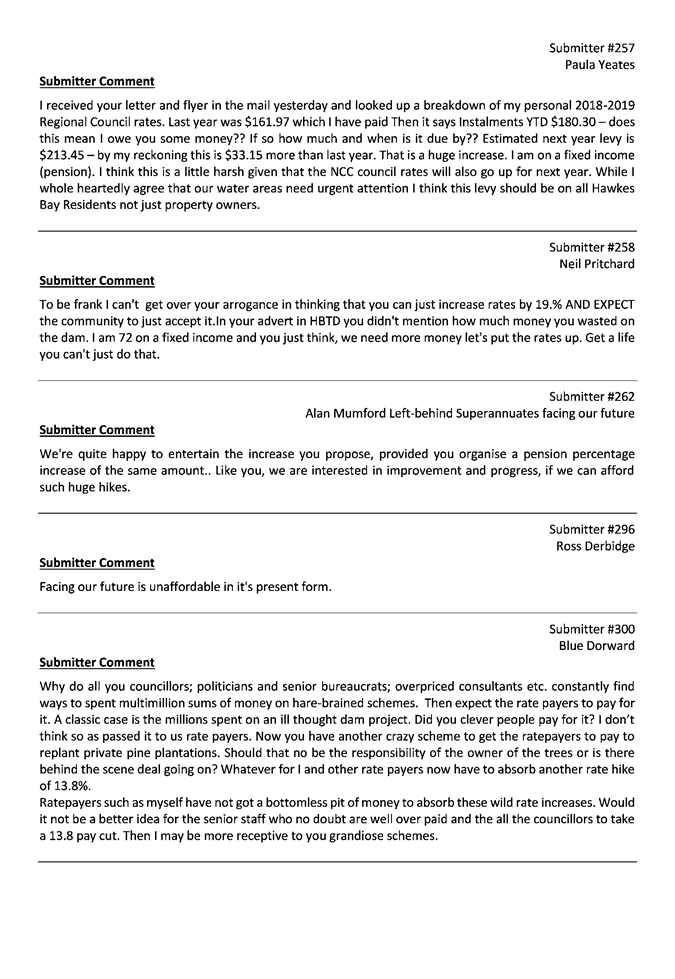
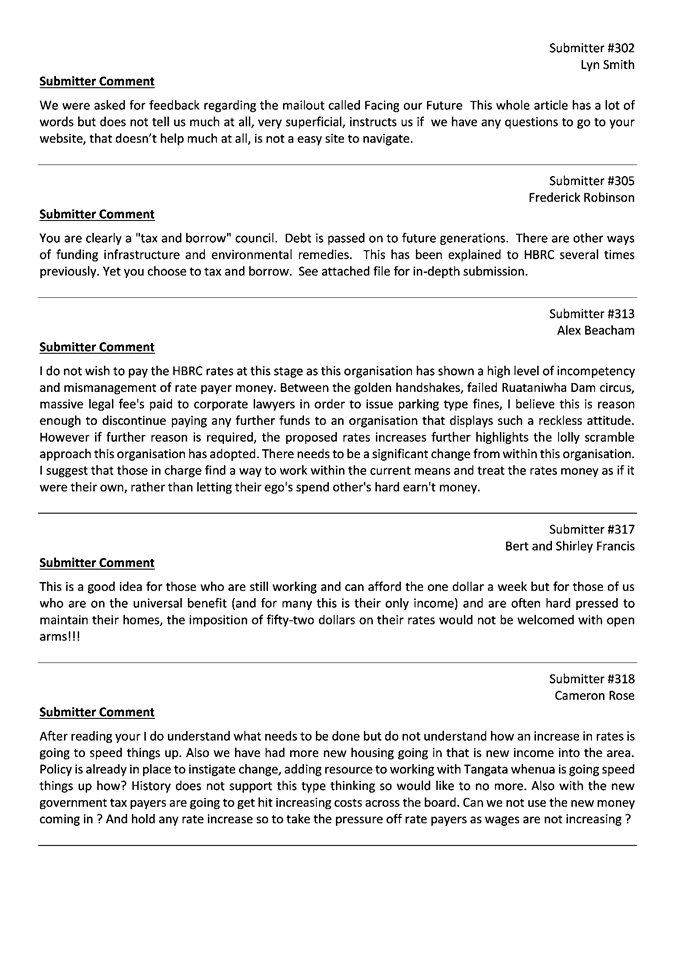
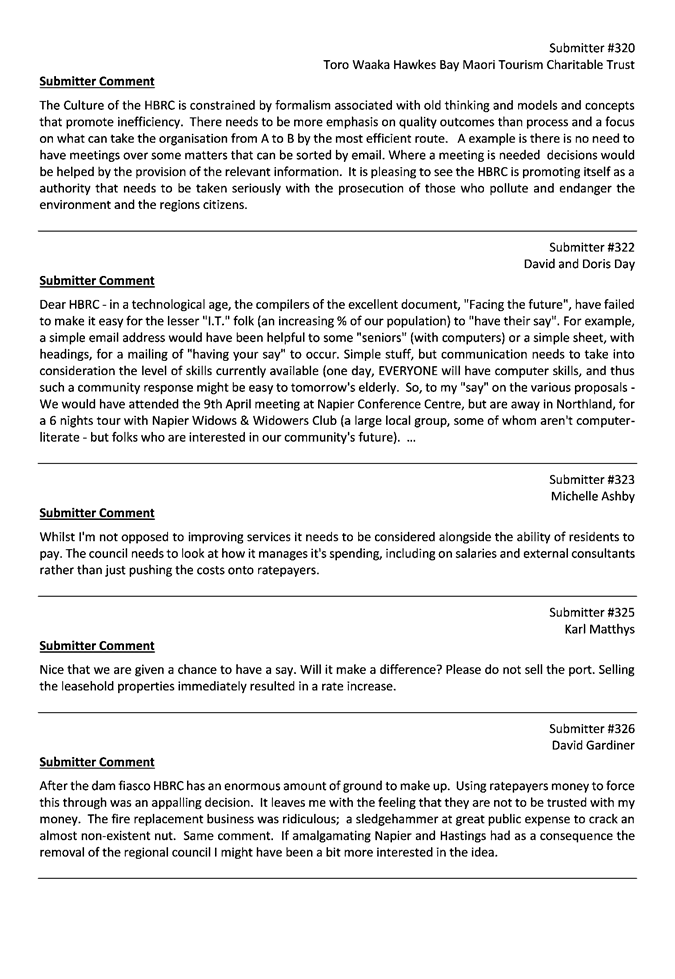
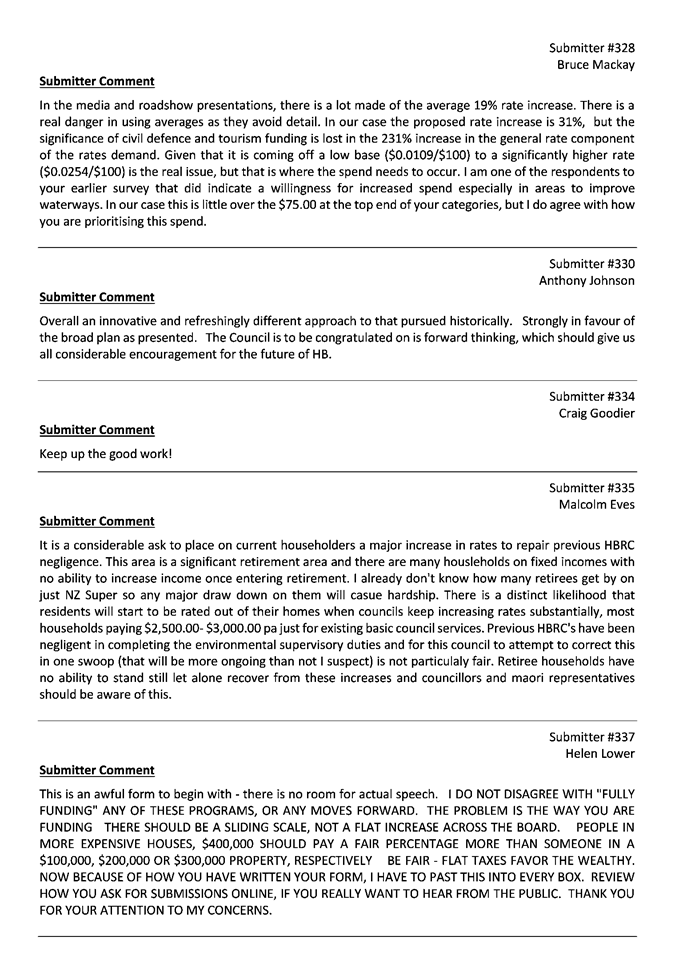
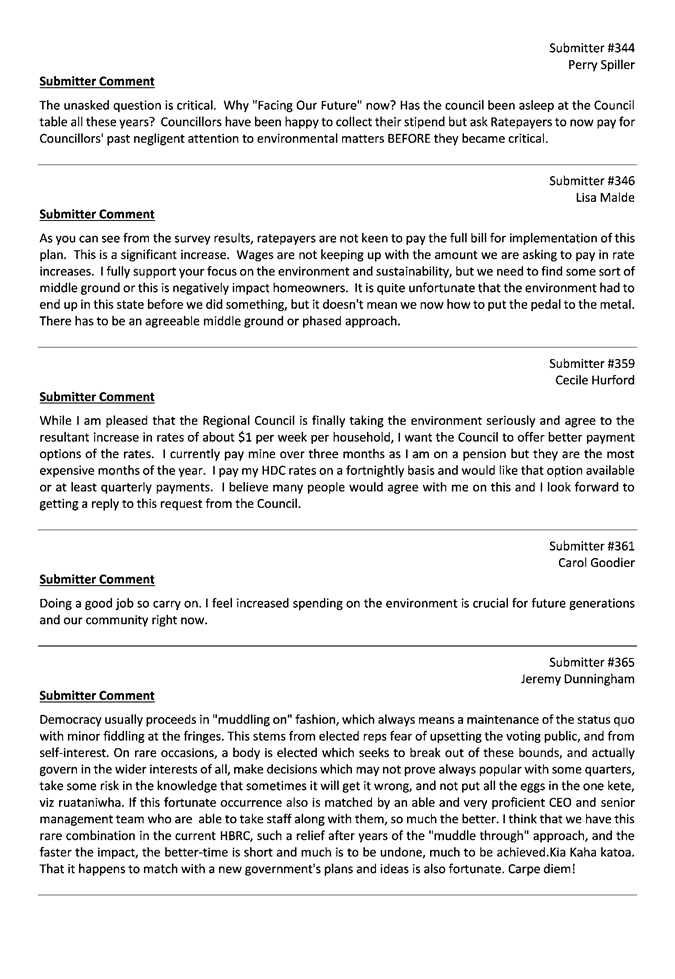
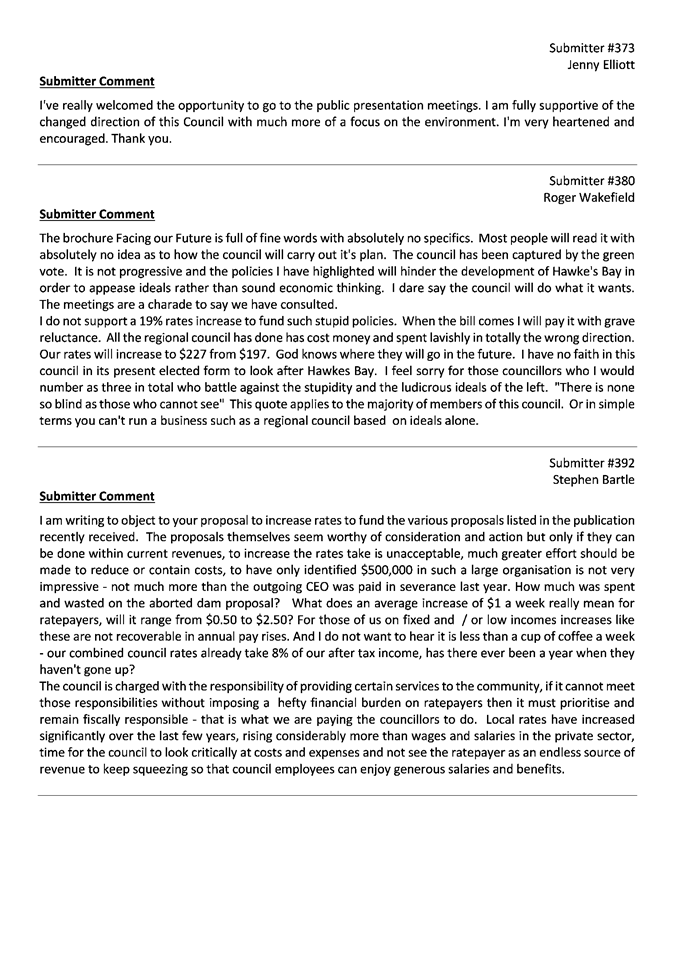

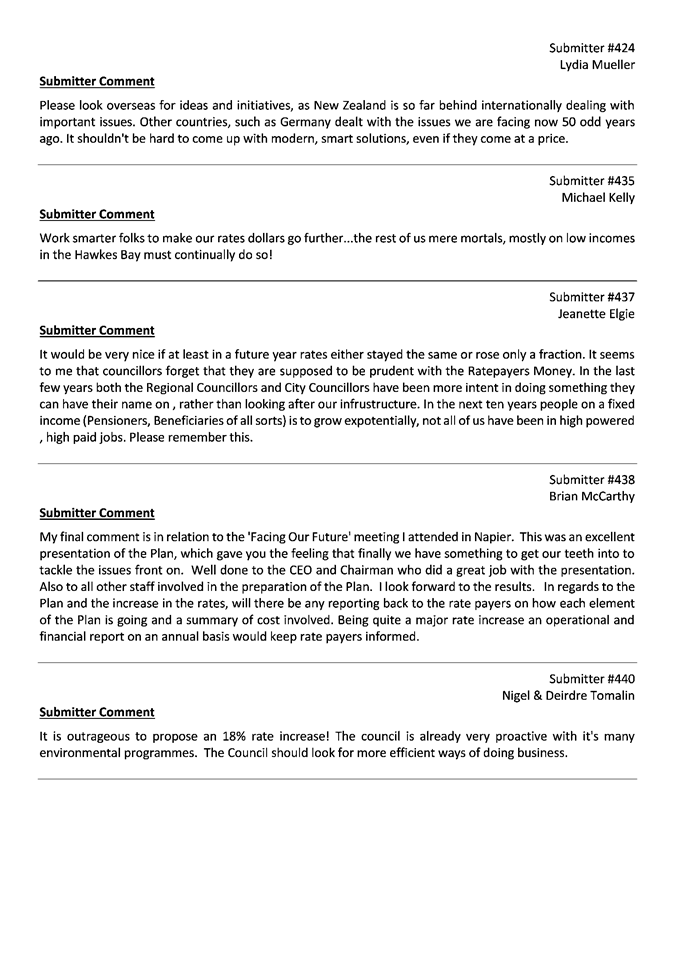

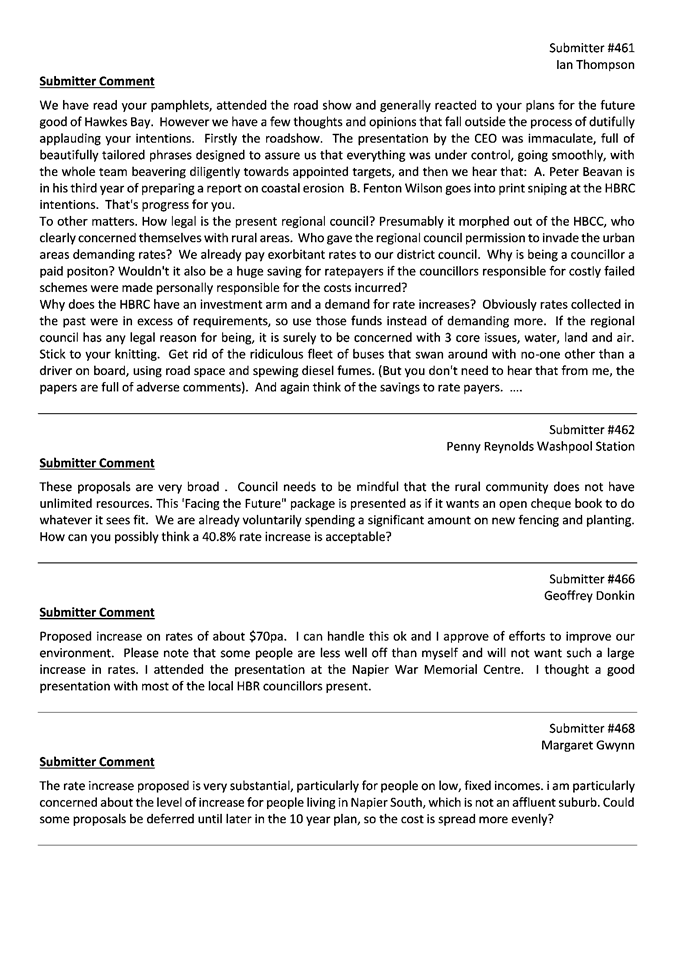
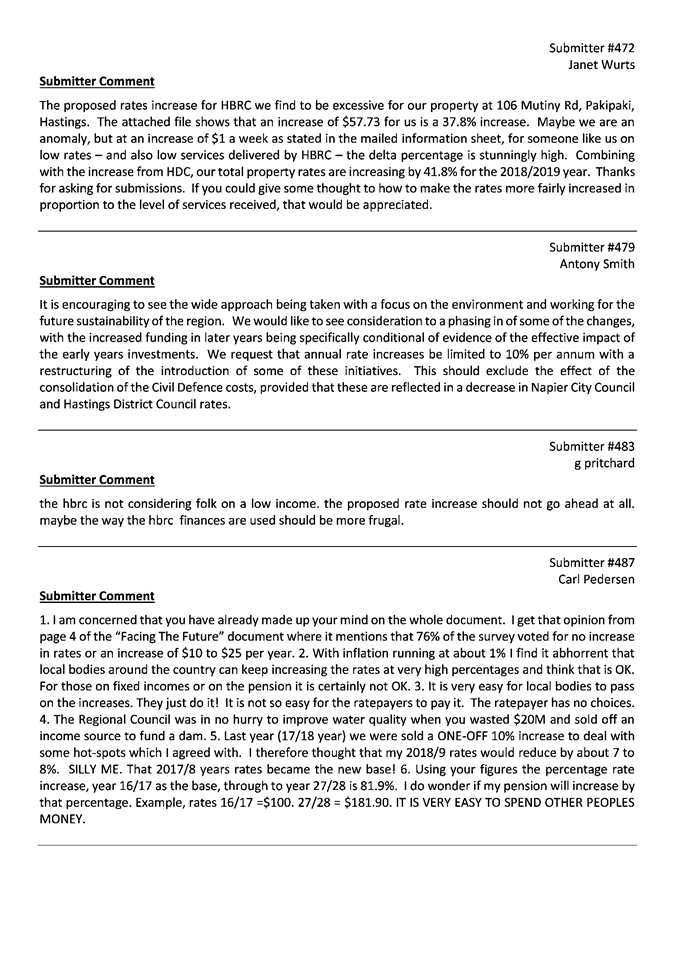
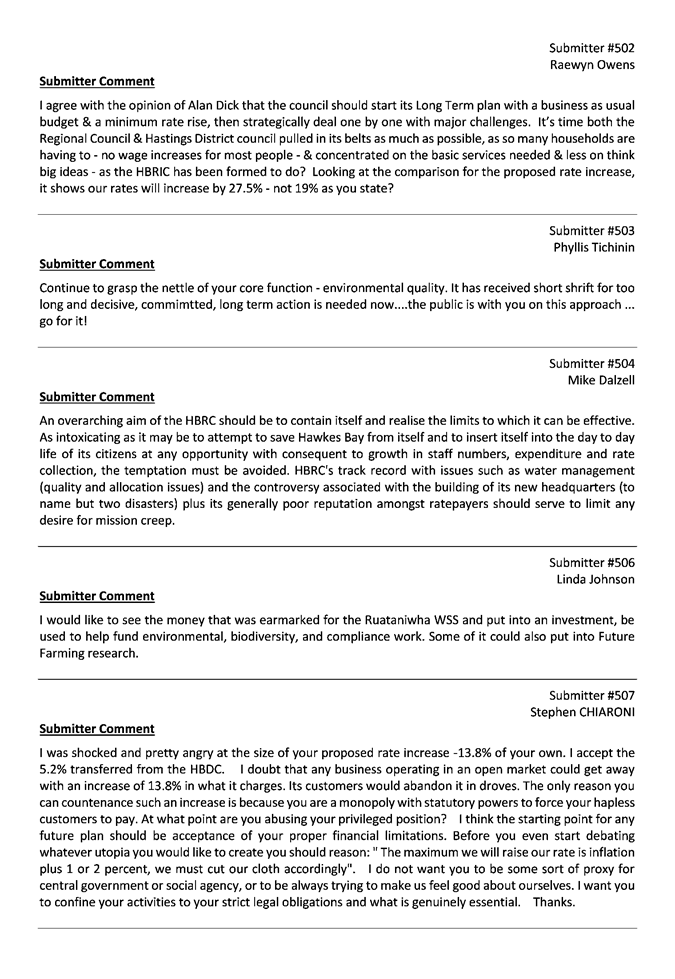
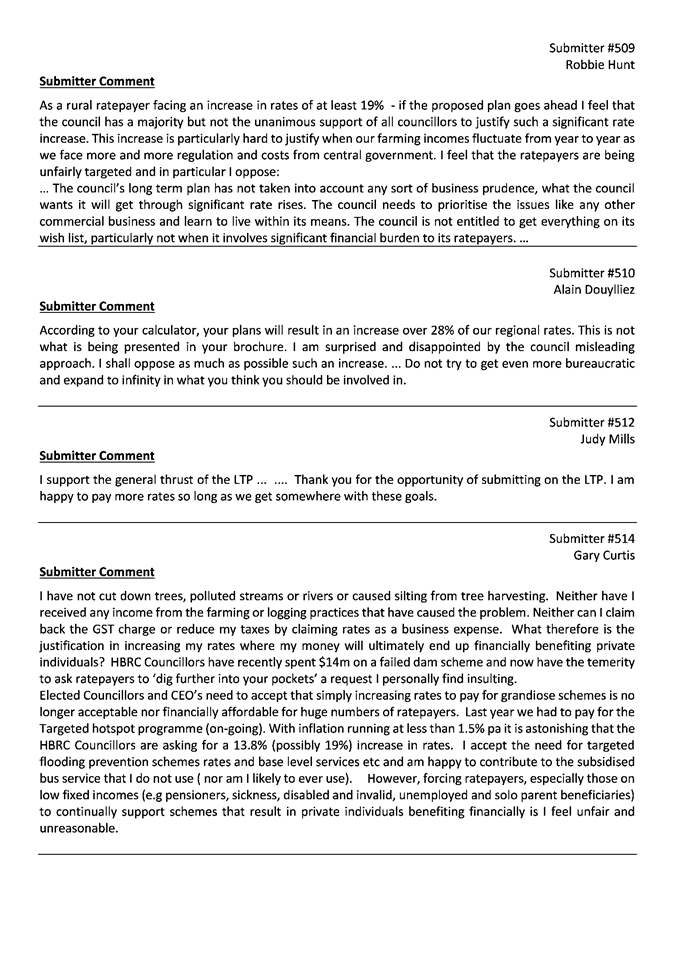
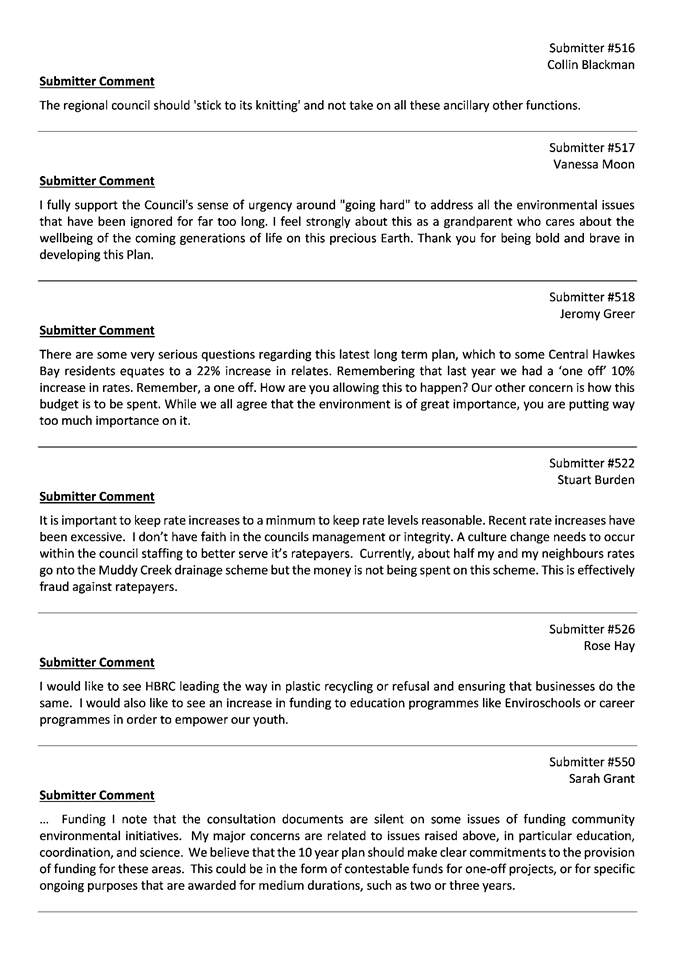
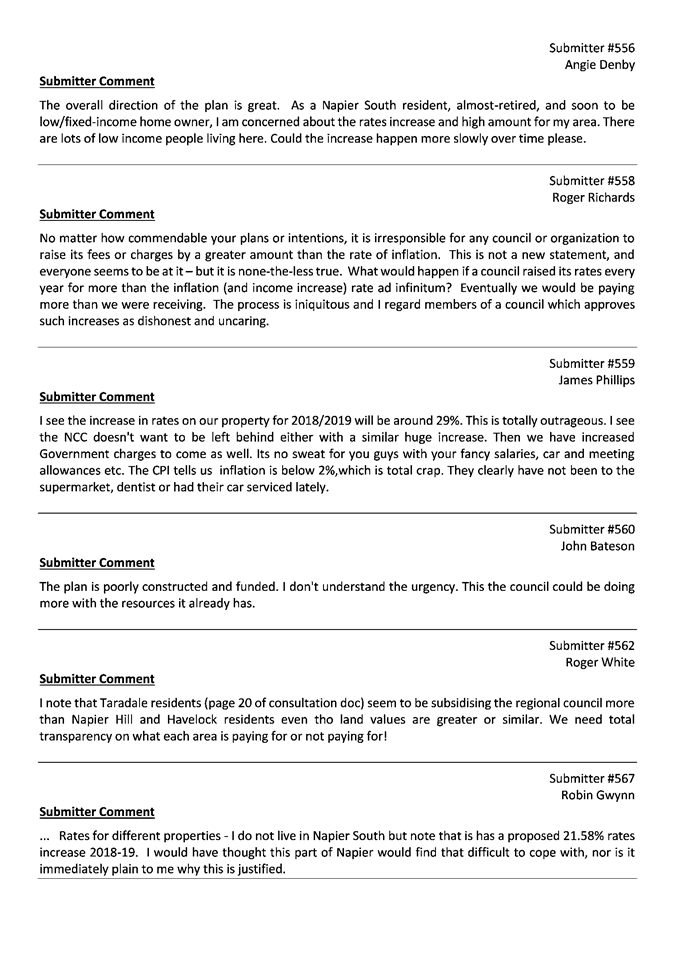
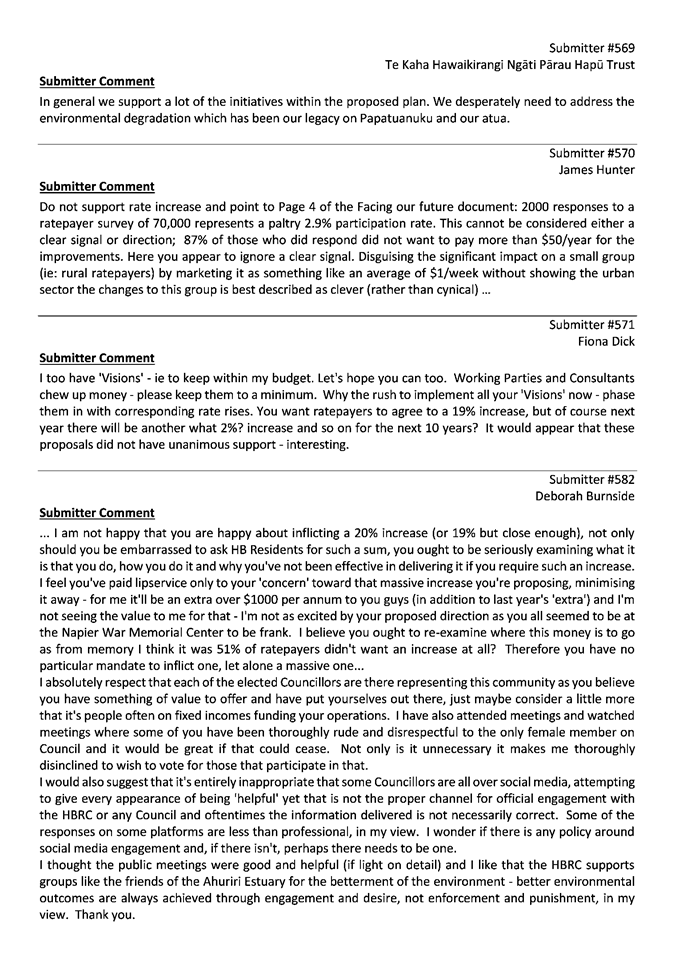
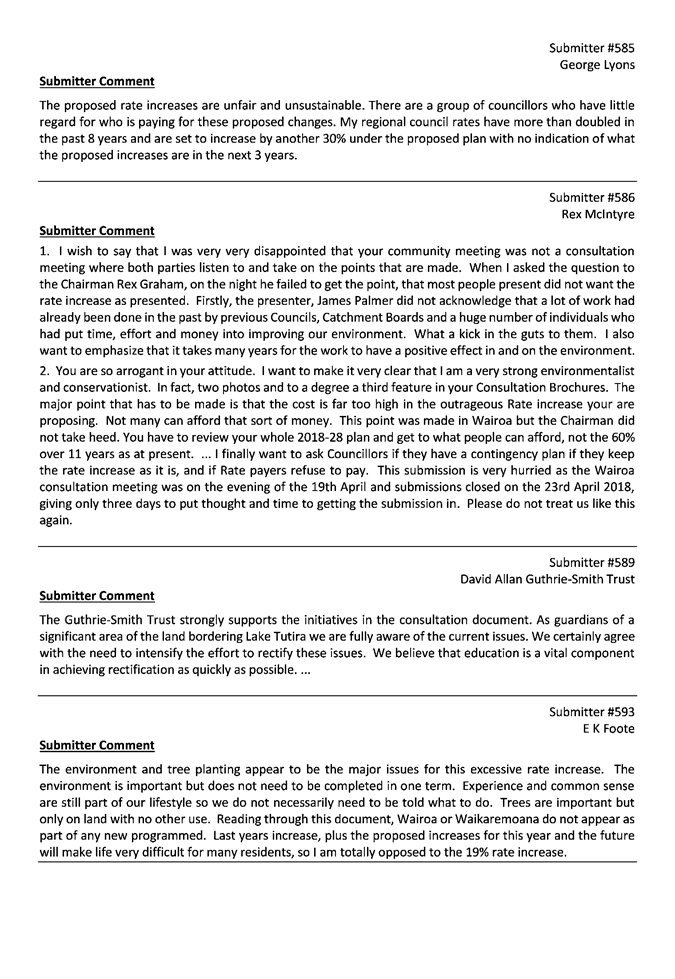
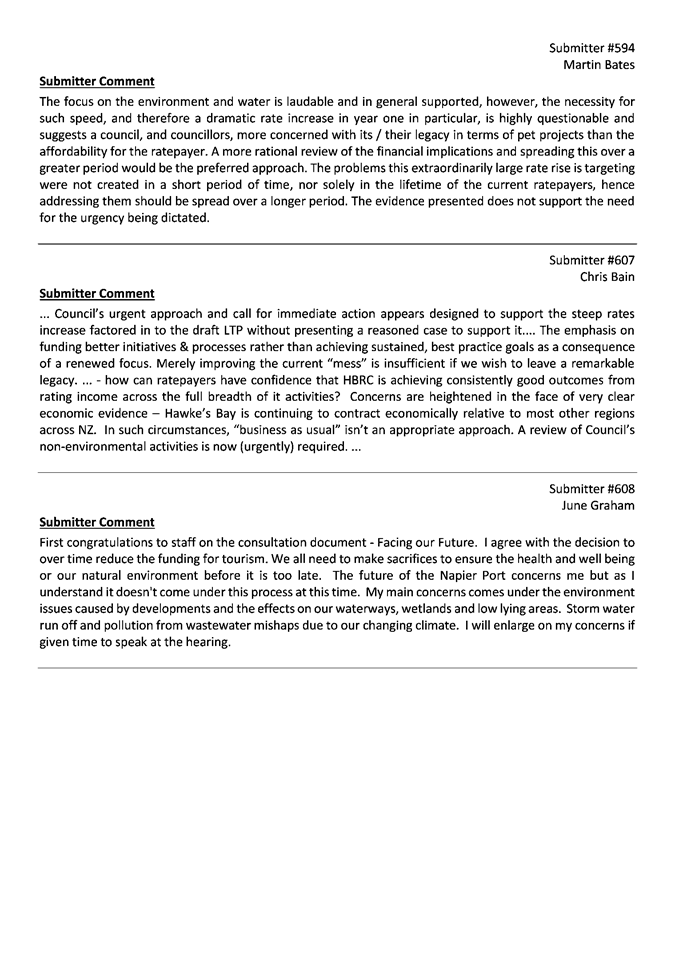
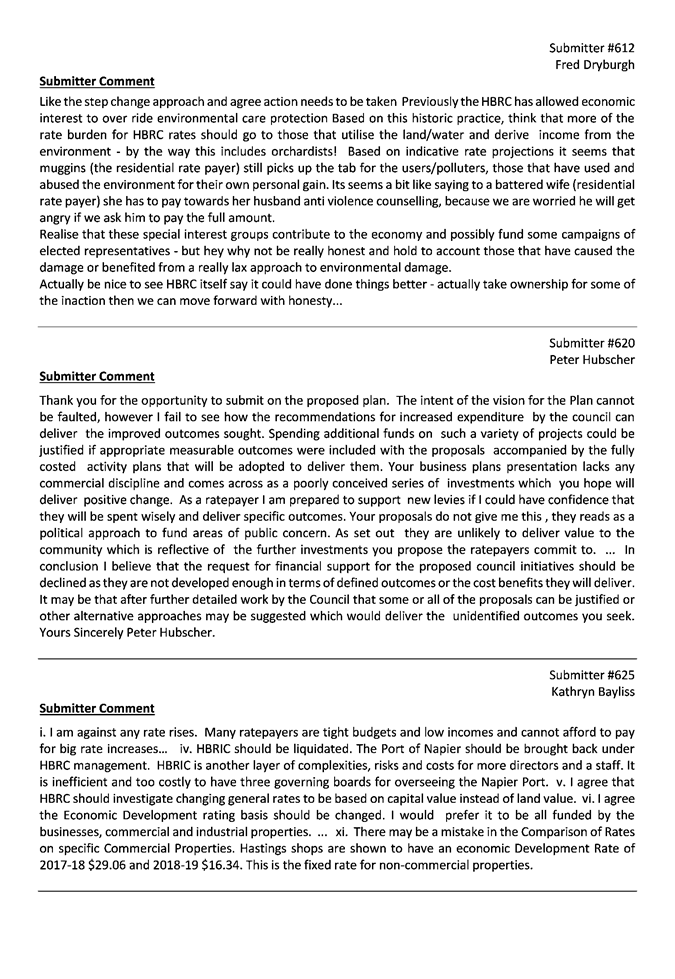



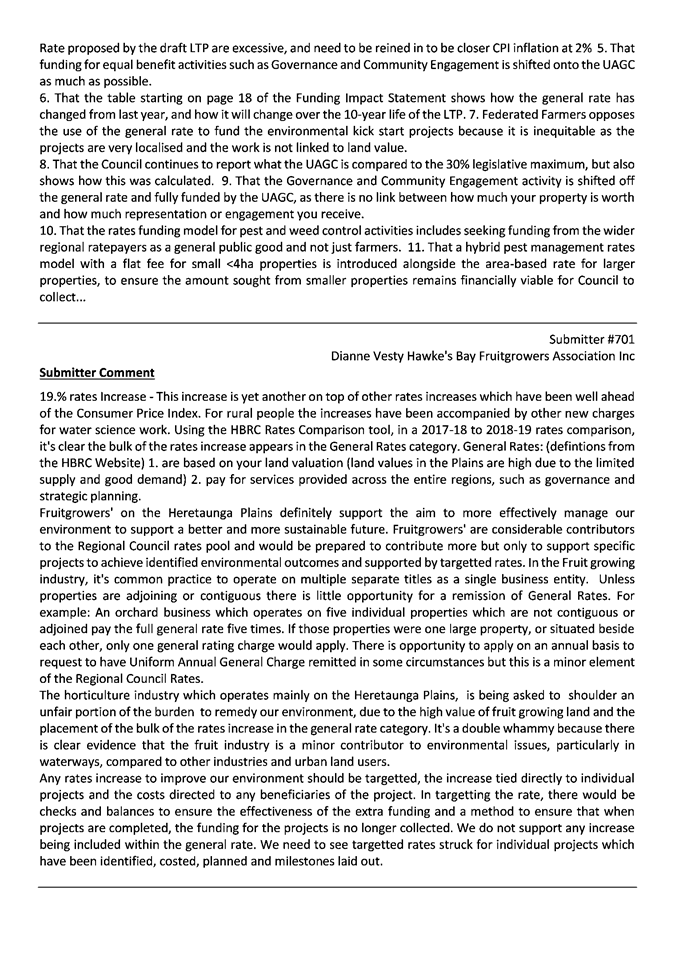
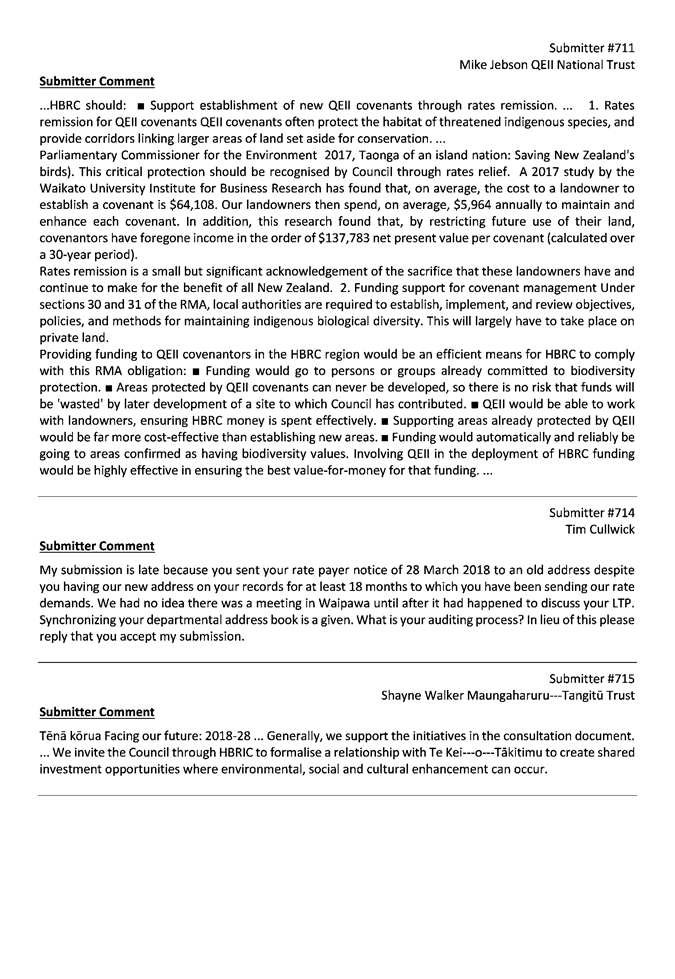
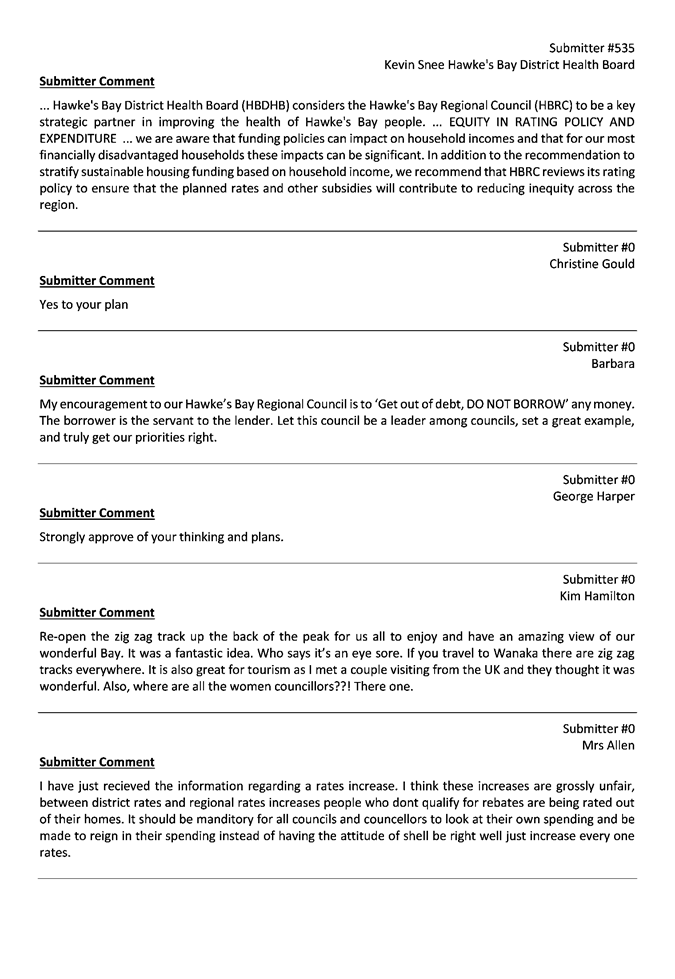
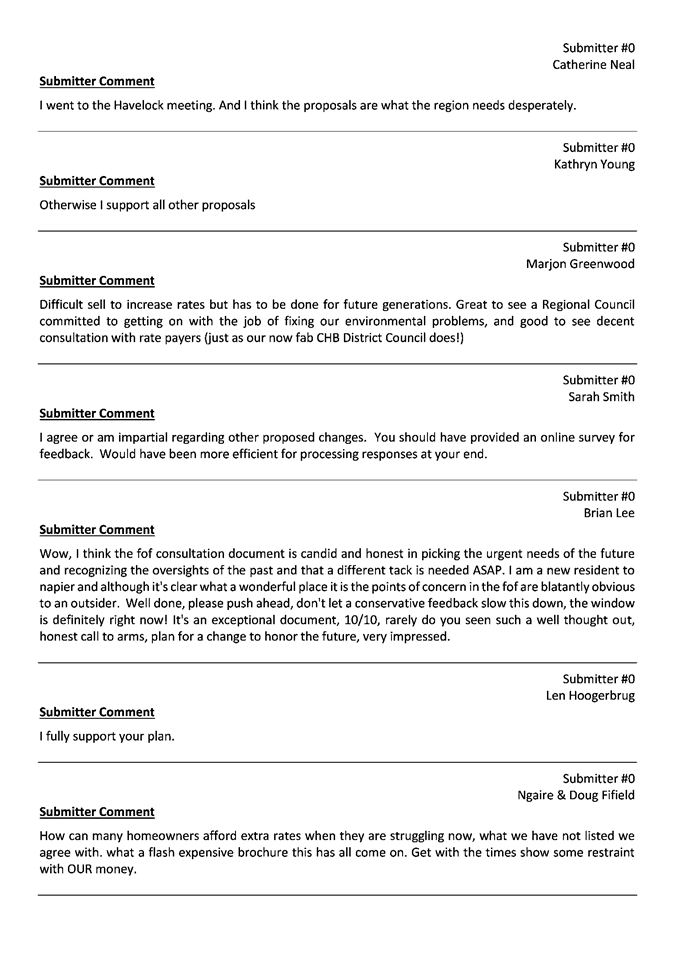
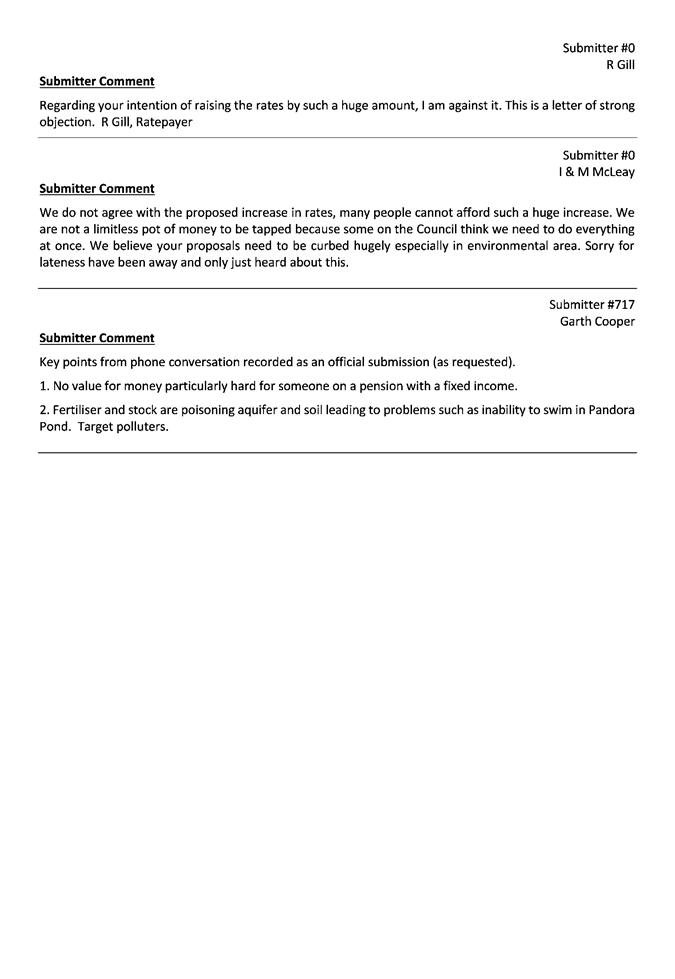
HAWKE’S BAY REGIONAL COUNCIL
Tuesday 22 May 2018
Subject: Submissions Requesting
Financial Assistance / Grants
Reason for Report
1. To provide the
Council with an analysis of submissions requesting financial assistance and/or
grants through the Facing our Future 2018-28 Long Term Plan consultation
period.
Submissions Received and Officer’s Analysis
2. Five
submissions were received requesting funding (see attached). Two of these are
for funding that is already in our baseline financials being, Business
Hawke’s Bay and Toimata Foundation (i.e. Enviroschools). The other three
funding requests were received from Coastguard Eastern Region; Waiohiki Marae
Board of Trustees; and Cranford Hospice.
Business Hawke’s
Bay (572)
3. This submission
requested a continuation of the HBRC’s support and funding of Business Hawke’s Bay (BHB) of
$100,000+gst per annum. Its programme of work from 2018 onwards, with a focus
on specific projects and clearly identified deliverables and outputs, is to be
presented (presumably as part of its verbal submission at the Hearings).
4. HBRC's
funding of BHB is almost entirely predicated on BHB’s continued support
for regional economic development collaboration. It was through this mandate
that HBRC supported BHB's request to join a comprehensive review of the
regional economic development strategy, culminating in Matariki REDS. Due to
the delays in establishing the preferred Matariki REDS delivery model, HBRC has
rolled forward BHB's existing $100,000pa funding. HBRC's current funding
agreement with BHB provides for an adjustment to the quantum of funding should
the final model require it. For example, if a third party is engaged to provide
support services for Matariki REDS the HBRC would consider diverting a part of
its funding to BHB in favour of that third party.
5. Regional
Council actively supports the Business Hub through locating the Regional
Business Partner Programme at the Hub.
Toimata
Foundation (702)
6. This submission
is not a funding request per se, rather it advocates for continued support from
HBRC. Toimata Foundations’ submission covered the following three points:
6.1. Explains
“what is Enviroschools” and its uptake in Hawke’s Bay. The Enviroschools Programme is an action‐based
education programme where young people plan, design and implement
sustainability projects and become catalysts for change in their communities.
The aim is to foster a
generation of people who instinctively think and act sustainably. The programme
operates nationwide through partnerships with Councils. There
are 50 Enviroschools in Hawke’s Bay – 22% of all schools and 10% of the early childhood education (ECE) sector.
6.2. Thanks HBRC
for its many years of regional leadership of Enviroschools (partners since
2003) and acknowledges the excellent job that Sally Chandler does as the
Regional Coordinator. It also highlights synergies between the Enviroschools
network and three of HBRC’s consultation proposals, namely Land, Water
and Biodiversity; Sustainable Homes and Working with Tangata Whenua.
6.3. Further
describes the value to council partners. Council’s cornerstone investment
equates to 20-25% of the total annual investment in Enviroschools, with the
balance being funded by other contributors.
7. HBRC values its
relationship with Toimata Foundation and continues to work collaboratively to
build the Enviroschools network in Hawke’s Bay. To this end, HBRC
has submitted on the Long Term Plans of the territorial authorities within
Hawke’s Bay to secure an ongoing funding partnership. Both Hastings
District Council and Napier City Council provided financial support for the
Enviroschools programme in 2017/18. A proportionate funding request has
or will be made to Central Hawkes Bay District Council and Wairoa District
Council respectively.
8. The base level
of service increase as consulted on in Facing our Future 2018-28
Consultation Document includes an increase in internal resourcing from 0.3
to 1 FTE to coordinate environmental education. This was acknowledged and
supported by the Toimata Foundation.
Coastguard
Eastern Region (381)
9. This submission
proposes the creation of a three-year partnership arrangement in which HBRC
would make a contribution to the Coastguard’s operating costs. In return
the Coastguard is interested in exploring ways to lend assistance to HBRC such
as bolstering emergency management capacity for oil spills etc. Along with
other funding sources, this would more sustainably meet the costs of Coastguard
operations in Hawke’s Bay.
10. In the Hawke’s Bay
Region, 'Coastguard' consists of 1 unit. This unit is a charity registered with
NZ Charity Services. The unit is staffed entirely by volunteers who commit to
providing continuous, year-round Search
and Rescue services
on Hawke’s Bay's
coasts and waterways.
11. Coastguard takes a
multi-pronged approach to saving lives at sea that includes:
11.1. Providing highly trained rescue vessel
crews and equipment to respond to life-threating marine incidents;
11.2. Providing year-round safety and
communications services to Hawke’s Bay's marine users;
11.3. Educating boats owners and users to
maximise their enjoyment and minimise risk;
12. The Coastguard has made
similar requests to other regional councils and currently receives support from
Waikato Regional Council. It is engaging with BOP Regional Council and Gisborne
District Council for funding for the Eastern Region.
13. The submission did not
specify a funding amount. However, it is not likely to be a large amount based
on a previous arrangement whereby HBRC funding of around $10,000 was given to
coastguard. This arrangement ended around three to five years ago.
14. If Council wishes to
support this request it could be funded through an increased deficit in net
funding position or general rate increase.
Waiohiki Marae Board of
Trustees (485)
15. This submission requests
funding support of $150,000 from HBRC towards the rebuild of the Waiohiki
wharenui (meeting house) and ablution facilities. The Marae is adjacent
to the Tūtaekurī River and sits at the foot of Ōtātara Pā.
16. The rebuild is necessary
after an electrical fault destroyed the whare, Te Huinga in 2002. The traditional wharenui (meeting house)
is 70% constructed. The
Waiohiki Trustees are seeking
part funding for the
remaining 30%. Positive discussions are underway with both Hastings
District Council and Napier City Council to commit a further $150,000
each to see the project through
along with other funding sources.
17. If Council wishes to
support this request it could be funded through debt funding and repaid via the
general rate over a period of ten years. It should be noted that any funding
could create precedent issues and expectations for funding support to other
such initiatives.

Cranford
Hospice (623)
18. This submission requests
support for the Cranford Hospice new building project through a funding
contribution to the value of $2,000,000. This could be a combination of cash
and in-kind.
19. Cranford Hospice is a
registered charity providing essential care for the HB community. Demand for
specialist palliative care services have risen by 40% over the last 5 years. In
addition to this, the existing facilities are no longer adequate and so new
purpose built facilities are proposed. Land at Chesterhope Station (between
Napier and Hastings) has been gifted for this purpose. Cranford Hospice invite
HBRC to participate in their vision for larger and better fit for purpose
facilities.
20. If Council wishes to
support this request it could be funded through debt funding and repaid via the
general rate over a period of ten years.

Financial
and Resource Implications
21. The financial impacts of
these submissions are:
|
|
Additional
spend
|
|
|
Yr1
2018-19
|
Yr2
2019-20
|
Yr3
2020-21
|
Cumulative over 3 years
|
|
Coastguard Eastern
Region
|
$10,000
|
$10,000
|
$10,000
|
$30,000
|
|
Waiohiki Marae Board of
Trustees
|
$12,984
|
$21,844
|
$21,094
|
$55,922
|
|
Cranford Hospice
|
$173,125
|
$291,250
|
$281,250
|
$745,625
|
|
Total rating impact
($)
|
$196,109
|
$323,094
|
$312,344
|
$831,547
|
|
Total rating impact
(%)
|
1.03%
|
1.35%
|
1.14%
|
|
Decision Making Process
22. Council
is required to make every decision in accordance with Part 6 Sub-Part 1, of the
Local Government Act 2002 (the Act). Staff have assessed the requirements
contained within this section of the Act in relation to this item and have
concluded:
22.1. Section 93(A) of the Act
provides for the use of a special consultative procedure in relation to the
adoption of a Long Term Plan as prepared under section 93 of the Act.
22.2. The issues to be considered in this paper
are those issues raised by members of the community that have submitted to the
Council on the Consultation Document “Facing Our Future 2018-28”.
All submissions are an integral part of the special consultative processes set
out in Section 83 and 85 of the Local Government Act 2002.
|
Recommendations
That the
Hawke’s Bay Regional Council:
1. Receives and notes the “Submissions
Requesting Financial Assistance / Grants” staff report.
2. Considers the submissions requesting
financial assistance and/or grants and any comments
made by Council officers.
3. Agrees to fund the following requests and amends the 2018-28 Long
Term Plan accordingly:
3.1 …………………………………………….
OR
4. Does not agree to fund the requests and makes no change to the 2018-28
Long Term Plan.
|
Authored by:
|
Jessica
Ellerm
Group Manager
Corporate Services
|
|
Approved by:
|
James Palmer
Chief Executive
|
|
Attachment/s
There are no
attachments for this report.
HAWKE’S BAY REGIONAL
COUNCIL
Tuesday 22 May 2018
Subject: Staff Internal
Submission to the 2018-28 Long Term Plan
Reason for Report
1. This report
sets out a number of items that, in the opinion of staff, require inclusion in
the 2018-28 LTP
Carry forward of expenditure and revenue from 2017-18
to 2018-19
Operating
Strategic
Policy
Project
192 – Strategy and Planning (Energy Futures)
2. Seek a total of
$89,000 to be carried forward from project 192. These funds were initially
provided in 2014-15 to fund an oil and gas related RRMP plan change, and then
in 2015-16 for the development of an Energy Futures Strategy for Hawke’s
Bay and a review of the RRMP’s effectiveness for controlling oil and gas
activities. In 2016-17 and 2017-18, the funds remaining from the original
$200,000 have been used for preliminary phases of preparing a draft plan change
to regulate oil and gas exploration activities in specified parts of the region.
3. These funds
were not spent due to the timing of the project planning for the oil and gas
plan change work stream (as presented to the Regional Planning Committee during
2017-18). Preparing a robust draft plan change takes time. The project
plan envisaged the work would occur during 2017-18 and into 2018-19.
Effect on
plan
4. An increase in
funding for project 192 in 2018-19 funded from unexpended funds in 2017-18.
Recommendation
5. That Council
approves the carry forward in project 192 of $89,000 from 2017-18 to 2018-19 to
cover costs associated with preparation of the oil and gas regulation plan
change should this continue.
Regional
Resources
Project
350 – Regional Hot Spots - Tutira
6. Seek a total of
$135,000 to be carried forward from project 350 (Tutira Hot Spot). These
funds were originally intended to fund the regional hot spot work at Lake
Tutira along with funding from MfE Freshwater Improvement Fund (FIF).
7. It was
anticipated that this project would commence earlier in the year but the deed
between MfE and HBRC was only signed in March 2018. Staff have avoided
expenditure ahead of this date to maximise the leverage available from the
FIF. The delay has subsequently meant that the majority of the programmed
work has been unable to be completed. The funding is requested to be
carried forward to allow the completion of the project.
Effect on
plan
8. An increase in
funding for project 350 in 2018-19 funded from unexpended funds in 2017-18.
Recommendation
9. That Council
approves the carry forward in project 350 of $135,000 of expenditure from
2017-18 to 2018-19 to cover costs associated with the Lake Tutira hot spot
work.
Capital
Transport
Capital
Bus
Service Ticketing System Project
10. Seek a total of $210,000
to be carried forward from the 2017-18 transport capital budget for the Bus
Service Ticketing System to 2018-19.
11. The 2017-18 Annual Plan
provided for an amount of $250,000 (after NZTA subsidy) for the purchase of a
replacement bus ticketing system through a joint procurement process with eight
other regional councils. The implementation of the new system has been
slower than expected and will now take place during the 2018-19 year.
Effect on
plan
12. An increase in funding for
the bus service ticketing system in the 2018-19 year funded from unexpended
funds in 2017-18.
Recommendation
13. That Council approves the
carry forward of $210,000 from 2017-18 to 2018-19 to cover the costs associated
with the bus service ticketing system. Noting that this is to be funded
through internal loan funding.
Science
Capital
Regional
Groundwater Research Bores and SkyTEM
14. Seek a total of $380,000
to be carried forward from the 2017-18 science capital budget to 2018-19. These
funds were originally set aside for drilling of groundwater monitoring bores
and a SkyTEM airborne aquifer survey. This carry forward is requested because:
14.1. $280,000 capital budget for drilling. The
position of Principal Scientist – Groundwater Quality has been vacant
since July 2017 and will be filled 30 April 2018. A priority task for the
Principal Scientist will be to review the groundwater monitoring network and
develop a robust monitoring strategy. The strategy is required to ensure the
monitoring network is fit for purpose and will identify sites that are now
unnecessary, along with new sites required for successful State of the
Environment and investigative monitoring. Deferring the capital expenditure
will allow time to strategically design and execute the drilling programme.
14.2. $100,000 capital budget for SkyTEM. Bulk
funding for the airborne aquifer survey has been deferred (in the proposed
LTP). Therefore, the $100k contribution set aside in 2017-18 is requested to be
carried forward to align with the LTP funding.
Effect on
plan
15. An increase in funding of
2018-19 science capital expenditure funded from unexpended funds in 2017-18
Recommendation
16. That Council approves the
carry forward of $380,000 from 2017-18 to 2018-19 to cover costs associated
with drilling of groundwater monitoring bores along with a contribution to the
SkyTEM aquifer survey. Noting that this is to be funded through internal loan
funding.
Papakiri
Flow and Water Quality Site
17. Seek a total of $90,000 to
be carried forward from the 2017-18 science capital budget to 2018-19. These
funds were set aside to construct and install a water level and water quality
monitoring site on the Papakiri Stream to help monitor progress of the Tutira
hotspot and Freshwater improvement fund projects. The carry forward is
requested because delays with forest harvest has meant the expected
installation site, a to-be-installed bridge over the Papakiri stream, has not
yet been completed. It is prudent to wait for this bridge to be installed first
so that the monitoring station makes use of the stable physical features that a
bridge structure will provide.
Effect on
plan
18. An increase in funding of
2018-19 science capital expenditure funded from unexpended funds in 2017-18
Recommendation
19. That Council approves the
carry forward of $90,000 from 2017-18 to 2018-19 to cover costs associated with
the Papakiri Flow and Water Quality Site. Noting that this is to be funded
through internal loan funding.
Building
Capital
20. Seek a total of $90,000 to
be carried forward from the 2017-18 building capital expenditure budget to
2018-19. These funds were originally set aside for:
20.1. Replace the Raffles Street roof and
ceiling ($40,000). This has been delayed as remediation repairs have been
made on the roof which in the interim have stopped any immediate need for
replacement but this may need to be permanently replaced in the future.
This will also allow time to review the requirements of accommodation for the
whole of Council and decide whether the Raffles Street building is still
required.
20.2. Upgrade of the Dalton street laboratory
($50,000), which has been put on hold while the accommodation requirements for
the whole of Council have been evaluated. The draft LTP has provision for
a new building in year 3 which will probably include laboratory facilities for
which this funding might be better allocated.
Effect on
plan
21. An increase in funding of
building capital expenditure in 2018-19 funded from unexpended funds in
2017-18.
Recommendation
22. That Council approves the
carry forward of building capital expenditure of $90,000 from 2017-18 to
2018-19 to cover building costs going forward.
ICT
Systems
Integration Project - IRIS
23. Seek a total of $500,000
to be carried forward from 2017-18 system integration budget to 2018-19 to
cover costs associated with the IRIS project.
24. The rescheduling of key
milestones for the IRIS project have resulted in the stretching of the
timeframe in which expenditure will occur. The delivery of two key functional
areas have shifted from April 2018/September 2018 to November 2018/February
2019.
Effect on
plan
25. An increase in funding for
project 913 system integration in 2018-19 funded from unexpended funds in
2017-18.
Recommendation
26. That Council approves the
carry forward of $500,000 in project 913 from 2017-18 to 2018-19 to cover costs
associated with the IRIS project. Noting that external loan funding to
fund this capital has been drawn down in the 2017-18 year.
Computer
Hardware
27. Seek a total of $50,000 to
be carried forward from the 2017-18 computer hardware budget to 2018-19 to
cover costs associated data storage.
28. Due to resourcing
constraints and unplanned project work, the implementation of a replacement SAN
(all corporate data and systems storage) has been delayed until later in the
2018 Calendar Year. The provision for this is $50,000 and this will need to be
carried forward to 2018-19.
Effect on
plan
29. An increase in funding for
computer hardware in 2018-19 funded from unexpended funds in 2017-18.
Recommendation
30. That Council approves the
carry forward of $50,000 in computer hardware from 2017-18 to 2018-19 to cover
costs associated with data storage. Noting that this is funded through
the depreciation reserve.
Other Amendments Required to the LTP
Water
Conservation Order (WCO) – Ngaruroro and Clive Rivers
31. Seek a total of $100,000
to be added to the 2018-28 LTP for the 2018-19 year to cover the residual costs
of opposing the WCO including legal and expert witness costs of presenting
submissions to the tribunal.
Effect on
plan
32. An increase in funding for
the WCO in the 2018-19 year, funded from reducing expenditure in other areas of
the business or rate increase.
Recommendation
33. That Council approves the
additional cost of $100,000 in project 196 in the 2018-19 year of the LTP to
cover costs for submission to the tribunal funded from reducing expenditure in
other areas of the business or rate increase.
Biodiversity
Capital
34. The draft LTP included
provision for the development of a new Biodiversity project that formed part of
the public consultation.
35. This new project will help
to protect, enhance and restore priority ecosystem sites that are identified by
Ecosystem Prioritisation work. Ecosystem Prioritisation has identified
900 sites that are top 30% priority, and this guides HBRC where to allocate
resources for the largest biodiversity gains for the coming LTP period.
Ecosystem prioritisation and implementation of management on priority sites are
one of the top six priority actions that are addressed in the HB Biodiversity
Action Plan.
36. The project requires one
new FTE and $100,000 in operating costs per year as well as $200,000 each year
for the first 4 years as a contribution to the HB Biodiversity Foundation.
These costs have all been included in the draft LTP.
37. There is also a capital
budget of $100,000 in year one of the LTP which provides for fencing, new
forest establishment, constructed wetlands and land. In finalising the
LTP to has been revealed that this capital expenditure should also be an annual
cost rather than just in year one. Therefore it is proposed that an
amendment is made to the final LTP which takes into account the extra $100,000
capital expenditure per year.
Effect on
plan
38. The bottom line effect and
consequential rate increases are shown below:

Recommendation
39. That Council approves the
amendment to the draft LTP to include $100,000 of extra biodiversity capital
expenditure each year from year 2 to 10.
Summary of
Effect of this Submission on the LTP Year 1 General Funded Surplus/(Deficit)
|
OPERATING
|
Expenditure
|
Associated Revenue (Loans /Fees /Reserves
etc)
|
General Funded Surplus/(Deficit)
|
|
2018-19 Draft LTP Surplus/(Deficit)
|
|
|
$710
|
|
Proposed Carry Forwards
|
|
|
|
|
Strategy & Planning (Energy Futures)
|
($89,000)
|
$89,000
|
-
|
|
Regional Hot Spots - Tutira
|
($135,000)
|
($135,000)
|
-
|
|
Total Operating
|
($224,000)
|
$224,000
|
$710
|
|
Proposed Additional Costs to LTP
|
|
|
|
|
WCO Costs
|
($100,000)
|
($100,000)
|
-
|
|
2018-19 Revised LTP Surplus/(Deficit)
|
|
|
($710)
|
|
CAPITAL
|
Expenditure
|
Associated Revenue (Loans /Fees /Reserves
etc)
|
General Funded Surplus/(Deficit)
|
|
Proposed Carry Forwards
|
|
|
|
|
Transport – Bus ticketing
|
($210,000)
|
$210,000
|
-
|
|
Drilling and SkyTEM
|
($380,000)
|
$380,000
|
-
|
|
Papakiri Flow and Water Quality Site
|
($90,000)
|
$90,000
|
-
|
|
Building Capital
|
($90,000)
|
$90,000
|
-
|
|
Systems Integration Projects – IRIS
|
($500,000)
|
$500,000
|
-
|
|
Computer Hardware
|
($50,000)
|
$50,000
|
-
|
|
Total Capital
|
($1,320,000)
|
$1,320,000
|
-
|
Decision Making Process
40. Council
is required to make every decision in accordance with the requirements of the
Local Government Act 2002 (the Act). Staff have assessed the requirements
in relation to this item and have concluded:
40.1. Consultation on the
Draft Annual Plan has been consistent with section 82(a)(3) of the Act which
sets out the level of consultation required where there are significant or
material differences between the proposed Annual Plan and the content of the
Long Term Plan for the financial year to which the Annual Plan relates.
|
Recommendations
That Council:
1. Agrees that the decisions to be made on the issues submitted to
the 2018-28 Long Term Plan are made after the provisions included in section 82(a)(3) of the Local Government Act 2002
have been followed.
2. Receives and considers the “Staff Internal Submission to the
2018-28 Long Term Plan” report.
3. Approves:
4. the carry forward in project 192 of $89,000 from 2017-18 to
2018-19 to cover costs associated with preparation of the oil and gas
regulation plan change should this continue.
5. the carry forward in project 350 of $135,000 of expenditure from
2017-18 to 2018-19 to cover costs associated with the Lake Tutira hot spot
work
6. the carry forward of $210,000 from 2017-18 to 2018-19 to cover the
costs associated with the bus service ticketing system. Noting that
this is to be funded through internal loan funding
7. the carry forward of $380,000 from 2017-18 to 2018-19 to cover
costs associated with drilling of groundwater monitoring bores along with a
contribution to the SkyTEM aquifer survey. Noting that this is to be funded
through internal loan funding.
8. the carry forward of $90,000 from 2017-18 to 2018-19 to cover
costs associated with the Papakiri Flow and Water Quality Site. Noting that
this is to be funded through internal loan funding
9. the carry forward of building capital expenditure of $90,000 from
2017-18 to 2018-19 to cover building costs going forward
10. the carry forward of $500,000 in project 913 from 2017-18 to 2018-19 to cover costs
associated with the IRIS project. Noting that external loan funding to
fund this capital has been drawn down in the 2017-18 year
11. the carry forward of $50,000 in computer
hardware from 2017-18 to
2018-19 to cover costs associated with data
storage. Noting that this is funded through the depreciation reserve
12. the additional cost of $100,000 in project 196 in the 2018-19 year
of the LTP to cover costs for submission to the tribunal funded from reducing
expenditure in other areas of the business or rate increase
13. the amendment to the draft LTP to include $100,000 of extra
biodiversity capital expenditure each year from year 2 to 10.
|
Authored by:
|
Manton
Collings
Corporate Accountant
|
Jessica
Ellerm
Group Manager
Corporate Services
|
Approved by:
|
James Palmer
Chief Executive
|
|
Attachment/s
There are no
attachments for this report.





































































































































































































































































































































































































































































































































































































